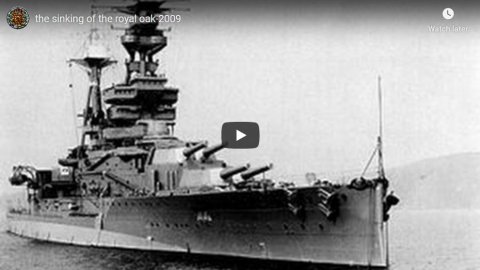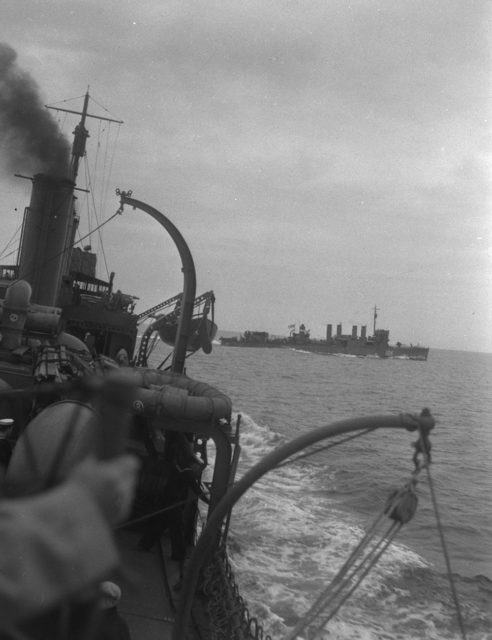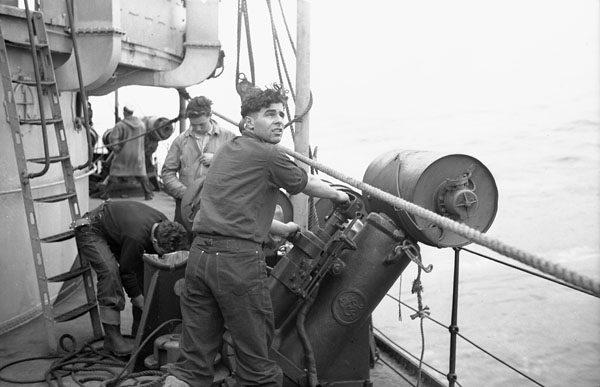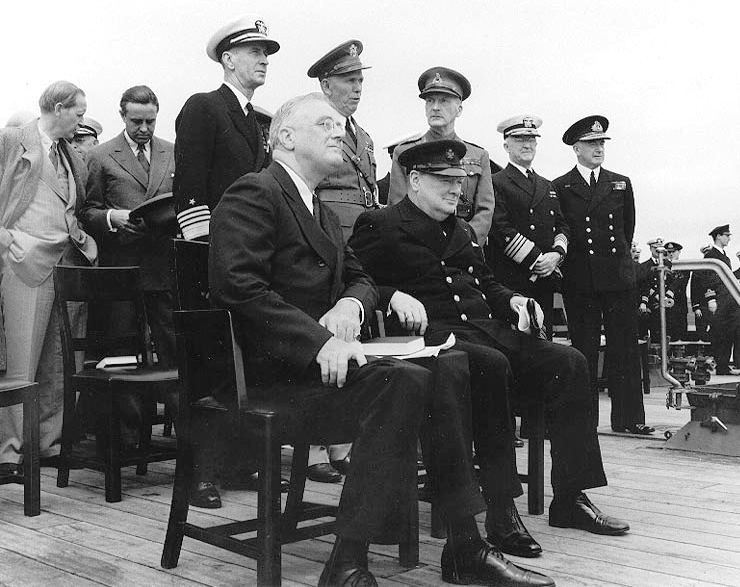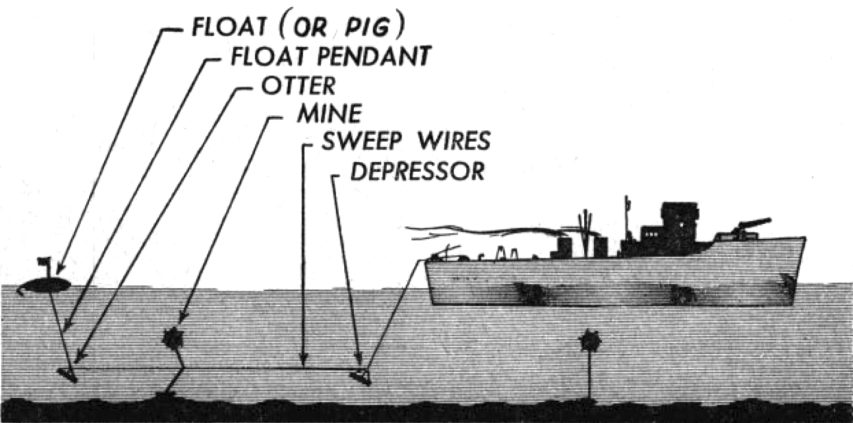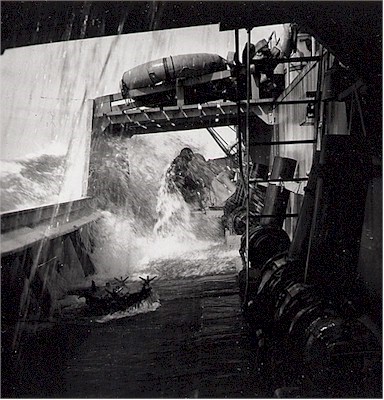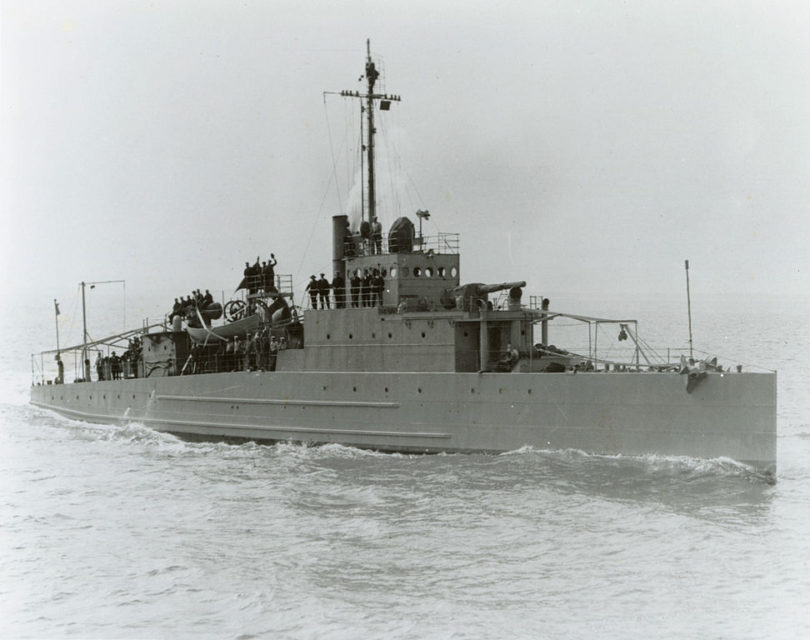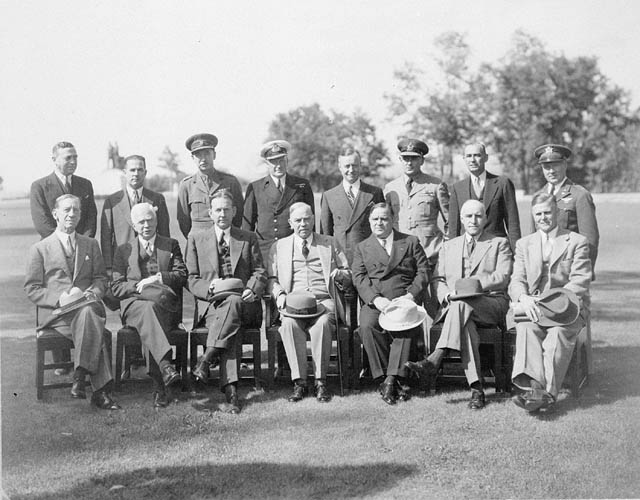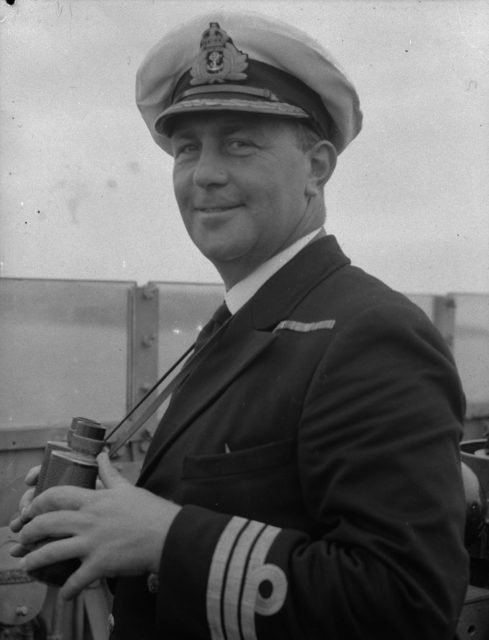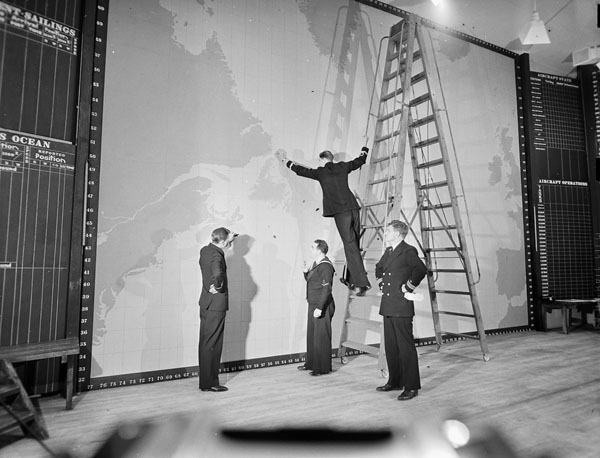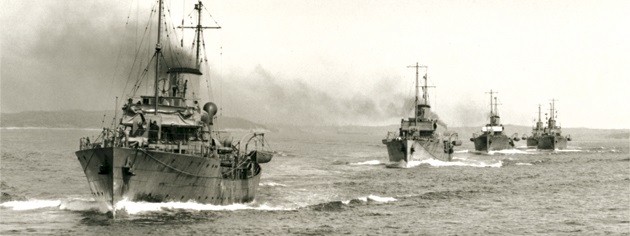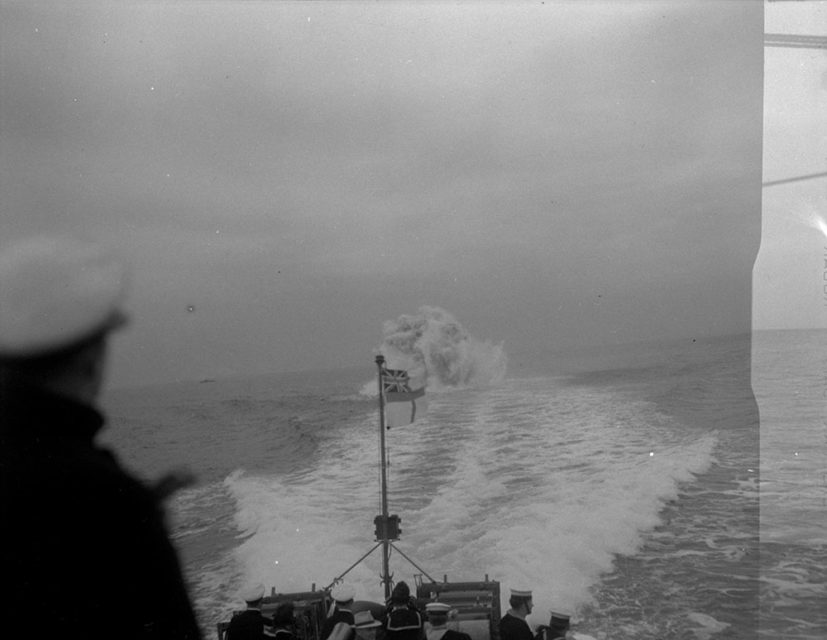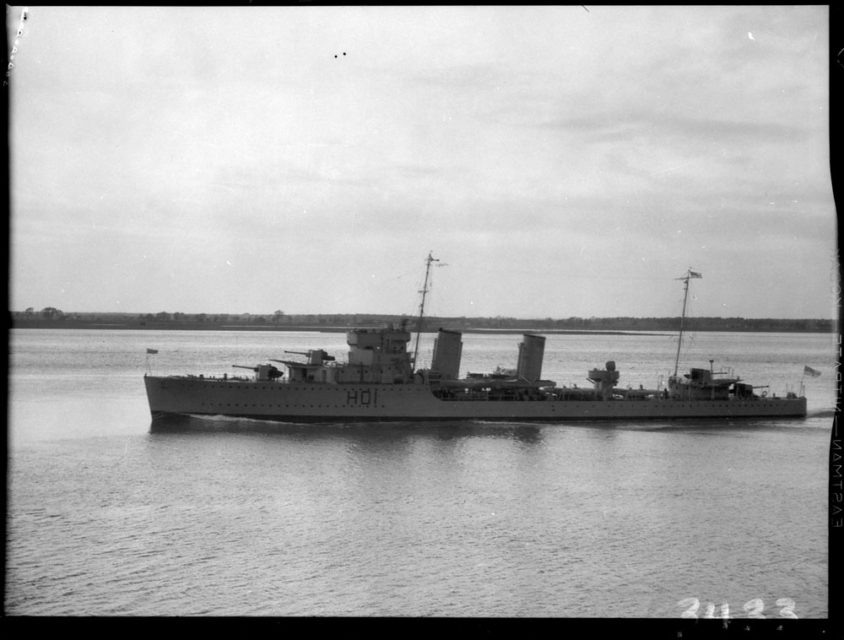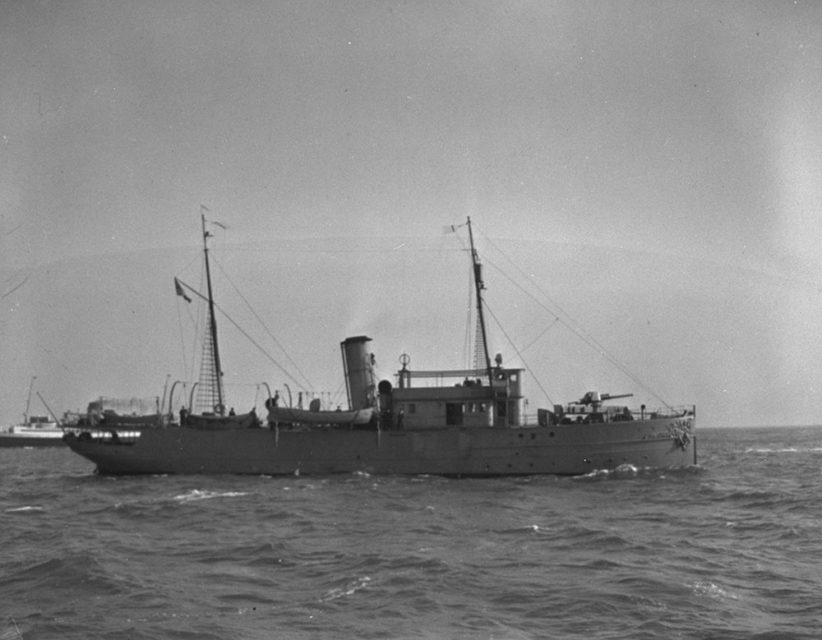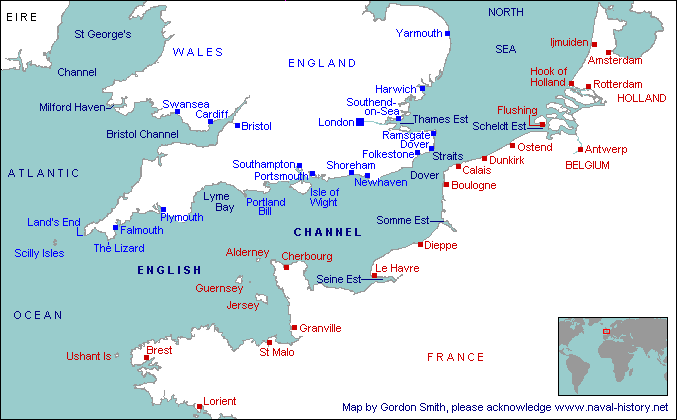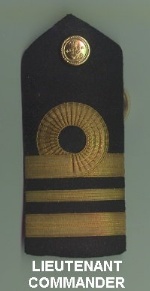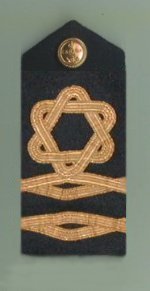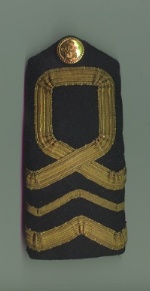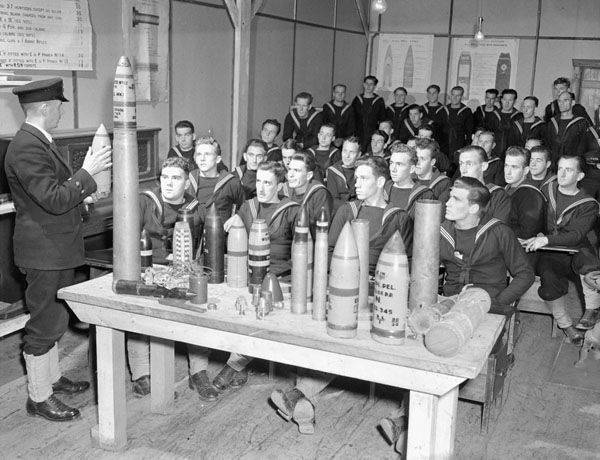Eoin MacFreeman
Published 19 Sep 2014STV and History channel documentary to coincide with the 70th anniversary of the sinking of HMS Royal Oak at Scapa Flow in Scotland. With harrowing eye witness accounts from survivors. Narrated by oor Alex Norton. We will remember them.
On 14 October 1939, Royal Oak was anchored at Scapa Flow in the Orkney Islands, Scotland, when she was torpedoed by the German submarine U-47. Of Royal Oak‘s complement of 1,234 men and boys, 833 were killed that night or died later of their wounds. The loss of the old ship – the first of the five Royal Navy battleships and battlecruisers sunk in the Second World War – did little to affect the numerical superiority enjoyed by the British navy and its allies, but the sinking had considerable effect on wartime morale. The raid made an immediate celebrity and war hero out of the U-boat commander, Günther Prien, who became the first German submarine officer to be awarded the Knight’s Cross of the Iron Cross. Before the sinking of Royal Oak, the Royal Navy had considered the naval base at Scapa Flow impregnable to submarine attack, and U-47‘s raid demonstrated that the German navy was capable of bringing the war to British home waters. The shock resulted in rapid changes to dockland security and the construction of the Churchill Barriers around Scapa Flow.
November 20, 2019
The Sinking of the Royal Oak
August 19, 2019
QotD: Hitler’s “wonder weapons”
Historians have generally thought of the Type XXI [submarine] — along with other systems like the Me 262, V-1 and V-2 rockets, and the Tiger tank — as an example of Wunderwaffen, wonder weapons. Since 1945 many have fixated on the revolutionary military technologies that the Third Reich developed in the last two years of the war. The cultural impetus behind the concept, as implicitly or explicitly acknowledged by historians in the uneven and largely enthusiastic literature on the subject, was an irrational faith in technology to prevail in operationally or strategically complex and desperate situations — a conviction amounting to a disease, to which many in the Third Reich were prone in the latter years of the Second World War. To the extent that it shaped decision making, faith in the Wunderwaffen was a special, superficial kind of technological determinism, a confidence in the power of technology to prevail over the country’s strategic, operational, and doctrinal shortcomings. To the extent that leaders, officers, engineers, and scientists after 1943 believed innovation to be the answer to Germany’s strategic dilemmas, they displayed a naive ignorance of how technology interacts with cultural and other factors to influence the course of events. In particular, they reflected a willful ignorance of the extent to which even substantial technological superiority has proved indecisive in human conflict throughout history.
Marcus Jones, “Innovation For Its Own Sake: The Type XXI U-boat”, Naval War College Review, 2014-04.
June 25, 2019
Plan Z, or How Not to Prepare for The Battle of the Atlantic
Historigraph
Published on 24 Jun 2019Join us in #WarThunder for free using this link and get a premium tank or aircraft and three days of premium time as a bonus: https://gjn.link/Historigraph/190624
If you enjoyed this video and want to see more made, consider supporting my efforts on Patreon: https://www.patreon.com/historigraph
To chat history, join my discord: https://discord.gg/vAFTK2D
#WarThunder #PlanZ #Historigraph
Sources:
Jonathan Dimbleby, The Battle of the Atlantic
Jak P. Mallmann Showell, German Navy Handbook 1939-45
Empire of the Deep, Ben Wilson
Philips Payson O’Brien, How the War was Won
Corelli Barnett, Engage the Enemy More Closely
The Encyclopedia of Sea Warfare
Music:
Crypto, Incompetech https://incompetech.comStormfront, Incompetech https://incompetech.com
April 21, 2019
Canada and the Battle of the Atlantic, part 13
Editor’s Note: This series was originally published by Alex Funk on the TimeGhostArmy forums (original URL – https://community.timeghost.tv/t/canada-and-the-battle-of-the-atlantic-part-5-edited/1453).
This will be the last installment I’ll be re-posting here, as discussion with Alex after I obtained a copy of Marc Milner’s North Atlantic Run made it clear that the bulk of the writing up until this point had actually been copied directly from Milner’s book and only lightly paraphrased and re-ordered by Alex. I’ve gone back over the earlier posts and, to the best of my ability, marked all the direct quotes and provided acknowledgements appropriately.
Sources:
- Far Distant Ships, Joseph Schull, ISBN 10 0773721606 (An official operational account published in 1950, somewhat sensationalist)
[Schull’s book was published in part because the funding for the official history team had been cut and they did not feel that the RCN’s contribution to the Battle of the Atlantic should have no official recognition. It is very much an artifact of its era, and needs to be read that way. A more balanced (and weighty) history didn’t appear until the publication of No Higher Purpose and A Blue Water Navy in 2002, parts 1 and 2 of the Official Operational History of the RCN in WW2, covering 1939-1943 and 1943-1945, respectively.]- North Atlantic Run: the Royal Canadian Navy and the battle for the convoys, Marc Milner, ISBN 10 0802025447 (Written in an attempt to give a more strategic view of Canada’s contribution than Schull’s work, published 1985)
- Reader’s Digest: The Canadians At War: Volumes 1 & 2 ISBN 10 0888501617 (A compilation of articles ranging from personal stories to overviews of Canadian involvement in a particular campaign. Contains excerpts from a number of more obscure Canadian books written after the war, published 1969)
- All photos are in the Public Domain and are from the National Archives of Canada, unless otherwise noted in the caption.
I have inserted occasional comments in [square brackets] and links to other sources that do not appear in the original posts. A few minor edits have also been made for clarity.
Earlier parts of this series:
Part 1 — Canada’s navy before WW2
Part 2 — The Admiralty takes control
Part 3 — The professionals and the amateurs
Part 4 — 1940: The fall of France, the battle begins, and the RCN dreams of expansion
Part 5 — The RCN’s desperate need for warships
Part 6 — New ships, new challenges
Part 8 — Expansion problems: not enough men for not enough ships
Part 9 — Early-to-mid 1941, The Rocky Isle in the Ocean
Part 10 — The Newfoundland Escort Force and the Canadian corvettes
Part 11 — “Chummy” Prentice and the NEF
Part 12 — Staff needed, training needed, and Commodore Murray’s thankless tasks
Part 13 — Convoy operations, the Americans, and 1941 Drags On
Marc Milner discusses convoy organization in North Atlantic Run:
The organization and sailing of convoys was co-ordinated by the Admiralty’s world-wide intelligence network, of which Ottawa was the North American centre. The assembling of shipping in convoy ports was the responsibility of local NCS staffs working in conjunction with the regional intelligence centre, through which all communication with other regional centres passed. The actual organization of the convoys, issuing code books, charts, special publications, arrangement of pre-sailing conferences, passing out sailing orders, and so forth, was all the work of the NCS.
[Editor’s Note: The command structure for typical Atlantic convoys is discussed in Arnold Hague’s excellent reference work The Allied Convoy System 1939-1945: Its organization, defence and operation:
In typical British fashion, control of the convoy was twofold. Direct control of the convoy rested with the Convoy Commodore, its protection with the Senior Officer of the Escort (referred to in the RN as SOE). As the escort commander was inevitably junior to the Commodore, it was laid down that the Commodore had no right of intervention with the escort, and that the SOE could, if he became aware of circumstances requiring it, give a mandatory instruction to the Commodore. A good deal of tolerance and understanding between the two officers was therefore essential. In fact, friction was minimal, co-operation normally of a high order and the whole system remarkably effective, with the Commodore dealing solely with the merchant ships of the convoy. The SOE intervened (or detailed another escort) at the specific request of the Commodore to provide any assistance required in controlling the convoy.
The divided command system should be seen in the context of the experience of the two commanders. The Commodores, all elderly men, had practical, personal, experience of the problems of coal fired ships from their younger days. As almost all had started their Commodore’s service in the first months of the war they had considerable personal experience of the problems of the Masters whom they led. The escort commanders, much younger officers, lacked that personal knowledge, and the opportunity to obtain it. The system worked in practice, with only rare cases of a personality clash between Commodore and SOE or Commodore and ships’ Masters. In such instances, the Admiralty could exercise its prerogative of dispensing with a Commodore’s services, or appointing him elsewhere. In the only case known to the writer, the offending Commodore, described as “an intolerant personality who greatly upset the Masters of ships in the convoy,” was appointed elsewhere after a short interval. He served the next five years in a single, vital appointment with distinction and great efficiency and, as the Commodore commanding the working-up base at Tobermory in Western Scotland, he was responsible for the training of all newly built or re-commissioned British escort vessels during 1940-45. Indeed not a few RCN and Allied escorts also passed through his hands. He contributed to a very large extent indeed to the efficiency of such escorts and his name became wiedly known and one to respect and admire. His name? Vice-Admiral Sir Gilbert O. Stephenson, also known as the “Terror of Tobermory”.
[…]
Convoy Commodores were drawn from a list of volunteers to serve either with Ocean or Coastal convoys. For the former, the choice was made from retired Flag Officers and Captains of the Royal Navy who were appointed as Commmodores 2nd Class in the Royal Naval Reserve for the period of their duty. … Almost every Commodore was aged over sixty when the commenced his appointment, some older, and their retired ranks varied from Admiral to Lieutenant-Commander. … Commodores for the North Atlantic routes were drawn from a pool of less than 200 who served almost exclusively in that ocean. … Russian convoys drew their Commodores from the North Atlantic pool. Convoy systems organized by the Royal Australian and Royal Canadian Navies, principally coastal, were provided with Commodores appointed by those Services.
All Commodores had the right to request reversion to non-active service at any time, while the Admiralty retained the right (and occasionally exercised it) to retire a Commodore from service.
Commodores were assisted in their duties by a Vice-Commodore and, on occasions, by one or more Rear-Commodores. A Vice-Commodore could be either a Commodore RNR from the pool serving as an assistant or the Commodore of another convoy that had joined at sea. … In all other instances the Vice- and Rear-Commodores were Masters of ships in the appropriate convoy. Their duty was to assist the Commodore and to assume his duties should he be lost during the convoy.
Commodores were accompanied by a staff: a Yeoman of Signals (a Petty Officer of the Communications Branch), three Convoy Signalmen and usually a Telegraphist. They carried considerable responsibility and were, without exception, highly efficient visual signallers. It was also usual to provide the Vice-Commodore with two Convoy Signalmen to assist him in his duties.
In large trans-Atlantic convoys the commodore sailed front and centre, usually in a large ship which was well appointed for visual and wireless communications with the rest of the convoy and equipped for direct wireless communication with shore authorities. The commodore was also the crucial link between the convoy and its escort. Although the escort commander was ultimately responsible for the safe and timely arrival of the convoy, in practice he and the commodore worked as a team. The vice- and rear-commodores, where needed, were stationed in stern positions on the outer columns of the convoy. Each had his own small staff, largely signallers. Interestingly, the majority of convoy signallers in the North Atlantic by 1941 were RCN.
Marc Milner outlines convoy routing in North Atlantic Run:
Once the convoy cleared the outer defences of the harbour, it became the responsibility of the escort forces. Its routing, however, was laid down prior to sailing by the RN’s Trade Division (shared with the USN after the American entry into the war), which prescribed a series of points of longitude and latitude through which the convoy was to pass. Minor tactical deviations within a narrow band along the convoy’s main line of advance were permitted the SOE, but major alterations of course remained the prerogative of shore authorities. The ideal routing, one towards wich the Allies moved much more slowly than they would have liked, was one simple “tramline” along the most direct course between North America and Britain — the great circle route. For a number of reasons tramlines were not feasible until 1943. For the greater portion of the period covered by this study the object of routing remained simple avoidance of the enemy, within the limits of air and sea escorts.
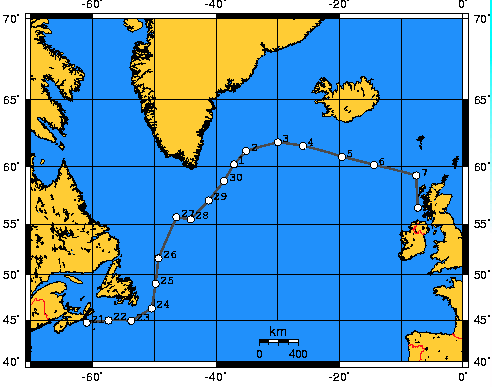
Convoy chart for convoy HX-134, departed on 20 June, 1941, arrived in Liverpool 9 July, 1941.
Image from the Convoy Web Convoy Charts page – http://www.convoyweb.org.uk/extras/index.html
The fast and slow convoy system had undergone some changes by mid-1941. Fast convoys from Halifax were still faster than 9 knots, but ships capable of moving faster than 14.8 knots were routed independently now. Slow convoys from Sydney, Cape Breton were ships capable of speeds between 7.5 and 8.9 knots. Their slow speed drew together a decrepit class of aged tramps, and there was initially no plan to convoy them through the winter. It soon became clear to the staff that all merchant shipping below a certain speed needed to be convoyed, otherwise the loss rate was far too high. For the ships and crews of the escort groups it was a thankless task: slow convoys were notorious for ill-discipline and inattention to signals. The older, slower ships were prone to excessive smoke (endangering the whole convoy by making easier to detect at a distance), breaking down, straggling (falling behind the convoy, beyond the protective screen of escorts sometimes to the point of losing contact with the convoy altogether), or even sailing ahead of the convoy “if stokers happened upon a better-than-average bunker of coal”. Slow convoys were said to more often resemble a mob than an orderly assemblage of ships, and their slow speed made evasive action difficult, if not impossible.
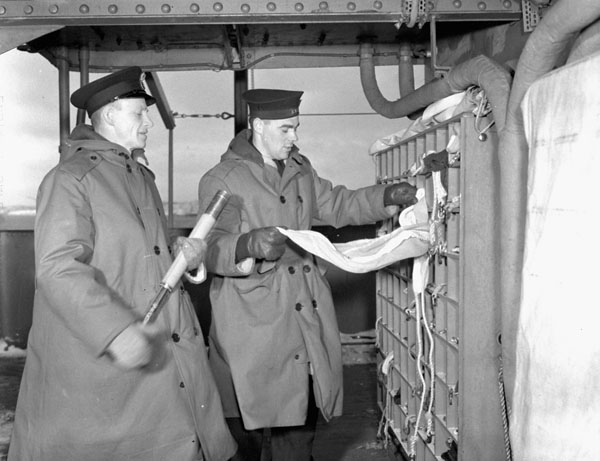
Unidentified signals personnel at the flag locker of the armed merchant cruiser HMCS Prince David in Halifax, Nova Scotia, January 1941.
Canada. Dept. of National Defence / Library and Archives Canada / PA-104500
Marc Milner, North Atlantic Run:
By the time [Commodore] Murray arrived to take command of NEF it had grown to seven RN and six RCN destroyers, four RN sloops, and twenty-one corvettes, all but four of them RCN. The Admiralty would have liked even more committed to NEF. Indeed, in early July the Admiralty proposed to NSHQ that Halifax be virtually abandoned as an operational base and that the RCN’s main effort be concentrated at St John’s. Naval Service HQ might have expected grander British plans for St John’s when the Admiralty recommended that Commodore Murray command NEF instead of the RCN’s initial choice, Commander Mainguy. For practical reasons, however, concentrating the entire fleet at St John’s was impossible. In the summer of 1941 there were not enough facilities to support NEF, let alone the RCN’s whole expansion program, and it would be a long time before this situation was reversed. The Naval Council did not debate long before the idea was dismissed as impractical. None the less, subtle British pressure to increase the RCN’s commitment to St John’s was continued, in large part because the RN wanted to eliminate its involvement in escort operations in the Western Atlantic. In August, for example, the Admiralty advised the RCN that it preferred to deal with only one operational authority in the Western Atlantic, CCNF. The pressure, in combination with a serious German assault on convoys in NEF’s area by the late summer, proved successful. Despite growing USN involvement in convoy operations in the Western Atlantic, fully three-quarters of the RCN’s disposable strength was assigned to NEF by the end of the year. In spring of 1941, however, the RCN was unprepared to make such large-scale commitments.
One week after Murray assumed his post as CCNF, NEF fought its first convoy battle. Ironically, the confrontation was brought about by the increasing effectiveness of Allied convoy routing as a result of the penetration of the U-boat ciphers in May. Excellent evasive routing so reduced the incidence of interception that the U-boat command, out of frustration, broke up its patrol lines and scattered U-boats in loose formation. This made accurate plotting by Allied intelligence much more difficult and consequently made evasive routing less precise.
The first action against enemy submarines for the NEF occurred on the 23rd of June, 1941. Convoy HX-133 comprised fifty-eight ships eastbound from Halifax escorted by the destroyer HMCS Ottawa (SOE, Captain E.R. Mainguy) and the corvettes, HMCS Chambly, Collingwood, and Orillia. At some point during the day, the convoy was sighted by U-203, which communicated the convoy position to U-boat command and continued to shadow from a distance. U-203 attacked on the night of 23-24 June, easily penetrating the thin screen of escorts to sink a merchant ship. The SOE found it impossible to co-ordinate the escorts’ defence or to direct any search for the submarine because the corvettes were not fitted with radio telephones and their wireless sets were unable to reliably stay in communication with the SOE. Only Chambly logged receiving signals from Ottawa, but only half of them. On the 26th, Ottawa established an ASDIC contact and attacked and two of the corvettes came to assist, Commander Mainguy instructed the corvettes to stay and keep the U-boat submerged while the destroyer re-joined the convoy. The message, sent by message light, was only partially received, and the corvettes could not get the message repeated. Unable to determine what the order was, both ships broke off the action and returned to the convoy in turn. The escort group was eventually reinforced by RN ships, and although HX-133 lost six merchantmen, the RN escorts sank two of the attacking U-boats. These Canadian problems were lamentable, but hardly unexpected. As Joseph Schull, the RCN’s official historian, concluded, “no one could have expected it to be otherwise”.
Marc Milner picks up the story in North Atlantic Run:
In the meantime, Captain (D), Greenock’s stern criticism of the Canadian corvettes found its way to NSHQ, accompanied by a covering letter from Captain C.R.H. Taylor, RCN, who had succeeded Murray in London as CCCS. Taylor noted that the poor state of readiness of the corvettes stemmed from the fact that they were manned and stored for passage only. Deficiencies could not be made up from the RCN’s UK manning pool since most of the men who were committed to it were in fact still aboard the ships. Taylor also noted that the poor quality of officers, especially COs, had been pointed out in April and that they would never have been assigned if the ships had commissioned permanently. It was heartening to note, however, that Hepatica, Trillium, and Windflower, through remedial work and extra effort, were worked up “to a state of efficiency which the Commodore Western Isles reported as surpassing many RN corvettes”.
View of HMCS Annapolis from HMCS Hamilton, 30 August, 1941.
Canada. Dept. of National Defence/Library and Archives Canada/PA-104149Naval Service HQ was therefore well braced when a follow-up letter from the Admiralty arrived several days later. The letter took a conciliatory view of Canadian difficulties, noting that these seemed to be “essentially similar to those occasionally experienced with the RN corvettes and trawlers”. To overcome these the Admiralty advised of three means employed by the RN. If the officers and men were competent and responsive, simply prolonging the length of work-up usually sufficed. If the officers were incompetent or otherwise unsatisfactory, they could be replaced by new ones drawn from a manning pool. Similarly, inefficient or unsuitable key ratings could be replaced by men drawn from a pool maintained for this purpose. In its concluding remarks the letter cautioned that corvettes commissioning and working up in Canada were likely to display a wide variation in efficiency, and warned that at this point, with ships stretched to provide continuous A/S escort in the North Atlantic, “no reduction in individual efficiency can be safely accepted”. This was true enough, but it contradicted what the Admiralty had said to the RCN in April, when the issue of manning the ten “British” corvettes had been resolved.
While the Admiralty clearly felt that it was offering the RCN a workable set of solutions, the suggestions contained few alternatives for the Canadians. In sum, the RCN was hard pressed just to find men with enough basic training in order to get the corvettes to sea. Producing a surplus of specialists — of any kind — was out of the question. Nelles, in his draft reply to the Admiralty, pointed out that all experienced officers and men were already committed either to new ships or to the new RCN work-up establishment, HMCS Sambro, at Halifax. Future prospects looked equally grim. Spare HSD ratings (the highest level of ASDIC operator, of which there was to be one per corvette) would not be available until the spring of 1942, a prognosis even Nelles considered optimistic. And no trained RCN commanding officers or first lieutenants could be spared for some time to come. In short, a pool of qualified and disposable personnel was out of the question. If the RN wanted to loan experienced personnel until they could be replaced by the RCN, such help would be “greatly appreciated”. The only other options were prolonged work-ups or some form of ongoing training. Aside from that, Canadian escorts had to make do. RCN escorts sent to work up at Tobermory through 1941 continued to arrive in an unready state, though here is no indication that these were any worse off than corvettes retained for work-up in Canada. The state of ships arriving in Tobermory not only resulted in “much excellent training [being] lost”; it did little to enhance the RCN’s already tattered image within the parent service.
[Editor’s Note: The training at Tobermory really was both intense and nerve-wracking for RN and RCN crews alike, as James Lamb recounts in The Corvette Navy:]
… the really soul-testing experience, the one that every old corvette type still recalls today with a shudder, came with the two-week work-ups for newly commissioned ships, designed to make a collection of odds and sods into an efficient ship’s company. There were such bases at Bermuda, St. Margaret’s Bay, and Pictou on the Canadian side, but the one that really left a lot of scar tissue was the old original, the Dante’s Inferno operated at Tobermory on the northwest coast of Scotland by the redoubtable Vice-Admiral Gilbert Stephenson, Royal Navy. This legendary character, variously known as “Puggy”, “The Lord of the Isles”, or more commonly “The Old Bastard”, inhabited a former passenger steamer, The Western Isles, which lay at anchor in the quiet, picturesque harbour, surrounded by a handful of newly commissioned corvettes, like a spider surrounded by the empty husks of its victims. He was a daunting sight, smothered in gold lace and brass buttons, with a piercing blue eye that could open an oyster at thirty paces, and tufts of grey hair sprouting from craggy cheeks, and he preyed like some ravening dragon upon the callow crews and shaky officers served up to him at fortnightly intervals.
At the end of each day, an exhausted crew would tumble into their hammocks, but there was no assurance of uninterrupted slumber. On the contrary; the monster stalked its unwary prety by dark as well as by light, and seldom a night passed without an alarm of some sort. For the Admiral delighted in midnight forays; more than one commanding officer was shaken awake to find himslef staring into the piercing eyes of a malevolent Admiral and learn that his gangway had been left unportected, that his ship had been taken, and that his kingdom had been given over to the Medes and the Persians.
But occasionally — just occasionally — the ships got a little of their own back. There was the occasion when the Admiral in his barge, lurking soundlessly under the fo’c’sle of what he hoped to be an unsuspecting frigate, waiting for the sailor whom he could hear humming to himself on the deck above to move on, suddenly found himself being urinated on, “from a great height”, as gleeful narrators related the story in a hundred rapturous wardrooms. There was the other frigate he boarded one dark night only to be set upon by a ferocious Alsatian dog and fored to leap back into his boat, leaving, in the best comic-strip tradition, a portion of his trouser-seat aboard the ship, which ever after displayed the tattered remains as a proud trophy, suitably mounted and inscribed.
And there was the Canadian corvette sailor who worsted the fiery Admiral in a hand-to-hand duel. Coming aboard this ship, the Admiral suddenly removed this cap and flung it on the deck, shouting to the astounded quartermaster: “That’s an unexploded bomb; take action, quickly now!”
With surprising sang-froid, the youngster kicked the cap over the side. “Quick thinking!” commended the Admiral. Then, pointing to the slowly sinking cap, heavy with gold lace, the Admiral continued: “That’s a man overboard; jump to it and save him!”
The ashen-faced matelot took one look at the icy November sea, then turned and shouted: “Man overboard! Away lifeboat’s crew!”
The look on the Admiral’s face, as he watched his expensive Gieves cap slowly disappear into the depths while a cursing, fumbling crew attempted to get a boat ready for lowering, was balm to the souls of all who saw it.
Marc Milner, North Atlantic Run:
Although reports from both sides of the Atlantic indicated that the expansion fleet was badly in need of training and direction, its future looked bright in the summer of 1941. Corvettes operating from Sydney and Halifax as part of the Canadian local escort held up remarkably well to operations in the calmer months. A sampling of escorts based at Sydney in the months of August and September reveals startling statistics on the small amount of sea and out-of-service time logged by the new ships. Considerably less than half of their days were spent at sea, and this represented only about 56 percent of their seaworthy time. With so much time alongside, ships’ companies were able to keep up with teething problems. In the ships in question all time out of service was devoted to boiler cleaning. … Later, as operations crowded available time and spare hands crowded the mess decks to provide extra watches for longer voyages, the shorter period became routine. But it is significant that until the fall of 1941 the corvette fleet enjoyed considerable slack, in which it could make good its defects.
The easy routine extended to NEF as well and offered an opportunity to improve on the operational efficiency of escorts already committed to convoy duties. “As the force is now organized,” Captain E.B.K. Stevens, RN, Captain (D), Newfoundland, wrote in early September, “there is ample time for training ships, having due regard for necessary rest periods between convoy cycles.” It would be a year and a half, or more, before the same could be said again. Moreover, when the Canadian escorts did have slack time, the dearth of training equipment at St John’s was, as Stevens reported, “a beggar’s portion”; one wholly inadequate target borrowed from the United States Army and one MTU (mobile A/S training unit) bus suitable for training destroyers (although corvette crews could be and were trained on it).
Personnel preparing to fire depth charges as the destroyer HMCS Saguenay attacks a submarine contact at sea, 30 October 1941.
Canada. Dept. of National Defence / Library and Archives Canada / PA-204329Captain (D)’s concern for the languishing advance to full efficiency arose from recent gunnery exercises off St John’s. “It is noticeable,” NEF’s gunnery officer reported, “that everyone from the First Lt., who is Gunnery Control Officer, downwards put their fingers to their ears each time the gun fired.” Not surprisingly, this prevented the ship’s gunnery officer from observing the fall of the shot, since he could not possibly use his glasses with his hands thus employed. In addition, some of the guns crews were startled by the firing, and all of this contributed to a deplorable rate of three rounds per minute. Captain (D) drily concluded that “At present most escorts are equipped with one weapon of approximate precision, the ram.” And so it remained for quite some time.
What NEF really needed, of course, was a proper training staff, hard and fast minimum standards for efficiency, the will to adhere to them, and improved training equipment. A tame submarine would have been a distinct advantage, but by the time L27, the submarine assigned to NEF by Western Approaches Command, arrived from Britain later in the fall, there was no time set aside for training. Throughout 1941 only hesitant and largely unsuccessful attempts were made to rectify this situation. In August, Prentice obtained permission from Murray to establish a training group for newly commissioned ships arriving from Halifax. The crews of these were found to be totally “inexperienced and almost completely untrained”. Unfortunately, as with other such attempts, Prentice’s first training group was stillborn because of increased operational demands at the end of the summer. So long as the training establishment at Halifax produced warships of such questionable quality, operations in the mid-ocean suffered, and it would be some time before the home establishments switched their emphasis from quantity to quality.
Relief for the struggling escorts of NEF was in the offing from two directions as summer gave way to autumn. By the end of August 1941 nearly fifty new corvettes were in commission, including those taken over from the RN. More were ready, at the rate of five to six per month, before the end of the year. With the men, the ships, and a little time and experience, the nightmare of jamming two years of expansion into one would be ended. This optimistic view was enhanced by the increased involvement of the USN in NEF’s theatre of operations and by the prospect that many of its responsibilities would be passed to the Americans.
The Americans had hardly been passive bystanders in the unfolding battle for the North Atlantic communications. The westward expansion of the war threatened to bring an essentially European conflict to the Western Hemisphere. Certainly, it disrupted normal trade patterns. With the establishment of American bases in Newfoundland in late 1940 that island became for the US what it was already for Canada — the first bastion of North American defence. But neither the US president, Franklin D. Roosevelt, nor American service chiefs were content to rest on the Monroe Doctrine. Moreover, aside from the purely defensive character of US involvement in Newfoundland, the Americans made an enormous moral, financial, and industrial commitment to the free movement of trade to Britain with the announcement of Lend-Lease in March 1941. A natural corollary to lend-lease was what Churchill called “constructive non-belligerency”, the American protection of US trade with Britain. While Britain would clearly have liked a more rapid involvement of the US in the Atlantic battle, American public opinion would only stand so much manipulation. Therefore, it was not until August that Roosevelt felt confident enough to meet Churchill and work out the details of American participation in the defence of shipping.
Conference leaders during Church services on the after deck of HMS Prince of Wales, in Placentia Bay, Newfoundland, during the Atlantic Charter Conference. President Franklin D. Roosevelt (left) and Prime Minister Winston Churchill are seated in the foreground. Standing directly behind them are Admiral Ernest J. King, USN; General George C. Marshall, U.S. Army; General Sir John Dill, British Army; Admiral Harold R. Stark, USN; and Admiral Sir Dudley Pound, RN. At far left is Harry Hopkins, talking with W. Averell Harriman.
US Naval Historical Center Photograph #: NH 67209 via Wikimedia Commons.A great deal has been written about Roosevelt’s and Churchill’s historic meeting at Argentia, Newfoundland, in August 1941. Here it is only important to note how the agreements directly affected the conduct and planning of RCN operations in the North Atlantic. The British and Americans decided, without consultation with Canada, that strategic direction and control of the Western Atlantic would pass to the US as per ABC 1. Convoy-escort operations west of MOMP became the responsibility of the USN’s Support Force (soon redesignated Task Force Four), with its advanced base at Argentia, Newfoundland.
April 12, 2019
Canada and the Battle of the Atlantic, part 10 by Alex Funk
Editor’s Note: This series was originally published by Alex Funk on the TimeGhostArmy forums (original URL – https://community.timeghost.tv/t/canada-and-the-battle-of-the-atlantic-part-4/1447/3).
Sources:
- Far Distant Ships, Joseph Schull, ISBN 10 0773721606 (An official operational account published in 1950, somewhat sensationalist)
[Schull’s book was published in part because the funding for the official history team had been cut and they did not feel that the RCN’s contribution to the Battle of the Atlantic should have no official recognition. It is very much an artifact of its era, and needs to be read that way. A more balanced (and weighty) history didn’t appear until the publication of No Higher Purpose and A Blue Water Navy in 2002, parts 1 and 2 of the Official Operational History of the RCN in WW2, covering 1939-1943 and 1943-1945, respectively.]- North Atlantic Run: the Royal Canadian Navy and the battle for the convoys, Marc Milner, ISBN 10 0802025447 (Written in an attempt to give a more strategic view of Canada’s contribution than Schull’s work, published 1985)
- Reader’s Digest: The Canadians At War: Volumes 1 & 2 ISBN 10 0888501617 (A compilation of articles ranging from personal stories to overviews of Canadian involvement in a particular campaign. Contains excerpts from a number of more obscure Canadian books written after the war, published 1969)
- All photos used exist in the Public Domain and are from the National Archives of Canada, unless otherwise noted in the caption.
I have inserted occasional comments in [square brackets] and links to other sources that do not appear in the original posts. A few minor edits have also been made for clarity.
Earlier parts of this series:
Part 1 — Canada’s navy before WW2
Part 2 — The Admiralty takes control
Part 3 — The professionals and the amateurs
Part 4 — 1940: The fall of France, the battle begins, and the RCN dreams of expansion
Part 5 — The RCN’s desperate need for warships
Part 6 — New ships, new challenges
Part 8 — Expansion problems: not enough men for not enough ships
Part 9 — Early-to-mid 1941, The Rocky Isle in the Ocean
Part 10 — The Newfoundland Escort Force and the Canadian corvettes
Returning to the corvettes themselves for a moment, while I have already spoken of the diversity of the modifications that they would receive [in Part 7], it is important to discuss the modifications that Canadians gave to their own corvettes in comparison to those made to Royal Navy ships. The RN used its corvettes for ocean escort and had begun to implement some of the modification to individual ships of the class to make the vessels more suitable for work on the open sea. The lengthened forecastle increased available crew space (required as ships’ crews were augmented with extra ratings for the newer equipment being fitted) and helped to make the ships’ interior spaces significantly drier. The bows were also strengthened to take the pounding of the heavy seas typically encountered in the North Atlantic. The first Canadian-built corvettes could have been delayed in order to incorporate these changes while still in the builders’ hands, but the shortage of ships meant that they went ahead largely as originally planned. The major Canadian alteration of the original design reflected the corvettes’ intended coastal operational role: minesweeping gear. The alterations to the original design, involving modification of the quarter-deck, cutting back the engine-room casing to accommodate a steam winch, broadening the stern to fit both the minesweeping wires and the depth charge rails, and the extra storage for the minesweeping gear when not in use, had already delayed the delivery of the ships to the navy.
[Editor’s Note: Minesweeping, while not the primary intended role for the Flower-class corvettes (especially without gyrocompasses!), was a viable alternate task. Here’s a post-war diagram of how WW2 minesweeping was done (from History on the Net‘s Minesweepers of WW2 page)]:
[Minesweeper-equipped ships would] “sweep” anchored mines by cutting their mooring ropes or chains, permitting the mines to float to the surface where they could be destroyed by gunfire.
Magnetically activated “influence” mines were defeated with a strong electrical current passed through a loop of cable, neutralizing the detonator. Acoustic mines, which responded to the noise of a ship’s engines and propellers, were prematurely detonated by underwater noisemakers operating on suitable harmonic frequencies.
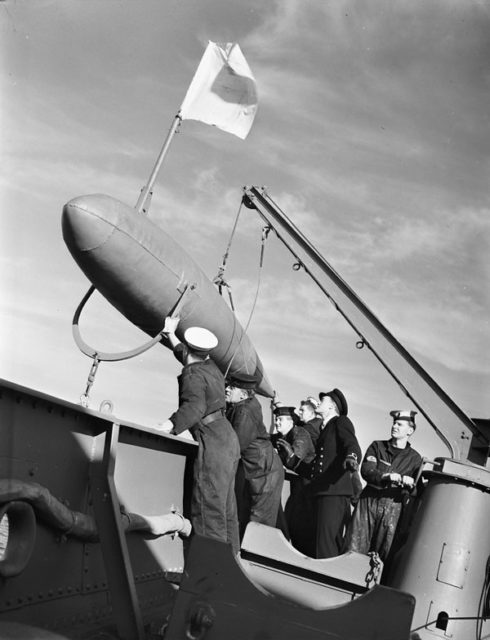
RCN personnel preparing to launch a minesweeping float from HMCS Alberni off the coast of British Columbia, March 1941.
Canada. Dept. of National Defence / Library and Archives Canada / PA-179942
Marc Milner, North Atlantic Run:
All of this delayed completion and may have hardened the Staff to any further delays occasioned by major alterations. Moreover, that the Naval Staff was not unduly concerned about the A/S performance of the corvettes is evidenced by the fact that the addition of a full minesweeping kit “had an adverse effect on the operations of the A/S gear”. The latter, as the Staff went on to observe, was carried forward and was affected by the corvette’s tendency to trim by the stern when fitted for minesweeping. In practice, however, the original corvette design, when fully stored and armed, tended to trim by the bows, which also affected A/S efficiency. The addition of extra weight in the stern may unwittingly have compensated for the design fault.
More important in terms of sea-keeping and habitability in deep-sea operations was the extension of the foc’sle. News of this major alteration reached NSHQ while most of the vessels of the first program were still in the builders’ hands. Although the RCN would make allowances for more crewmen, better refrigeration, a more powerful wireless set, and more depth charges — all indications that corvettes were expected to go farther afield and stay longer — the navy did not act on this fundamental alteration in basic structure of its first sixty corvettes. However, the Staff did recognize the value of the design improvements. … In the meantime, the RCN plodded along with escorts which, as late as the end of 1940, the navy still considered inshore auxiliaries. In any event, corvettes were still tied closely to the defended-port system under the terms of Plan Black. It is also arguable that the Staff’s failure to extend the foc’sles of corvettes when it had the chance stemmed from the navy’s need of ships to permit expansion really to begin, or from the increasing gravity of the war at sea. Whatever the case, it was a lost opportunity that would come to haunt the navy.
The forecastle extension (or lack thereof) would come to be the norm for the RCN and NSHQ: certain trivial modifications seemingly at random, major ones delayed exponentially. The after gun platform (for the Pom-Pom) was moved further to the rear of the ship so that it was not in danger of blowing away the mainmast, and would remain further to the rear long after the secondary mast was discarded. Shortage of primary AA armament saw a number of .5-inch Colt and Browning machine guns acquired from the U.S. and fitted in twin mounts (two in the aft gun position and one twin-mount on either side of the bridge). Inability to acquire sufficient Colt or Browning machine guns meant the return of the Lewis guns.
Other differences between RN and RCN corvettes were much less noticeable, but had a more important effect on the performance of the ships as deep-sea escorts. There was, for example, no provision in Canadian plans for a breakwater on the foc’sle of original corvettes. Without it, water shipped forward was able to run aft and pour into the open welldeck — the crew’s main thoroughfare. The British soon corrected this, but the RCN moved with incredible slowness on this simple matter, and as a result Canadian corvettes were unnecessarily wet. Canadian corvettes were also completed without wooden planking or some form of synthetic deck covering to prevent slipping in the waist of the ship, where the depth-charge throwers were fitted. Since this area was also constantly wet, the difficulties of loading charges can be imagined.
The most telling shortcoming of Canadian corvettes, and the one that was to cause the most difficulty in the struggle for efficiency, was the lack of gyro-compasses. The latter were at a premium in Canada, so the Naval Staff decided to fit them to the Bangor minesweepers, whose need for accurate navigation was paramount. The first Canadian-built corvettes (including those built to Admiralty accounts) were equipped with a single magnetic compass and the most basic of ASDIC, the type 123A. Even by 1939 standards the 123A was obsolete and in the RN was considered only suited to trawlers and lesser vessels. The 123A’s standard compass, graduated in “points” and not in degrees, made it equally hard for captains to co-ordinate operations between two ships or to undertake accurate submarine hunts and depth-charge attacks. The single binnacle and its attendant trace recorder were mounted in a small hut, above the wheelhouse. During an action it was impossible for a captain to be both in the ASDIC hut and outside on the bridge wings, the only place from which he could obtain an overall perspective on the situation. Nor was the needle of the standard compass properly stabilized, a deficiency particularly noteworthy in such lively ships as corvettes. … As a final point, it should be noted that compasses were also susceptible to malfunction from the shock of firing the main armament, exploding depth charges, or simply from the pounding of the ship at sea. The tendency of Canadians to launch inaccurate depth charge attacks proved a source of continuous criticism from British officers.
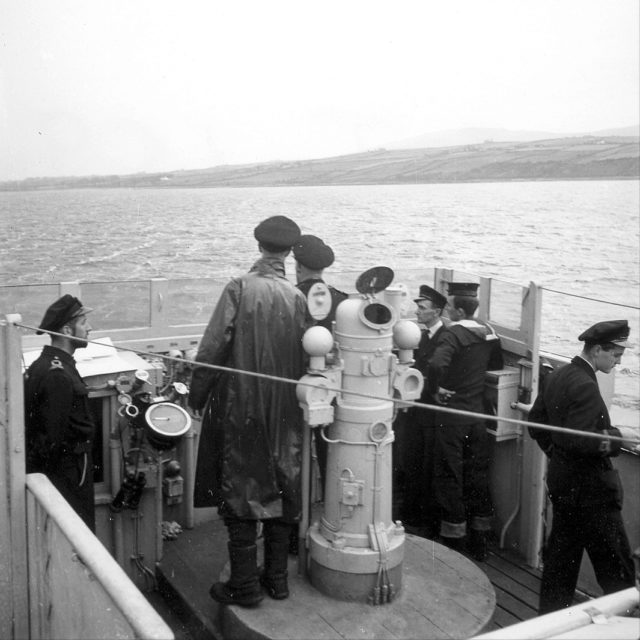
Officers on the bridge of Canadian Flower class corvette HMCS Trillium, circa 1940-42.
Image from the Canadian Navy Heritage website, Image Negative Number JT-159, via Wikimedia Commons.
Partly because of a disparity of resources, partly because there was still a lot of ambiguity concerning the role that the corvettes (and the RCN) would play in the war in general, the RN corvettes outclassed RCN corvettes when it came to performance at sea. Misapplication of Staff energies also played a role.
Instead of laying down a basic policy for the engineer-in-chief to follow, the Staff haggled over every conceivable alteration to their corvettes. They insisted, for example, that inclining tests be done before .5-inch machine guns were authorized for the bridge wings, even though they knew full well that this practice had already been adopted for comparable British ships. In the final analysis it would have been much better had the RCN continued its initial practice of calling its own corvettes “Town class”, after its policy of naming them for small Canadian communities. Instead the practice was abandoned in deference to the Admiralty’s choice of “Town class” for the ex-American destroyers, and the RCN applied the British class name of “Flower” to its corvettes. Had the RCN stuck to its distinctive class name, the tremendous differences which were to prove so very important by 1942-43, might have been as apparent as they were real.
Deck awash on HMCS Trillium, circa 1943
National Archives of Canada PA-037474, via HMCS Trillium page of the For Posterity’s Sake website – http://www.forposterityssake.ca/Navy/HMCS_TRILLIUM_K172.htmNSHQ’s notion that the RCN was to provide convoy escorts for the Newfoundland focal area suggests that the Naval Staff had not made the mental leap from the concept of locally based “strike forces” to the idea of a regional escort force. In this they were not alone. The distinction between two types of operation — one searching for submarines where shipping was plentiful, the other actually protecting the ships towards wich the submarines were drawn — was never very clear in the early days. NEF was, none the less, admirably suited to RCN capabilities. It also met two other vitally important criteria: it supported the government’s geopolitical aspirations and was at the same time fundamental to the war effort.
The war was entering what Churchill called “one of the great climacterics”. On June 22nd, Hitler would invade Russia and soon had her reeling. A Soviet collapse would give Hitler access to enormous resources. Even if Russia could fight them to a stalemate, there could be no Allied victory without an attack supplied by sea and mounted from the British Isles. Whether for the ultimate defence against a stronger Germany or for our own seaborne assault, Allied resources had to be turned into munitions of war and stockpiled in the UK. The resources were more than sufficient, but between the promise of the future and the need of the present lay a perilous gap of space and time that could only be bridged by ships, all the ships now available and hundreds more. Many convoys arrived at British ports each week and the tonnage unloaded was enormous. Yet a great percentage of it was what the island required simply to exist. Only the margin above that daily necessity represented the power to wage war. Munitions, aircraft, guns, tanks, and above all, aviation gasoline and fuel oil. If oil stocks fell below the point of safety, the operation of ships and planes would have to be curtailed. If U-boat attacks could not be met effectively, more ships would be lost, creating further shortages which would again reduce operations. The increasing demands of the war had to be met by a corresponding increase in the flow of cargo.
The U-boats imposed a steady drain: three merchant ships were going down for every one replaced. Eight submarines were coming into operation for every one sunk. U-boats swarmed in the Mediterranean. They were off Gibraltar, off the Cape Verde Islands at the bulge of Africa, off Cape Town far to the south. By the virtue of St John’s position alone, it bridged nearly a quarter of the gap between the Canadian seaboard and Iceland. June 1941 would also see Canada’s Commodore Murray return from Britain to become Commodore Commanding Newfoundland Escort Force. From Liverpool, the RN’s Commander-in-Chief Western Approaches, Admiral Sir Percy Noble, directed the whole Atlantic battle, but Commodore Murray exercised autonomy within his own war zone. The Newfoundland Escort Force was made up of six Canadian destroyers and seventeen corvettes, plus seven destroyers, three sloops and five corvettes of the RN. Soon more ships, French, Norwegian, Polish, Belgian and Dutch, were allotted to Commodore Murray. His authority extended to all local escorts operating from St. John’s and to convoys and their escorts while in Newfoundland waters.
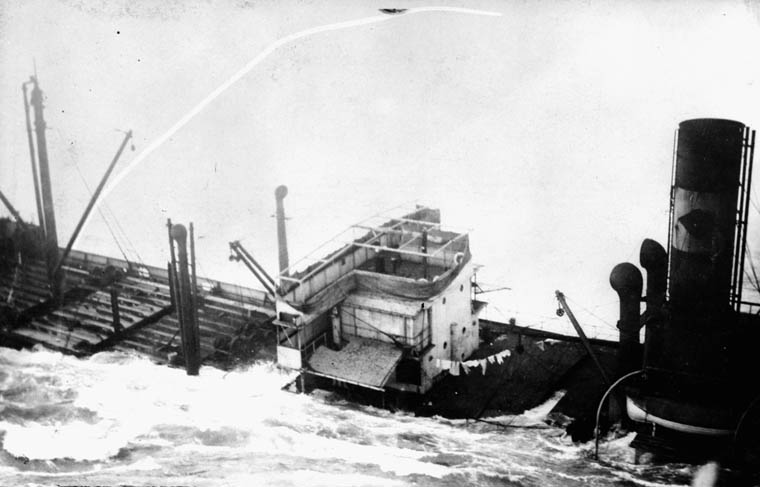
SS Rose Castle sinking and decks awash, 2 November, 1942. The original description for this item gives the date October 1942 as the date of the sinking, but according to eyewitness and survivor Gordon Hardy, the Rose Castle sank at 3:30 AM, November 2, 1942. On Oct 20, 1942, the Rose Castle was hit by a dud torpedo but was not damaged.
Library and Archives Canada/PA-192788
April 10, 2019
Canada and the Battle of the Atlantic, part 9 by Alex Funk
Editor’s Note: This series was originally published by Alex Funk on the TimeGhostArmy forums (original URL – https://community.timeghost.tv/t/canada-and-the-battle-of-the-atlantic-part-4/1447/3).
Sources:
- Far Distant Ships, Joseph Schull, ISBN 10 0773721606 (An official operational account published in 1950, somewhat sensationalist)
[Schull’s book was published in part because the funding for the official history team had been cut and they did not feel that the RCN’s contribution to the Battle of the Atlantic should have no official recognition. It is very much an artifact of its era, and needs to be read that way. A more balanced (and weighty) history didn’t appear until the publication of No Higher Purpose and A Blue Water Navy in 2002, parts 1 and 2 of the Official Operational History of the RCN in WW2, covering 1939-1943 and 1943-1945, respectively.]- North Atlantic Run: the Royal Canadian Navy and the battle for the convoys, Marc Milner, ISBN 10 0802025447 (Written in an attempt to give a more strategic view of Canada’s contribution than Schull’s work, published 1985)
- Reader’s Digest: The Canadians At War: Volumes 1 & 2 ISBN 10 0888501617 (A compilation of articles ranging from personal stories to overviews of Canadian involvement in a particular campaign. Contains excerpts from a number of more obscure Canadian books written after the war, published 1969)
- All photos used exist in the Public Domain and are from the National Archives of Canada, unless otherwise noted in the caption.
I have inserted occasional comments in [square brackets] and links to other sources that do not appear in the original posts. A few minor edits have also been made for clarity.
Earlier parts of this series:
Part 1 — Canada’s navy before WW2
Part 2 — The Admiralty takes control
Part 3 — The professionals and the amateurs
Part 4 — 1940: The fall of France, the battle begins, and the RCN dreams of expansion
Part 5 — The RCN’s desperate need for warships
Part 6 — New ships, new challenges
Part 8 — Expansion problems: not enough men for not enough ships
Part 9 — Early-to-mid 1941, the Rocky Isle in the Ocean
Marc Milner continues the story in North Atlantic Run:
The problem of providing end-to-end A/S escort in the North Atlantic was discussed by British and Canadian authorities during the winter. These talks were the first sure indication that RCN corvettes were likely to be used as ocean escorts (what the navy thought corvettes earmarked for the Eastern Atlantic were initially expected to do remains uncertain). In any event, the Anglo-Canadian discussions identified three factors crucial to the establishment of end-to-end A/S escort: the escorts must be available; they must have reached a reasonable state of individual and escort-group training, and the necessary bases must be available. In May 1941 none of these factors obtained in the Western Atlantic. An insufficient number of new corvettes were in commission, and most of these only recently. The development of facilities was now a top priority, but support facilities outside of Halifax were virtually non-existent, and the standard of training was to prove inadequate, to say the least.
The natural place from which to stage escort operations in the Northwest Atlantic was Newfoundland.
To briefly discuss Newfoundland’s role so far, when Canada declared war on September 10th, Newfoundland had already been at war for seven days. As a British dominion [under direct rule from London since 1934] ten years before joining Confederation, the mainland declaration of war received modest space on page four of the St. John’s Evening Telegram. They had participated in the first “hostile” act in North America: a German merchant vessel had been seized and thirty prisoners taken. The local YMCA was converted into a prison. Rationing and dim-outs took effect instantly. Private radio stations were silenced, mail and cables censored, aliens registered and controlled. Insurance premiums on waterfront property had gone up in less than a week from $1.00 to $5.00 for each $1000 of coverage.
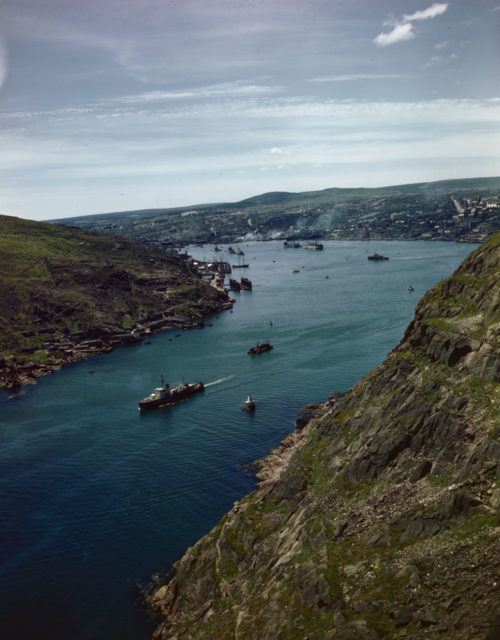
View of the entrance to St.John’s harbour and port facilities, Newfoundland, taken from Signal Hill, 1942. A minesweeper is leaving port.
Canada. Department of National Defence / Library and Archives Canada / ecopy
Milner continues:
Although not yet part of the Dominion of Canada, the island was integral to Canadian defence, and its protection was assumed, in consultation with the British, as a Dominion responsibility in 1939. By early 1941, however, the Canadian armed forces had made only a modest contribution to Newfoundland’s security, though more was planned under the terms of Plan Black. During 1940 the RCN had surveyed the coast for possible base sites and fleet anchorages and ordered a further ten corvettes for local defence. The navy had also seconded personnel to the Naval Officer in Charge, St John’s, Captain C.M.R. Schwerdt, RN, the only naval establishment on the island. Until the latter was turned over to the RCN in early May 1941, the Canadian navy had no permanent presence in Newfoundland. For a number of reasons, not all of them enemy inspired, this low level of activity was destined to change. The absorption of Schwerdt’s command into the RCN came as part of the integration of Newfoundland into the Canadian east-coast command system, and it mirrored similar army and air force arrangements. But Canada was also engaged in an embryonic war of influence with the U.S. over the old colony. The establishment of American bases on the island, as a result of the destroyers-for-bases deal with the British, was attended by an agreement granting the U.S. rights to defend its new bases by operations in adjacent territory. The agreement was concluded despite strong protests from Canada and in spite of the prior Canadian acceptance of responsibility for Newfoundland’s defence.
The anxiety Canada felt over her position in Newfoundland was exacerbated by joint Anglo-American planning of a combined strategy for the defeat of Germany should the U.S. enter the war. For several weeks in early 1941 senior American and British staffs met in Washington to discuss a co-ordinated Commonwealth and U.S. plan. Neither Canada nor any of the other Dominions was accorded official representation, although British delegates kept their Commonwealth allies informed of proceedings. The result of these meetings was an agreement, American-British Conference 1 (ABC 1), whereby the world was divided into two basic strategic zones. The Americans were to assume responsibility for most of the Pacific and for the Western Atlantic, with the exception of waters and territory assigned to Canada “as may be defined in United States-Canada joint agreements”.
The Canadians were not pleased with their treatment in the Anglo-American discussions, and the Chiefs of Staff feared that ABC 1 was intended to oust them from Newfoundland. The issue was somewhat problematical, since the implementation of ABC 1 was dependent upon U.S. entry into the war. However, the resolution of such issues, which had a direct bearing on Canada’s responsibilities as a sovereign state, did not accord with the national view of Canada as a full and independent partner in the war against Germany. Canada was already attempting to force recognition of that claim, at least with respect to North American defence, by the establishment of a Canadian Staff mission in Washington. While the battle to be heard and recognized went on, Canadian responsibilities under under the terms of ABC 1 were worked out by the Permanent Joint Board on Defence. These agreements, styled Joint Canadian-United States Basic Defense Plan No. 2 (Short Title ABC-22) and appended to ABC 1, acknowledged Canada responsibility for her own coastal waters (within the customary three mile limit) and for the commitment of five destroyers and fifteen corvettes to supplement USN forces in the Western Atlantic. Under the terms of ABC 22 the balance of Canadian naval forces was to be sent overseas.
[Editor’s Note: The actual wording of Annex 1 to ABC 22 isn’t quite as restrictive as far as available naval forces are concerned, and the inventory of USN and RCN forces is interesting in itself:]
ANNEX I-MILITARY FORCES
In view of the uncertainties which exist as to the stability of the strategic situations in various theatres, and as to the date on which the United States may enter the war, the strengths of forces listed below must be regarded as subject to change in the light of the strategic situation which may exist when the plan is placed in effect. The forces now estimated to be initially available for the operations required by this plan as of 15 July, 1941, are:
(A) ATLANTIC Ocean Escorts United States Atlantic Fleet 6 Battleships 5 8" Cruisers 54 Destroyers 4 Mine Sweepers (destroyer type) 54 Patrol Planes North Atlantic Naval Coastal Force (U. S. N.) 5 Eagle Boats 3 Gunboats 4 Patrol Yachts 18 Patrol Planes Page 1591 Newfoundland Force (R. C. N.) (Allocated to operate with Ocean Escorts, U. S. Atlantic Fleet) 5 Destroyers 15 Corvettes Atlantic Coast Command (R. C. N.) 8 Destroyers 28 Corvettes 4 Mine Sweepers 4 Magnetic Mine Sweepers 11 Armed A/S Yachts
[Editor’s Note: I’d never heard of “Eagle Boats” before, so here’s what Wikipedia has to say about them: “The Eagle class patrol craft were a set of steel ships smaller than contemporary destroyers but having a greater operational radius than the wooden-hulled, 110-foot (34 m) submarine chasers developed in 1917. The submarine chasers’ range of about 900 miles (1,400 km) at a cruising speed of 10 knots (19 km/h) restricted their operations to off-shore anti-submarine work and denied them an open-ocean escort capability; their high consumption of gasoline and limited fuel storage were handicaps the Eagle class sought to remedy. […] The term “Eagle Boat” stemmed from a wartime Washington Post editorial which called for “…an eagle to scour the seas and pounce upon and destroy every German submarine.” However, the Eagle Boats never saw service in World War I. […] A number of the Eagle Boats were transferred to the United States Coast Guard in 1919, and the balance were sold in the 1930s and early 1940s. Eight Eagle boats saw service during World War II. One was stationed in Miami as a training vessel. After the war, seven were decommissioned, while one was sunk by a German submarine.”]
Milner continues:
In the strictest sense, should the U.S. enter the war, Canada had lost the battle for Newfoundland. But though the Canadians had earlier been prepared to place their forces unreservedly under U.S. strategic direction in the worst-case scenario of Plan Black, they considered ABC 1 and ABC 22 offensive plans. The Canadians therefore clung firmly to their right to exercise command and control of Canadian forces in Canada and Newfoundland, even should ABC 1 come into force. Further, actual command of forces, despite a strong American sentiment to the contrary, was to remain with the respective nations. Co-ordination of the military effort in a given area was to be by “mutual co-operation”. Unified command of all forces under a single officer was allowed for upon agreement by the officers in the field or the Chiefs of Staff. The criteria for determining who was to command under such conditions were never clearly defined; however, the Canadians at least considered that the size of national contingent and the rank and seniority of its commanding officer were the governing elements. It was Canadian practice, therefore, throughout the joint American-Canadian occupation of Newfoundland to keep Canadian strength above that committed by the U.S. and to ensure that the senior Canadian present outranked his American counterpart. All of these considerations were foremost in the minds of the Canadian government and Staffs when Canada was asked by the British to base large escort forces at St John’s in the spring of 1941.
Thus, aside from the very real operational importance of the task, it was not surprising that the RCN responded enthusiastically to the Admiralty’s request of 20 May that the navy begin the escort of convoys from a base at St John’s. NSHQ responded by declaring that it was prepared to commit all of its new construction and its destroyer forces as well — virtually the entire navy. “We should be glad,” the Canadian reply read, “to undertake anti-submarine convoy escort in the Newfoundland focal area.” Naturally, command of the forces would rest with an RCN officer, and NSHQ suggested Commander E.R. Mainguy, RCN, an officer with experience in the Western Approaches who would be promoted to Captain for the task. However, the Canadians agreed that the Admiralty, through the Commander-in-Chief, Western Approaches (C-in-C, WA), would assume “direction of this force when necessary to coordinate its cooperation with those of the Iceland force.”
Commander E.R. Mainguy, Commanding Officer, HMCS Ottawa, off Botwood, Newfoundland in June, 1940. Botwood was being scouted as a potential seaplane base at the time, and would eventually become home to two RCAF Canso squadrons and a full Canadian Army detachment.
Canada. Dept. of National Defence / Library and Archives Canada / PA-104029Whether Canadian enthusiasm for the Newfoundland Escort Force (NEF) stemmed from a belief that a permanent, military and politically acceptable role for the burgeoning corvette fleet had been found remains a mystery. What is patently clear, however, is that both the British and the Americans considered the NEF a stopgap measure. By the summer of 1941 it was becoming increasingly evident that the U.S. would get involved in the Atlantic battle under the guise of defending the neutrality of the Western Hemisphere. When that happened, the role of the RCN in the Western Atlantic would be governed by the accords of ABC 1.
Whatever the final outcome of NEF, the commitment of the corvette fleet to ocean escort work marked a radical departure from the intended use of such vessels.
April 9, 2019
Canada and the Battle of the Atlantic, part 8 by Alex Funk
Editor’s Note: This series was originally published by Alex Funk on the TimeGhostArmy forums (original URL – https://community.timeghost.tv/t/canada-and-the-battle-of-the-atlantic-part-3/1442).
Sources:
- Far Distant Ships, Joseph Schull, ISBN 10 0773721606 (An official operational account published in 1950, somewhat sensationalist)
[Schull’s book was published in part because the funding for the official history team had been cut and they did not feel that the RCN’s contribution to the Battle of the Atlantic should have no official recognition. It is very much an artifact of its era, and needs to be read that way. A more balanced (and weighty) history didn’t appear until the publication of No Higher Purpose and A Blue Water Navy in 2002, parts 1 and 2 of the Official Operational History of the RCN in WW2, covering 1939-1943 and 1943-1945, respectively.]- North Atlantic Run: the Royal Canadian Navy and the battle for the convoys, Marc Milner, ISBN 10 0802025447 (Written in an attempt to give a more strategic view of Canada’s contribution than Schull’s work, published 1985)
- Reader’s Digest: The Canadians At War: Volumes 1 & 2 ISBN 10 0888501617 (A compilation of articles ranging from personal stories to overviews of Canadian involvement in a particular campaign. Contains excerpts from a number of more obscure Canadian books written after the war, published 1969)
- All photos used exist in the Public Domain and are from the National Archives of Canada, unless otherwise noted in the caption.
I have inserted occasional comments in [square brackets] and links to other sources that do not appear in the original posts. A few minor edits have also been made for clarity.
Earlier parts of this series:
Part 8 — Expansion problems: not enough men for not enough ships
Marc Milner discusses the RCN’s ongoing manning crisis afloat and ashore in North Atlantic Run:
… it was also necessary to find personnel to man new shore establishments. Indeed, by early 1941 the latter took precedence of the needs of the fleet. Although the navy remained committed to increasing the number of escort numbers assigned to its first operational priority, defence of the North Atlantic trade lanes, the gradual extension of the war underlined the paramount need for bases. “Our primary object from the Naval point of view,” a Canadian Chiefs of Staff “appreciation” of May 1941 observed, “must therefore be the extension of existing facilities and the provision of new ones to meet the ever-increasing demands of the British — and perhaps the United States — Naval forces.” The expansion fleet was then only one part of a much larger plan of support for North Atlantic naval operations. Moreover, actual planning for the commissioning and work-up of the new escorts took place as the fleet assumed new and more demanding tasks.
The concern of the Chiefs of Staff for facilities underlined the fact that even by the second winter of the war the navy’s growth was still held in check by enormous shortages. … The Director of Naval Personnel, Captain H.T.W. Grant, informed the council that the RCN needed three hundred RCNVR executive officers — none of whom had yet been enlisted — if the authorized commitments for the following May were to be met. This was no mean task in itself, but the Naval Council noted that the training establishments needed to prepare the men had to be built first. The final twist occurred when the minister advised that the navy must first make steps to acquire the necessary land!
As Nelles later explained in a personal letter to Admiral Sir Dudley Pound, the First Sea Lord, the RCN was indeed making bricks without straw. … The primary need was now quantity in all aspects of naval endeavour — manpower, ships, and bases.
With existing training establishments choked and new ones still in the planning stages, the provision of personnel for the expanding fleet posed a serious problem. Urgency was to Canadian planning in late 1940, when it became clear that Britain was involved in what Nelles described as “a Naval crisis equal [to] or greater than that which existed in 1917.”
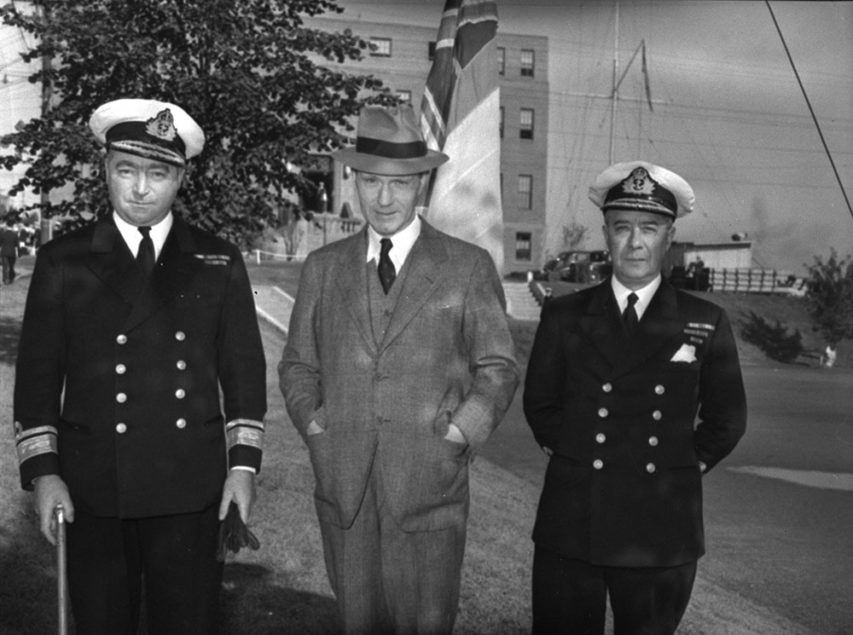
Hon. Angus L. Macdonald, Minister of National Defence for Naval Services, with senior RCN officers, Commodore H.E. Reid and Rear-Admiral P.W. Nelles, September 1940.
Canada. Dept. of National Defence / Library and Archives Canada / PA-104112
To help address the RCNVR officer shortage, a deal was agreed between the RCN and the RN by which RCNVR officers-in-training would travel to England and receive training at HMS King Alfred, the reservist training centre at Hove:
The great irony of the scheme was that it proved virtually impossible to draw on this body of highly trained Canadian naval officers later on, when the RCN was badly in need of qualified personnel. Certainly the King Alfred plan did nothing to resolve the shortage of qualified officers that crippled the fleet in 1941.
Another aspect of proper planning was work-up and operational training facilities for the fleet, particularly with respect to ASW.
Especially considering numerous British complaints of the low quality of Canadian ASW efforts on destroyers operating from UK bases. Canada had possessed no submarines since 1922 and had long since lost the ability to operate them. There was one submarine operating with the RN’s Third Battle Squadron out of Halifax: the Dutch O-15:
At the end of November, the Naval Staff formally requested that O-15 be made available for A/S training. For the moment, the Admiralty refused, although some exercises were conducted with her later in the year.
[Editor’s Note: The Dutch Submarines page on O-15 says “… the RCN was so desperate for ASW training in 1940 that when a Dutch submarine, which had avoided capture when Holland was invaded, fetched up in Halifax en route to England, the navy used it without permission and would not let it go when the Admiralty asked them to relinquish her …”]
Unable to obtain satisfaction from British sources, the RCN turned to the US, where preliminary investigations into acquiring an older USN submarine were made in early 1941. Commodore H.E. Reid, the naval attaché in Washington, raised the matter with the new Permanent Joint US-Canadian Board of Defense and then set about beating the bushes in more obscure parts of the American capital. By the end of January it was clear there were no submarines of any description would be forthcoming from American sources. The only gesture of assistance that the USN made was an offer to send a squadron of submarines (four boats) on a courtesy visit sometime in the summer. The RCN was advised to prepare itself to make maximum use of two to three weeks of free ASDIC training time. It was a generous offer, but it did not provide the RCN with a long-term solution to the pressing problem of providing ASDIC trainees with proper targets. Probably for this reason and because of the fear that acceptance would prejudice negotiations still underway regarding the future of O-15, the RCN politely declined the American offer. A few days later the Admiralty signalled its consent to the use of O-15 for A/S training.
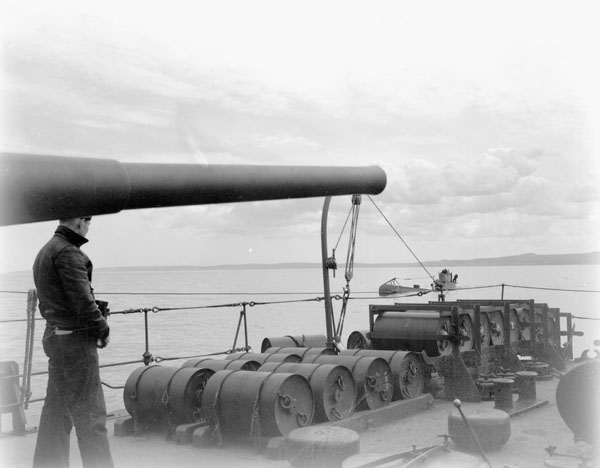
View from HMCS ST Laurent of the submarine O-15 of the Royal Netherlands Navy during an anti-submarine training exercise off Pictou, Nova Scotia, Canada, 20 August 1941.
Canada. Dept. of National Defence / Library and Archives Canada / PA-105491
While extremely useful, one submarine was not sufficient for all training needs and the shortage would continue until 1943 when Italian and Free French submarines became available in the Western Atlantic to help train US-built British destroyer escorts commissioning from US ports.
… having secured the services of O-15, there was no reason not to return to the American offer of training time on US submarines. That the RCN saw fit to reject direct USN assistance was the first sign of what became a curious, closely guarded attitude on the part of the RCN towards the USN. Nor were training submarines the only answer to preparing escorts for battle with the U-boats. Had the RCN — and the RN, for that matter — been more attuned to developments in the war at sea and seen the U-boat pack for what it really was, a flotilla of submersible torpedo boats, motor launches would have formed an essential part of A/S training as well. These small craft offered an excellent substitute for a training submarine in exercises designed to simulate night attacks on convoys, but it was not until 1942 that the RCN would begin to use launches for that purpose. The continuing fixation with submerged targets was understandable, since training on an actual submarine was the only means of attaining and maintaining efficiency among ASDIC operators. …
Aside from the escorts operating from the UK, RCN expansion hung fire during the winter of 1940-1. Obviously it would have been better to commission twenty corvettes into the RCN during 1940, as the Staff had originally planned. But when winter closed its icy grip on the St. Lawrence River, only four were operational.
A few more ships were patrolling and training in Pacific waters, and they would be joined by fresh ships commissioned on the west coast from British Columbian yards over the winter (six ships all told). The last week of April brought the thaw, and with spring came the expected deluge of new ships. Orillia, Pictou, and Rimouski were down the river before the month ended. In May, ten more were accepted into service, three for the west, six for the east. (Including HMCS Baddeck, the ship that Captain Alan Easton, whose firsthand account I find quite fascinating, first commanded.)
In a period of seven months thirty-three warships were added to the Navy List, slightly over half of the 1939-40 construction program.
Had it been possible to build the fleet entirely on the Atlantic or Pacific coasts, the seasonal character of expansion would have been averted. But because of the heavy demand for repair work on east coast yards after the fall of France only three orders for corvettes were ever placed east of the St. Lawrence River. [All at Saint John Shipbuilding.] All of these were much delayed, and the last to commission, Moncton not taken into service until April 1942 — two full years after the commencement of the program.
Lieutenant-Commander Easton described his first look at and first voyage of the Baddeck in 50 North: Canada’s Atlantic Battleground:
She was resting on the blocks of a dry-dock in a shipyard farther up the [St. Lawrence] river when I first saw her. I had stood on the wall and looked down at her sturdy features, the brand new vessel which was to take me many miles over the ocean. HMCS Baddeck was mine; we were to share at least a part of our lives together.
I was elated at being given command. I could not thank anybody because the news came in a naval signal, one of those pieces of paper rather like a telegram, but without the advertising at the top. I just had time to catch the night train from Halifax to Quebec.
When anyone is given an appointment which places him in charge of something which he thinks is pretty important, it generally makes him feel he has been singled out as being above the crowd. But this was not so in my case; the authorities who selected me probably had no alternative. There was no one else handy. In the Royal Canadian Navy during the first half of the war, there were not enough people to go round. Often you got the job whether you deserved it or not.
I could see now that the ship had been built mainly after the fashion of a big steam trawler, but with a longer and sharper bow. From drawings I had seen I knew she was 204 feet long and had a thirty-three-foot beam. Her appearance fitted these dimentions and in her nakedness her fat belly seemed to bulge over the floor of the dry dock, suggesting an ample capacity for, among other things, a large engine. Her rounded stern was inclined to turn up like a duck’s tail.
[…]
The first sight of a ship in which one is going to sail is always exciting, that first intensely interesting glimpse which creates an immediate impression — sometimes of disappointment. […] This time I was not disappointed. And as I stood on her deck, I felt alone with her in the silence of the deserted yard. It was Sunday and everything was quiet — no hammering or riveting, no trail of steam drifting up from the machine shop. Would she stay young like this or grow old quickly? I was glad it was quiet because this was my private introduction and she would try to show me herself — before our exploits began.
Exploits? That was the trouble. She might never be involved in a fight. A corvette, after all, was designed for coastal patrol work. And Canada had a long coastline. The war was on the other side of the Atlantic.
It was a month or more before I had an opportunity to try out her promises of performance on the broad reaches of the St. Lawrence below Quebec. She had been fitted out, her crew had come on board and she had been duly commissioned into the Royal Canadian Navy.
Many men felt strange. But this alien environment was what a good many expected, even sought, when they joined the navy. Stokers looked into the furnaces and felt the burners they would be tending. They looked for a quiet spot in the mess deck to sling their hammocks. They did not know then there would be no quiet spot. Most of them — for most were new to this — felt a twinge of concern and a little ache of homesickness. But these were hidden by an extra swing of the shoulder and more noise than necessary.
There had been no fanfare on leaving. No “off to war” business. Just a farewell hoot of the whistle as we pulled out into the river and headed down-stream for the coast. […] Of the three officers, only the navigator had been in a ship before. He had been twenty-five years at sea in all sorts of small vessels. He had started to sea in fishing vessels when he was twelve, and had gone on from schooners to small steamers to become master of a coastal tanker. He was a rough and readly little man and a rule-of-thumb navigator, I suspected; not that I was disinclined to be one myself. Of the 50 men, about five had been professional sailors or fishermen and, below, no more than six were experienced with engines and boilers. So with more than three-quarters of the complement as fresh to the sea as the ship herself, it was hard to perform our simple task; hard to keep steam up, avoid the shoals or even to steer a straight course. Had anything warlike occurred there would have been a shambles.
Thus, while we were on patrol, the few who knew their profession taught the others. The principles had been explained to them ashore and our specialists had been well instructed, but when they came to supply their knowledge in the ship, a place where discomfort alone had a dazing effect on the mind as well as the stomach, it did not always work out as expected.
We went at it systematically. I had been back at sea almost continuously since the beginning of the war. I was, therefore, in a fair position to know what was needed to develop the crew.
Boats were lowered many times and rowed and then hoisted; men swung the lead for soundings; they put out fires; they were taught lookout-keeping; they learned to read a swinging compass and compensate with the wheel; to stoke the furnaces without belching smoke; handle guns in a choppy sea and to throw a heaving line. But all of this was not learned easily.
Coming in from one of the patrols we were going alongside a jetty, which was overlooked by the admiral’s office; the admiral was known to be fond of observing his ships docking. A strong offshore wind was blowing. It was now or never with the heaving line as the bow of the ship drew parallel to the jetty at a nice throwing distance. An able seaman heaved but his line went up like the first act of the Indian rope trick instead of across the gap. It came down in the water on the lee side. The gap widened but another man standing by with a spare coiled line, in case the first man missed, heaved. It reached the jetty and was caught but the thrower was empty-handed. The end of the rope had gone too! The ship drifted away. And the admiral looked down from his window on the performance.
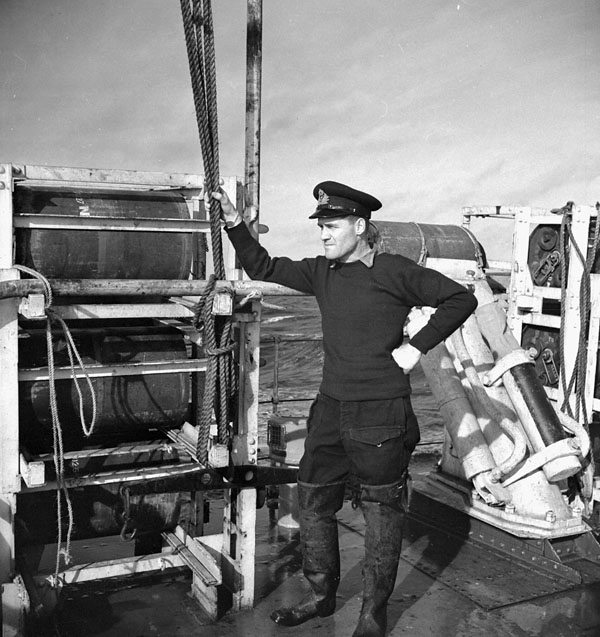
Lieutenant-Commander Alan H. Easton, DSC, Commanding Officer of the frigate HMCS Matane, Halifax, Nova Scotia, Canada, January 1944.
Lt. Gilbert A. Milne / Canada. Dept. of National Defence / Library and Archives Canada / PA-206442
Marc Milner, North Atlantic Run:
Staff preoccupation with a myriad of apparently non-essential matters also stemmed from the lack of any sense of urgency over the commissioning of the corvette fleet, at least for operational purposes. Despite Nelles’ stated concern over a possible repeat of 1917, even the Admiralty advised in February 1941 that the RCN could accept a delay in the attainment of competence by its own corvettes. Further, although the navy ardently desired to play a full role overseas in what Nelles described as the “theatre of active operations”, the Naval Staff decided in October 1940 that the products of the first construction program would go to meet home requirement first. Once fifty per cent of the latter were met, escorts would be sent to the Eastern Atlantic — the war zone — on an equal priority basis.
Despite the policy of sending auxiliaries overseas and the sure knowledge that the RN was already using its own corvettes as ocean escorts, there is no indication that the RCN believed either that its corvettes would be called up for similar activities or that they required modification to make them more suited to an ocean escort role. In fact, Canadian escorts were primarily intended for inshore duty, as had been the original intentions of the British as well. But the inshore role of Canada’s corvettes was reinforced by defense arrangements made between the US and Canada after the fall of Western Europe. In August 1940 the new Canadian-American Permanent Joint Board of Defence produce its first basic defence plan (Number 1) for North America. It adopted a worst-case scenario, the defeat of Britain by Germany, followed by a contined state of war between Germany and the Commonwealth, from which it took its sobriquet, Plan “Black”.
Canadian corvettes under Plan Black were to be formed into five-ship ASW strike forces that would hunt down and destroy U-boats for the RCN’s system of defended ports. Primarily hunting in the approaches to harbours or at the focal points of trade. “It was expected that in some cases, notably off Halifax and Sydney, corvettes would conduct some local escort, though for Canadian purposes this was not their primary role.”
In addition to this offensive use of corvettes, the navy also looked forward to the commissioning of the first construction-program ships in order to proceed with many aspects of expansion, such as training. For the professional navy at least the corvette fleet was not the embodiment of naval expansion. Rather it was, as Nelles described it, a “stepping stone”. Events at sea would soon change this, but it would take some time before that change affected attitudes in Ottawa.
On the ocean, as the war at sea intensified it pushed further westward. Over the winter the dispersal points under British ASW escort had moved steadily into the mid-Atlantic. The bases in established in Iceland in April 1941 allowed escort to roughly 35 degrees west.
This move, in conjunction with a similar extension of air escort, proved initially successful. During April three convoys were attacked in the area that had previously uncovered by A/S escorts, and three U-boats were sunk in the ensuing actions. The Germans, once again finding the climate around defended trade too unhealthy, simply pushed farther west. In May they struck at Halifax-to-UK convoy HX-126 as it approached the limits of A/S cover. Before the escort could join, a U-boat pack of six attackers sank five ships. In the face of a continued threat, the convoy was dispersed, which led to further losses. To forestall further German success, the gap in continuous A/S escort of convoys between the limits of local Canadian escorts and those of the RN based in Iceland needed to be filled.
April 8, 2019
Canada and the Battle of the Atlantic, part 7 by Alex Funk
Editor’s Note: This series was originally published by Alex Funk on the TimeGhostArmy forums (original URL – https://community.timeghost.tv/t/canada-and-the-battle-of-the-atlantic-part-3/1442).
Sources:
- Far Distant Ships, Joseph Schull, ISBN 10 0773721606 (An official operational account published in 1950, somewhat sensationalist)
[Schull’s book was published in part because the funding for the official history team had been cut and they did not feel that the RCN’s contribution to the Battle of the Atlantic should have no official recognition. It is very much an artifact of its era, and needs to be read that way. A more balanced (and weighty) history didn’t appear until the publication of No Higher Purpose and A Blue Water Navy in 2002, parts 1 and 2 of the Official Operational History of the RCN in WW2, covering 1939-1943 and 1943-1945, respectively.]- North Atlantic Run: the Royal Canadian Navy and the battle for the convoys, Marc Milner, ISBN 10 0802025447 (Written in an attempt to give a more strategic view of Canada’s contribution than Schull’s work, published 1985)
- Reader’s Digest: The Canadians At War: Volumes 1 & 2 ISBN 10 0888501617 (A compilation of articles ranging from personal stories to overviews of Canadian involvement in a particular campaign. Contains excerpts from a number of more obscure Canadian books written after the war, published 1969)
- All photos used exist in the Public Domain and are from the National Archives of Canada, unless otherwise noted in the caption.
I have inserted occasional comments in [square brackets] and links to other sources that do not appear in the original posts. A few minor edits have also been made for clarity.
Earlier parts of this series:
Part 7 — The end of 1940, rise of the U-boat threat, the corvette waddles into the war, and expansion headaches at every turn
In North Atlantic Run, Marc Milner outlines some of the challenges being faced by the escort fleet in the changing conditions of the Battle of the Atlantic:
The fall and winter of 1940-1 was a peculiar time for escort operations, and pre-war concepts of trade defence and ASW were under strain. Losses to convoys were high, and authorities were baffled about effective countermeasures. There was a strong lobby within the RN, supported by Churchill while he was First Lord of the Admiralty and after he became prime minister, that favoured offensive action against U-boats by even the slenderest of escorts. The two schools of thought, one favouring an active pursuit of the enemy and the other the primacy of escort, were still matters for debate when the Canadians joined the Clyde Escort Force in late 1940. Through the winter the issue was finally resolved in favour of defence as the first priority. However, in light of the subsequent Canadian tendency to pursue even the most tenuous contacts with zeal, it is questionable if this exposure to nascent British escort tactics did the RCN much good. … By January all the River-class ships and four of the Towns — two having been held back by defects — were operating from the Clyde. During this second winter of the war there were also Canadian corvettes in the Clyde Escort Force participating in the crucial battles of the first phase of U-boat pack attacks. These corvettes were actually the ten of their class built in Canada to British accounts. All were completed before the freeze-up of late 1940, and the RCN assumed responsibility for their acceptance from the builders, commissioning into the RN, and manning for passage to the UK. Once in England the ships were to be handed over to the Admiralty. Unfortunately things did not go as planned, and the RCN ended up taking all ten of these corvettes into Canadian service.
The story of the “British” corvettes and their transfer to the RCN is an important one, for it illustrates the kinds of problems the RCN had when dealing with the RN. Because the ships were manned for passage only, their crews were the barest minimum, roughly assembled from spare hands, all of whom were designated for other duties upon completion of the crossing. Personnel from the first corvettes to go, for example, were assigned to HMCS Dominion, the RCN’s depot in Britain [Dominion was designated as a ship for administrative purposes, there was no actual physical vessel]. They were to form a manning pool for the destroyers already on operations in British waters. Those from the later passages were to return immediately to commission new RCN corvettes. All ten “British” corvettes were in the UK by early 1941 (the ships were named after flowers, following the Admiralty practice: Arrowhead, Bittersweet, Eyebright, Fennel, Hepatica, Mayflower, Snowberry, Spikenard, Trillium, and Windflower), but from the outset it proved impossible to obtain the release of their crews. As early as October of 1940, Dominion requested, on behalf of the Admiralty, that the crews of three recently arrived corvettes be allowed to remain aboard until the end of November. Reliefs for destroyer personnel, it was explained, could be drawn from the smaller ships (in the form of a “floating” pool) and the ships turned over to the RN in piecemeal fashion. NSHQ concurred, but no British replacement crews were forthcoming, and the issue remained unresolved. The corvettes, meanwhile, began escort operations with the Clyde force.
By February 1941 the delay in the release of men from the British corvettes began to affect planning of the RCN’s own expansion. Commodore G.C. Jones, RCN, commanding officer, Atlantic Coast (COAC) complained that the men should be returned to Canada before the opening of navigation on the St Lawrence River deluged the navy with new ships. “If our present commitments are to be met,” Jones observed, “it is essential this personnel be available.” He was advised by NSHQ that the matter was under review and that a decision was pending. Yet the issue lingered. In April the Admiralty petitioned the RCN to allow Canadian crews to remain aboard “so as to avoid impairing their efficiency by having to recommision them”. Since the ships were now operational, concern for their efficiency was justifiable. That escorts manned by skeleton crews and lacking many essential stores should have been committed to operations says a great deal about the tremendous need for escorts of any kind. It also suggests that communications between the RCN and RN were not what they should have been.
The misunderstanding over the nature of the RCN’s commitment to the ten British corvettes was to have long and serious repercussions. For the moment, the Admiralty’s concern for the efficiency of escorts operating in the embattled Western Approaches took precedence over all else. The Canadians were advised not to worry about the effect that losing these men would have on the buildup of the RCN’s own forces in the Western Atlantic. “It is considered,” the Admiralty’s signal went on to read, “that present circumstances justify some delay in these becoming effective.” Faced with the inevitable, the RCN acquiesced, so long as the ten corvettes were commissioned HMC ships. The Admiralty agreed and undertook to cover the costs and arrangements for refits, maintenance, and alterations and additions to equipment. The RCN was to look after running costs, pay, victuals, and the like (a similar arrangement existed with other Allied navies that undertook to man British warships fully themselves).
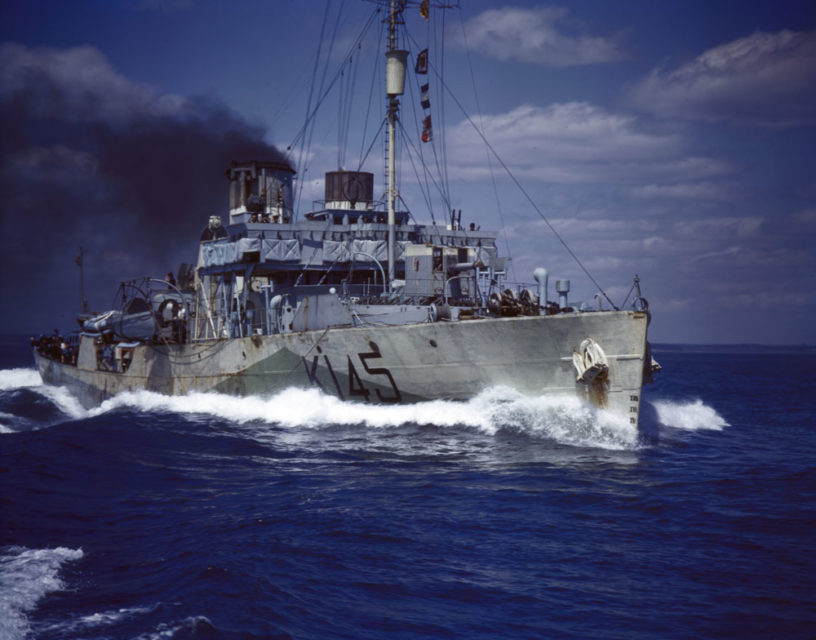
HMCS Arrowhead, one of the ten “British” corvettes built in Canada for the Royal Navy. Photo taken much later in the war, probably 1944-45.
Canada. Department of National Defence / Library and Archives Canada / ecopy
Speaking of the corvettes themselves, the little vessels were 205 feet in length, 33 feet in beam, with a draught of 11.5 feet, a top speed of sixteen knots and a planned armament of one four-inch deck gun, a stock of depth charges, and a lone QF 2-Pounder Pom-Pom gun mounted on the “bandstand” above the engine room, with a planned crew of 80-90 men.
[Editor’s Note: The original design called for a crew about half this size, which translated into terribly overcrowded conditions aboard mid- to late-war corvettes. Adding new weapons, new communications and detection equipment, and miscellaneous additional gear, plus the added food and water for the larger crew meant these little ships were packed as densely as possible.]
Out of necessity, the ships’ armament would grow and change over the years. Many of the original RCN corvettes were also fitted with minesweeping gear. Shortages meant that many would forego the 2-Pounder Pom-Pom, instead receiving two Lewis guns (what these were supposed to do in the event of modern air attack was unknown.) [All allied navies were under-prepared for the risks of air attack early in the war, and it would take time — and significant losses — for that painful lesson to be learned.] Thankfully, most of them would never get within range of Luftwaffe bombers. The few of their own corvettes that the RN assigned to the Mediterranean all received significant anti-aircraft armament augmentation. The use of triple-expansion machinery instead of steam turbines meant the largely reserve/ex-merchant crewmen had an easier time working below. Underwater detection capability was provided by a fixed ASDIC dome; later modified to be retractable. Subsequent technological developments; like the High Frequency Radio Detection Finder or “Huff-Duff” would be added along with a number of different radar systems. More men would be added to crew these systems, putting additional demand on a ship where space was already at a premium.
The Flowers could be serviced by practically any small dockyard or naval station so many ships came to have a variety of different weapons systems and design modifications depending upon when and where they were refitted; there was really no such thing as a “standard” Flower-class corvette. The major changes could include:
- Original twin mast configuration changed to a single mast in front of the bridge, which was then often moved behind the bridge for improved visibility for bridge crew.
- Minesweeping gear removed to improve the ship’s range.
- Galley relocated from the stern to midships.
- Extra depth charge stowage racks added to the stern. Later even more storage was added along the walkways.
- Hedgehog anti-submarine weapons system fitted near the main gun platform.
- Surface radar fitted [in various marks, including some early, relatively primitive Canadian sets or more sophisticated British equipment].
- Forecastle lengthened to midships to provide more accommodation and better seaworthiness. Several vessels received a “3/4 length extension”.
- Increased flare at the bow. This and the forecastle lengthening would become standard features on later ships.
- Various changes to the bridge, typically lowering and lengthening it. Original enclosed compass house removed.
- Extra Lewis guns mounted on the bridge or engine room roof.
- Oerlikon 20-mm cannons fitted, usually two on the bridge wings, but sometimes as many as six spread out across the ship.
Any particular ship could have could have any mix of these, as well as other specialist one-off modifications.
A major difference between the RN vessels and the RCN, later USN, and other navies’ vessels was the provision of upgraded ASDIC and radar. The RN was a world leader in developing these technologies, and thus RN corvettes were often better-equipped for remote detection of enemy submarines than Canadian corvettes. A good example of this is the difficulty that RCN corvettes would have in intercepting U-boats with their Canadian-designed SW1C metric radar, while the RN vessels were equipped with the technologically advanced Type 271 centimetric sets. In addition, RCN corvettes were not initially equipped with gyrocompasses making ASDIC attacks more difficult.
The corvettes would never be handsome or comfortable ships. They would, as some cracked, “roll even on wet grass”. The captains who took them over were mostly ex-merchant officers, and while they were unpleasant commands, many developed a grudging respect for them. On the slipways of the Canadian coasts and the Great Lakes, the rest of the corvette fleet construction program was continuing on schedule.
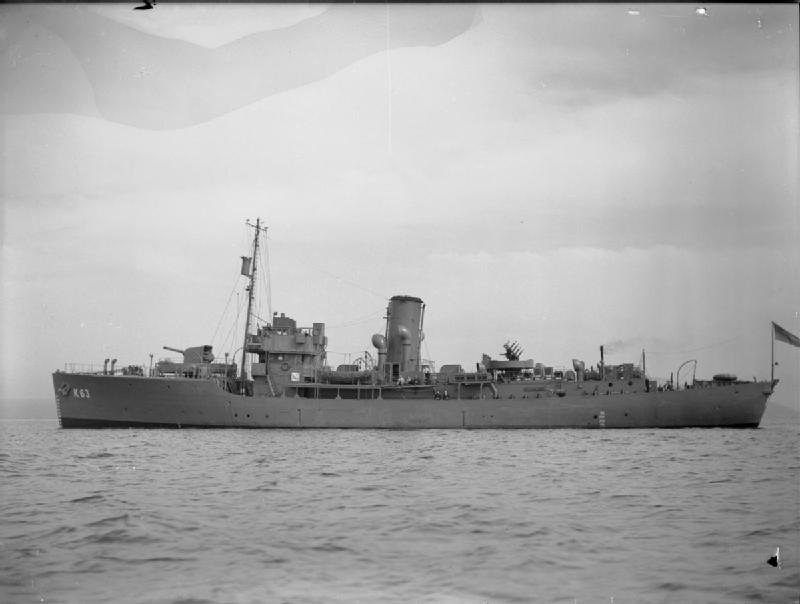
Royal Navy Flower-class corvette HMS Picotee, pennant K63, shortly after being commissioned before modification, showing a number of original design features, including a much shorter bow and forecastle and a mast in front of the bridge, although the second mast has been removed.
Imperial War Museum photo by Lt. H.W. Tomlin, Royal Navy official photographer, via Wikimedia Commons.
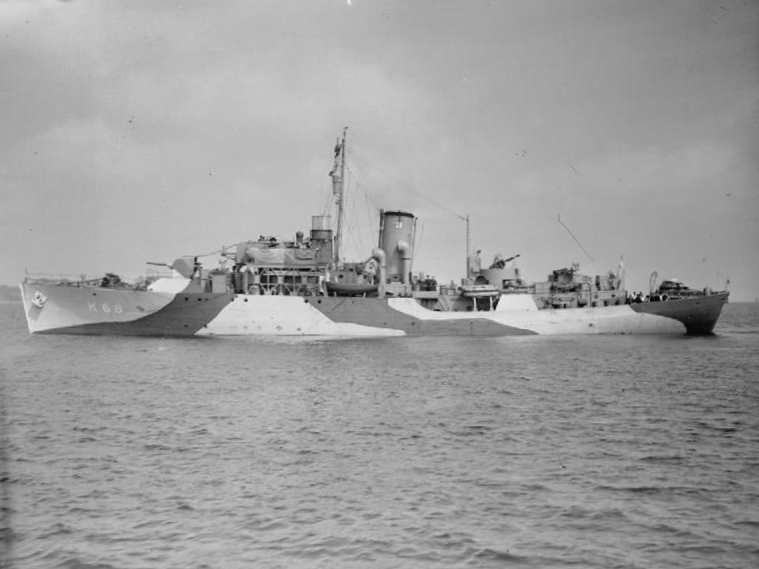
Royal Navy Flower-class corvette HMS Jonquil later in the war showing the changes to the bow and forecastle.
Imperial War Museum photograph FL 22394, via Wikimedia Commons.
Terrence Robertson described for Maclean’s the first time he saw a RCN corvette at sea:
She was Canadian-built, Canadian-manned and named Windflower (incidentally one of the ten built for British use, then “returned” to the RCN). When the destroyer on which I was serving met this newcomer to the Atlantic battlefield in January 1941, we not unnaturally approached for a closer look. We saw on her foredeck a four-inch gun with a wooden barrel that drooped. Then we were warned to keep clear of her stern with the immortal signal: “If you touch me there, I’ll scream.”
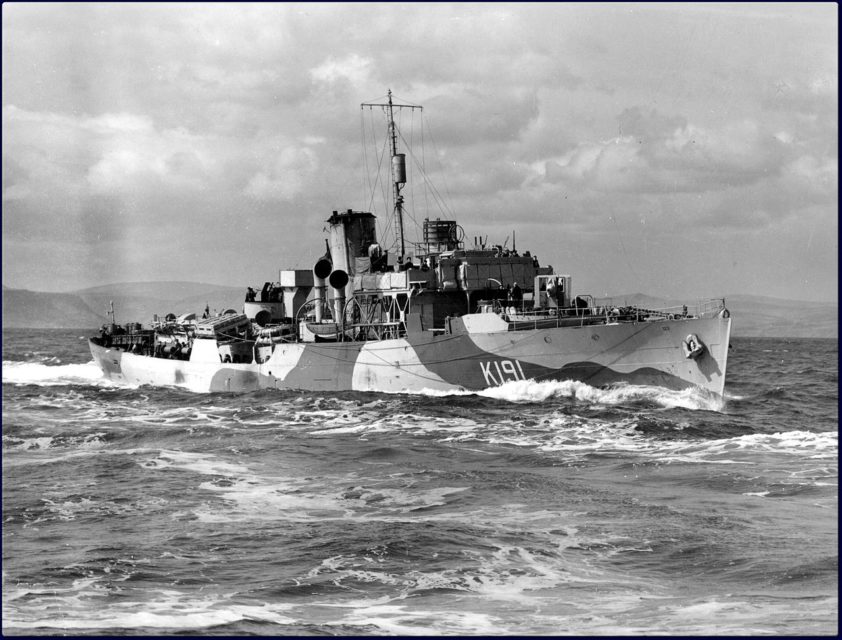
HMCS Mayflower in 1942, one of the first ten corvettes built in Canada like her sister Windflower.
Photo from the Canadian Navy Heritage website, Image Negative Number MC-2589, via Wikimedia Commons.
Marc Milner continues:
The ten British corvettes were the second group of ships thrust upon a reluctant RCN by the British in less than a year. By RN standards the manpower requirements for the sixteen ships was not very large (about 1200 all ranks), but their acquisition represented a major expansion for the RCN. The means whereby the corvettes came into Canadian service also illustrates what was for the RCN a recurrent problem, that of obtaining the release of both men and ships lent to the RN. The first incident may well have been an absent-minded assumption on the part of many British officers that the RCN was committed to some form of Commonwealth navy. … In the event, the RCN put up an honourable fight, better than any of its later attempts. But once committed to the common cause, it had little choice but to turn in the direction where the powers that be deemed its efforts would achieve the most good. Perhaps more serious, with respect to the pending struggle for efficiency in the RCN’s own corvette fleet, was the Admiralty’s insistence that the Canadian navy could accept a delay in developing that efficiency. Ironically, a few short weeks later the British urgently requested that RCN corvettes be committed to convoy operations in the Northwest Atlantic. If Canada’s naval expansion seemed to lack direction, it is small wonder.
Provision of officers and men for the navy’s new ships was of course a primary concern as 1940 drew to a close. Much of the RCN’s disposable manpower went into commissioning the six Town class destroyers and ten corvettes taken over from the Admiralty — sixteen warships for which the navy had made no provision mere months before. Naturally this meant that the planning and assignment of personnel for the first wave of RCN corvettes was set back. Further, with virtually the whole fleet on active duty on the other side of the Atlantic, the navy had no ongoing access either to experienced personnel or to berths on operational warships which could serve as training posts for new officers and key non-substantive ratings. With proper management (by no means guaranteed), a modest interchange of new drafts and experienced personnel would have permitted a more orderly expansion of the fleet and shore establishments and would have softened the devastating impact of expansion in 1941. The navy considered this problem, and the Staff discussed the possibility of routing the occasional destroyer to a Canadian port where personnel could be exchanged. But the Naval Staff concluded that “it would be a most unwise policy to relieve any large percentage of a ship’s company when that vessel was acting in a War Zone.”
The first RCN corvettes to become operational therefore were commissioned with scratch crews. Although the navy kept its sound policy of not tampering with escorts in a war zone, the conditions which obtained over the winter of 1940-1 changed by the following spring. By then the fleet was operational closer to home and, technically at least, no longer in a war zone.
In late 1940 the RCN was faced with building up manpower needed to commission fifty-four corvettes, twenty-five minesweepers, and small numbers of motor launches — about seven thousand officers and men.
Windflower and Mayflower were the first two Canadian-built corvettes to make the passage to England. The navy was short of suitable weapons, so both had been fitted with dummy guns. The irrepressible pair were the first two of an eventual one hundred and twenty-two corvettes which, in the next four years, would carry thousands of pre-war farmers, miners, students, and white-collar workers into battle against the U-boat fleet. Their exploits were rarely spectacular, almost never heroic. But in the Battle of the Atlantic, the words “Canadian” and “corvette” became almost synonymous and the little ships created legends of courage and endurance.
They were needed more and more with each passing month. During the last week of February 1941, 150,000 tons of Allied merchant shipping was sunk; in the first two weeks of March, 245,000 tons; and this rate of loss continued into April and May. Three or four ships and their cargoes were being sunk daily.
April 5, 2019
Canada and the Battle of the Atlantic, part 6 by Alex Funk
Editor’s Note: This series was originally published by Alex Funk on the TimeGhostArmy forums (original URL – https://community.timeghost.tv/t/canada-and-the-battle-of-the-atlantic-part-2-edited/1434).
Sources:
- Far Distant Ships, Joseph Schull, ISBN 10 0773721606 (An official operational account published in 1950, somewhat sensationalist)
[Schull’s book was published in part because the funding for the official history team had been cut and they did not feel that the RCN’s contribution to the Battle of the Atlantic should have no official recognition. It is very much an artifact of its era, and needs to be read that way. A more balanced (and weighty) history didn’t appear until the publication of No Higher Purpose and A Blue Water Navy in 2002, parts 1 and 2 of the Official Operational History of the RCN in WW2, covering 1939-1943 and 1943-1945, respectively.]- North Atlantic Run: the Royal Canadian Navy and the battle for the convoys, Marc Milner, ISBN 10 0802025447 (Written in an attempt to give a more strategic view of Canada’s contribution than Schull’s work, published 1985)
- Reader’s Digest: The Canadians At War: Volumes 1 & 2 ISBN 10 0888501617 (A compilation of articles ranging from personal stories to overviews of Canadian involvement in a particular campaign. Contains excerpts from a number of more obscure Canadian books written after the war, published 1969)
- All photos used exist in the Public Domain and are from the National Archives of Canada, unless otherwise noted in the caption.
I have inserted occasional comments in [square brackets] and links to other sources that do not appear in the original posts. A few minor edits have also been made for clarity.
Earlier parts of this series:
Part 6 — New ships, new challenges
Meanwhile at sea, for a year or more, HMCS Saguenay and a handful of other River-class destroyers had conducted Canada’s naval war virtually alone. Since spring they had fought beside Royal Navy warships against submarines prowling the coasts of Britain as part of the anti-invasion fleet. When the ships and RAF Coastal Command planes made things too difficult there, the U-boats moved west. With Iceland now available as a base (after the British invasion in May 1940), the aircraft and escort ships followed them.
The five Canadian destroyers remaining in Britain (Assiniboine, Ottawa, Restigouche, St. Laurent, and Saguenay), were employed escorting outbound convoys to their dispersal point, roughly 12-15 degrees west, and then returning with inbound convoys to harbour. On December 1 1940 while escorting a convoy, Saguenay was struck on her port bow by a torpedo fired by the Italian submarine Argo: she was the first Canadian naval vessel hit by an enemy torpedo. The ship was nearly sunk, with a bent propeller shaft, a major fire amidships, and a section of the bow broken off. The crew were able to keep the ship afloat and moving at a modest two knots. Five officers and thirty-five crew were evacuated to the RN destroyer Highlander to reduce potential casualties in case of another torpedo attack; and throughout the night and most of the next day a skeleton crew fought fires and kept the hull from further flooding. Tugs arrived later that evening, but the ship had built up to a respectable six knots by that point and the commanding officer decided she could carry on under her own power. At noon next day she rounded the north coast of Ireland with the fires out and her steering gear back in operation. She triggered an acoustic mine as she approached Barrow-in-Furness, and with new stern damage and salt water contaminating her remaining fuel, she had to accept a tow, and reached port on December 5th.
Saguenay lost twenty-three men and sustained grievous injury to her hull but she had done the job she was supposed to do: the speed with which her guns went into action, said an Admiralty report, had forced the submarine to dive and prevented it from attacking any merchant ships. More and more Canada’s rapidly expanding navy was being forced into a new way of thinking, moving away from pre-war training and ideas. Sink U-boats when possible, but above all protect the convoy. Now Saguenay would be out of action for several months while the repairs were effected. Six destroyers had grown to seven with Assiniboine in October 1939, then back to six with the loss of Fraser in June 1940. HMCS Margaree (originally HMS Diana) had been purchased from the British to replace Fraser, but had been lost herself in a collision with a freighter at night in October 1940 with the loss of 142 of her 176 officers and crew. It was her first escort mission. Skeena was refitting in Halifax, leaving only five RCN destroyers to support the anti-submarine campaign.
Saguenay‘s involuntary removal from active service happened around the same time that help finally began to arrive from two sources. One was from the arsenal of a friendly neutral, the other from Canada’s own shipyards. The “Four-Stackers”, 50 overage destroyers given by the United States in exchange for 99-year leases on British bases in the Americas, began to arrive in December, 1940. Prime Minister Mackenzie King had been involved in the deal from the beginning, often acting as an intermediary between Winston Churchill and Franklin Roosevelt. The Americans were also pressing for basing rights in Canada and President Roosevelt wanted the Canadians to receive some of the destroyers being transferred. The Canadian government was not interested in granting base rights for what it felt was a small number of “ancient” destroyers, but the navy was told to prepare for them should they be forthcoming. The RCN was unenthusiastic — the ships were not considered to be as suitable as the River-class ships currently in service, and were unlikely to be of any long-term value at all.
Acting Captain (later Rear Admiral) H.G. DeWolf, Director of Operations in Halifax in late Summer 1940, recalls that the navy only grudgingly accepted the deal after Admiralty pleas for the RCN to take at least some of the ships. Canada accepted seven of what became known as the Town-class (the RN designation), six of which were named for Canadian rivers, the seventh, HMCS Hamilton, saw some RN service before transfer to the RCN, retaining her British name. As the American ships arrived in Canadian ports en route to the UK, the new crews were struck by American generosity; every inch of storage space was crammed with provisions now only a memory in England. There were bunks instead of hammocks; there were typewriters, radios, coffee-making machines. Unfortunately, there were also defects which quickly became apparent at sea. The lean, four-funnelled destroyers, emergency vessels laid down during the last year of the First World War, had been built in haste for a less technical conflict. They were not sufficiently maneuverable against U-boats and their sea-keeping qualities left much to be desired. Their narrow beam and shallow draft made them difficult to handle in rough North Atlantic weather. The mess deck bunks, for all their pleasant appearance, made exorbitant demands on the men’s crowded living space and their steering gear was flimsy and cranky. Any ships were better than no ships however, and although seldom loved and frequently hated by those condemned to sail them, four were sent to bolster the destroyers already operating in British waters. They would eventually form a crucial element of the fleet’s escort forces by virtue of their few positive qualities: they were fast and well-armed. Commodore L.W. Murray went with them and took command of all Canadian ships and establishments in the UK.
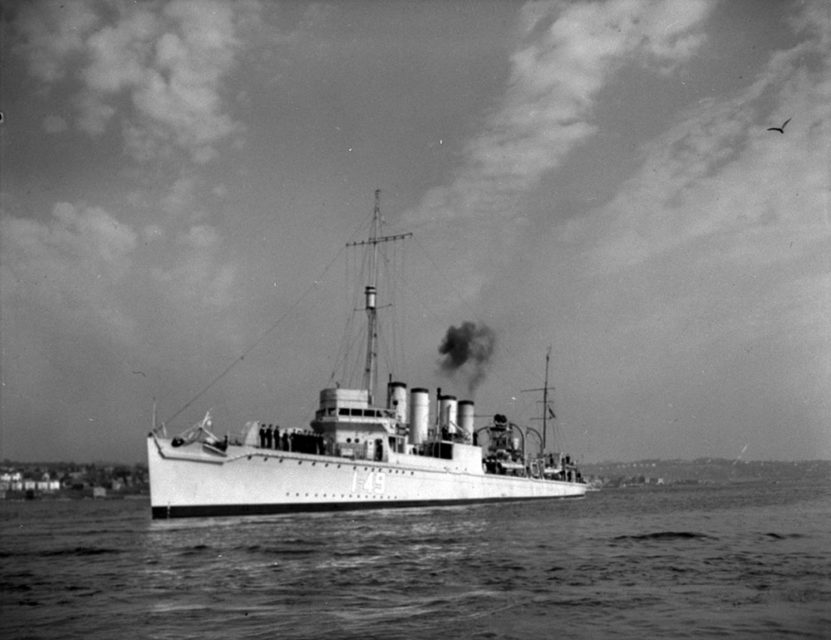
HMCS Columbia, originally US Navy destroyer USS Haraden, transferred to the RCN through the “destroyers for bases” deal.
Canada. Dept. of National Defence / Library and Archives Canada / PA-104178
[Editor’s Note: One of these four-stackers ended up with a fantastically varied post-transfer career: HMCS Leamington started as the USS Twiggs, becoming HMS Leamington in the destroyers-for-bases swap, was then transferred to the RCN (excitements in Canadian service included two collisions at sea and at least one near-sinking due to ice buildup while on winter convoy duty), then back to the RN, then she became a Soviet destroyer called the Zhguchi (“Fiery”), returned to RN service in 1950, then was temporarily renamed HMS Ballantrae for the film Gift Horse (released in North America as Glory at Sea), which was a fictionalized re-telling of the St. Nazaire raid in the HMS Campbeltown role, then finally sold for scrap in 1951. That is a full naval career!]
The autumn and winter of 1940 also saw the first of Canada’s new corvettes waddle their way down the St. Lawrence river into RCN service.
Returning to the Autumn of 1939, for purely RCN purposes, the navy estimated that around 40 anti-submarine vessels were needed over three years. Since some of the requisitioned ships were suitable for local duties, not all of the new vessels need be corvettes. It was also necessary to establish a rate of exchange if the smaller ships were to be bartered for Tribals. Quick resolution of these issues was essential if the full complement of the RCN’s first planned expansion phase (two Tribals, twenty corvettes, and twelve minesweepers) was to be in commission by Spring of 1940, as the Naval Staff hoped. The RCN did not get off the mark as quickly as it wished. Detailed drawings needed to begin construction of corvettes did not arrive from Britain until early 1940. The placing of orders was also complicated by the requirement that the navy deal with contractors through a third-party, the War Purchasing Board (later the Department of Munitions and Supply). In fact, the lack of official links to manufacturers and the interposition of another department between NSHQ and industry seriously complicated the process of modifying specifications in light of rapidly changing requirements.
Editor’s Note: J.L. Granatstein wrote of the creation of this ministry in Arming The Nation: Canada’s Industrial War Effort, 1939-1945 (PDF), emphasis mine:]
…the Liberal government of Mackenzie King in June 1939 had passed the “Defence Purchasing, Profits Control and Financial Act” which aimed to control profits and the costs of defence contracts. Profits could not exceed 5 percent, a stipulation that meant that soon after the war began, C.D. Howe, the Minister of Transport, told the House of Commons that Canada had not managed to place a single contract. The Act had also created the Defence Purchasing Board to coordinate purchases, and in its short life (July 14 to October 31, 1939) the Board managed to buy only $43.7 million worth of goods, with three-quarters of the orders placed after Nazi Germany had invaded Poland in September 1939 and Britain and France had declared war against the Hitler regime on September 3; Canada had followed with its own declaration of war one week later.
One of the first casualties of the Second World War was this system of profit controls, quickly repealed so that war orders could be placed. A second casualty was the Defence Purchasing Board itself, replaced on November 1, 1939 by the War Supply Board, led by Wallace Campbell, the president of the Ford Motor Company of Canada. Initially, the new Board fell under the control of the Finance Minister, but in mid-November, in a fateful and fortunate move, the Board came under the ambit of the Minister of Transport, the just-named Minister of Munitions and Supply, Clarence Decatur Howe. Howe had no department as yet, only a title. But when the War Supply Board was swallowed by the new department on April 9, 1940, just days after the King Liberals’ election victory, Canadian war production had found its czar.
The first Canadian orders for corvettes were not placed until February 1940, when fifty-four were contracted to be built. Of these, only twenty-four (roughly equivalent to first expansion phase) were intended for RCN service. The remainder were to be bartered for destroyers. Ten more corvettes were ordered by the RCN before the end of the month as replacements for some of the requisitioned auxiliary ships and to maintain a steady rate of construction in Canadian yards. By the end of February the First Construction Program was completed: sixty-four corvettes and twenty-four Bangor minesweepers (completion delayed until August 1940, as not enough qualified builders could be found right away). When the barter scheme (corvettes-for-Tribals) fell though in March 1940 because an exchange rate could not be agreed upon, the RCN found itself “holding contracts for considerably more corvettes than it intended to build”. The contracts could have been cancelled, having only just been signed, but the RN agreed to take ten of the vessels being built in Canadian yards, lowering the total for Canada down to 54, only seven more than what the navy had intended to have by 1942 anyway. For this reason, as well as political and economic pressures, the orders were allowed to stand. In August 1940 another six corvettes were ordered along with ten more Bangors to maintain continuous work in the shipyards (and to help retain the skilled workers).
Marc Milner continues:
What this embarrassment of riches meant was an acceleration of the navy’s hitherto cautious expansion plans and the jamming of three years of careful growth into less than two. Small wonder, then, that the personnel requirements overtook projections. Despite this, it is doubtful that the prospect of commissioning extra auxiliaries troubled anyone at NSHQ, particularly when the failure of the barter scheme was followed by the news that the British would allow the construction of Tribals to Canadian accounts in UK yards. The latter ensured that the main thrust of fleet expansion would go ahead. Two Tribals were duly ordered in 1940 and two more in early 1941, but none was completed in time to meet the requirements of the first expansion phase. As an interim measure, the navy requisitioned three small liners, Prince David, Prince Henry, and Prince Robert, and converted them to armed merchant cruisers (AMCs). The Prince ships remained the RCN’s most powerful units until the first of the UK-built Tribals were commissioned in early 1943.
HMCS Prince Robert, one of the RCN’s three armed merchant cruisers. All were converted to other roles later, and two were returned to civilian use after the war.
Photo via http://www.airmuseum.ca/rcn/princes.htmlThe matter of building Tribals in Canada was never wholly abandoned. The navy was well pleased with its arrangements of a British supply, but long term plans called for more than four. In April 1941 the subject of building Tribals in Canada was discussed once again by the Naval Council (the administrative and policy body of the naval service, chaired by the minister, with senior Naval Staff officers as members). The engineer-in-chief, Captain G.L. Stephens, advised against attempting such complicated building in Canada in the middle of a war. It was bound to be a long and expensive proposition, he warned, if for no other reason than that it was hardly worth tooling up industry to produce specialized steel plate and equipment for so small an order. Moreover, Stephens believed, construction of Tribals was likely to tie up manpower and resources which could be better used. Nelles agreed with his engineer’s views but felt that if such ships could be built in Canada, the navy should not waste its time on smaller “stepping stones”.
The problem had also been considered by the government. [The Minister of Defence for the Naval Service, Angus L.] Macdonald, was under considerable pressure from politicians and the press in his home province to secure wartime capital investment in Atlantic Canada. Indeed, although Canada was prospering from the war, an incredibly small percentage of new capital investment found its way eastward (just 2.5 per cent by 1944). Of the major wartime ship contracts let by May 1941, only three — all corvettes ordered from Saint John Ship Building and Drydock Company — were placed in the Maritimes. Mackenzie King wanted contracts for merchant ships let to Halifax shipyards, but Macdonald preferred destroyers. Without the latter, he explained in a letter to C.D. Howe, the dynamic minister of Munitions and Supply, the merchant ships would not get through. Macdonald wanted building in Halifax “confined to destroyers”, which were “all in all, the best type of escort.” Howe, who had survived the sinking of the SS Western Prince in December 1940 while on his first trip to Britain as minister of Supply, needed no convincing of the need for ships — or for escorts. Further, Howe, like Macdonald, wanted some construction undertaken soon in order to stabilize the employment situation for ship-repair workers, and thereby establish a pool of skilled labour for use in an emergency. Since the government was determined to build something, the navy was happy to support the construction of Tribals. Owing largely to the need to retool industry, it was not until September 1942 that the first keel was laid, and in the rush to complete the hulls, the Tribals drained manpower away from essential ship-repair tasks: quite the opposite of the original intention, and precisely the fear expressed by the navy’s senior engineer.
[Editor’s Note: J.L. Granatstein also discussed the RCN’s efforts to obtain Tribal-class destroyers:]
The growth was as rapid in naval construction which eventually employed some 30,000 workers. The first orders for corvettes, the Royal Canadian Navy’s main anti-submarine and convoy escort vessel, were placed in February 1940 and the first ten keels were laid that month. By the end of the year, 44 corvettes had been launched and an even dozen were manned. In all, 206 corvettes were built in Canada, most on the east and west coasts but many in Great Lakes ports and on the St Lawrence. At the same time, Canadian yards built frigates and minesweepers, tugs and landing craft, motor torpedo boats, patrol boats, and Tribal class destroyers. The last class of ships, greatly desired by the Navy, was the shipbuilding equivalent of the Lancaster, a step too far.
Half as big again as the destroyers with which the RCN began the war, the Tribals were heavily armed and fast, almost as powerful as a light cruiser. The Navy secured four such destroyers from the Royal Navy (Haida, Athabaskan, Huron, and Iroquois), but it wanted more and, late in the war, it secured Munitions and Supply’s permission to build four Tribals in Halifax yards. It was a quantum leap forward from constructing corvettes and frigates to building Tribals and, while they were completed, none was in the water and crewed before the war against the U-boats had ended on V-E Day, May 8, 1945.
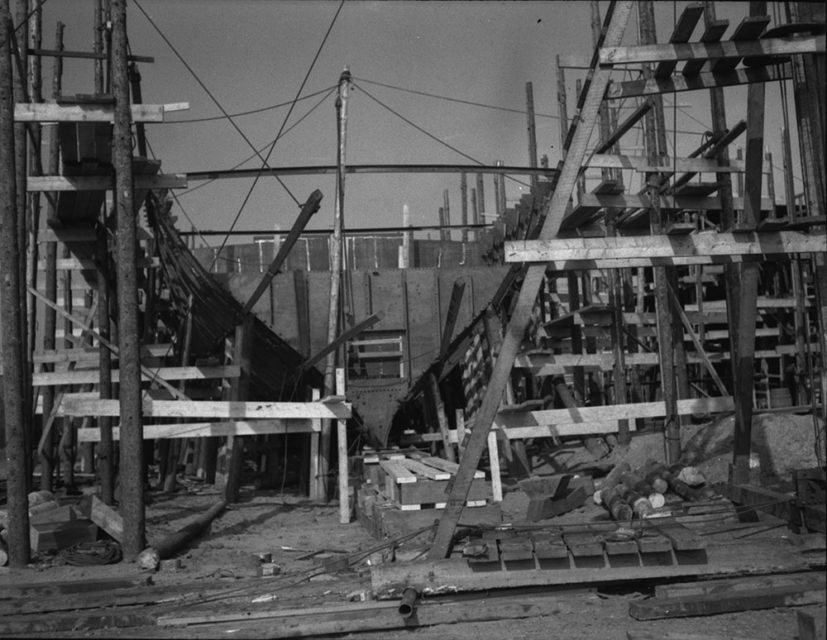
Hull of an RCN corvette (probably HMCS Moncton) under construction at Saint John Drydock and Shipbuilding Ltd.
Canada. Dept. of National Defence / Library and Archives Canada / PA-104134
Returning to Winter 1940, the Towns were being taken into service, the first corvettes arrived, and the RCN’s River-class destroyers returned to ocean convoy escort duties. With the U-boats now operating from the Atlantic littoral and with the adoption of pack tactics, losses to convoyed shipping had been mounting during the second half of 1940. From the outbreak of war to February 1940, only seven of the one hundred and sixty-nine ships lost to enemy action had been sailing in convoys. In August, the U-boats began attacking at night and on the surface in the style of torpedo boats: losses jumped quickly. In September alone, forty of the fifty-nine U-boat attacks on shipping were directed at convoy targets. With the adoption of these tactics by the Germans the “Battle of the Atlantic”, as it captured the popular imagination and forms the basis of this study, finally began. The intensification of the U-boat campaign on Allied shipping eventually forced a reallocation of all available ships to escort duty.
Editor’s Note: As the first of Canada’s new corvettes joined the fleet, it’s worth getting a look at the cultural differences between the “real navy”, the professionals of the RCN, and the very different “hostilities only” officers and ratings of the RCNR and the RCNVR, as related by James B. Lamb in The Corvette Navy:
Canada’s second navy was a much different force: a bunch of amateur sailors, recruited from every walk of civilian life, manning ships deemed too small for command by professional naval officers. The ships — Algerines, corvettes, frigates, Bangors — were as cheap as they could be built, and their officers and men were involved, not with admirals and captains, but with characters like Two-Gun Ryan, Harry the Horse, Death Ray, Foghorn Davis, and The Mad Spaniard. It was an amateur, improvised, cut-rate navy, the little navy, Canada’s other navy, manned by amateurs like me.
The division between the two navies was surprisingly complete and clear-cut; few regular career Canadian naval officers ever kept watch aboard a corvette, and only a handful of corvette crewmen were RCN ratings. For shortly after the outbreak of war, a strange process began. The little handful of professional naval officers — all that the country possessed and the only Canadians trained over long peacetime years to fight a war at sea — were bustled ashore into offices. There they presided over clerks and typists in a series of administrative posts for which they had received no training at all. Most of them never went to sea again.
Their places afloat were taken by a handful of former merchant seamen, now officers of the Royal Canadian Naval Reserve, and by young men in the Royal Canadian Naval Volunteer Reserve, many of whom were culled from offices ashore and most of whom had never been to sea before. It was a situation worthy of Gilbert and Sullivan: trained seamen were put in offices ashore and trained office managers were sent to sea. As a result, Canada’s professional naval officers were to play an ever-diminishing role in the Battle of the Atlantic.
This curious situation had been brought about by a miscalculation of the role the corvettes could play in the naval war. Originally they had been regarded as a stop-gap, and, as such, unworthy as commands for Canada’s few, and precious, trained naval officers. Apart from those allowed afloat in the RCN’s handful of pre-war destroyers, permanent-force officers were hoarded ashore against the time when the new super-ships would appear to fight the glorious Armageddon against Germany’s powerful surface fleet.
[Editor’s Note: By the time the professionals got their hands on the “real” ships they’d been waiting for — Tribals, then cruisers and even an aircraft carrier — there was no German surface fleet left to fight, and the scruffy, disreputable amateurs had ended up being the ones to fight the real battle: the one that mattered after all.]
April 1, 2019
Canada and the Battle of the Atlantic, part 5 by Alex Funk
Editor’s Note: This series was originally published by Alex Funk on the TimeGhostArmy forums (original URL – https://community.timeghost.tv/t/canada-and-the-battle-of-the-atlantic-part-2-edited/1434).
Sources:
- Far Distant Ships, Joseph Schull, ISBN 10 0773721606 (An official operational account published in 1950, somewhat sensationalist)
[Schull’s book was published in part because the funding for the official history team had been cut and they did not feel that the RCN’s contribution to the Battle of the Atlantic should have no official recognition. It is very much an artifact of its era, and needs to be read that way. A more balanced (and weighty) history didn’t appear until the publication of No Higher Purpose and A Blue Water Navy in 2002, parts 1 and 2 of the Official Operational History of the RCN in WW2, covering 1939-1943 and 1943-1945, respectively.]- North Atlantic Run: the Royal Canadian Navy and the battle for the convoys, Marc Milner, ISBN 10 0802025447 (Written in an attempt to give a more strategic view of Canada’s contribution than Schull’s work, published 1985)
- Reader’s Digest: The Canadians At War: Volumes 1 & 2 ISBN 10 0888501617 (A compilation of articles ranging from personal stories to overviews of Canadian involvement in a particular campaign. Contains excerpts from a number of more obscure Canadian books written after the war, published 1969)
- All photos used exist in the Public Domain and are from the National Archives of Canada, unless otherwise noted in the caption.
I have inserted occasional comments in [square brackets] and links to other sources that do not appear in the original posts. A few minor edits have also been made for clarity.
Part 5 — The RCN’s desperate need for warships
Marc Milner picks up the story in North Atlantic Run:
The first year of the war at sea developed as Allied planners had anticipated. Germany’s U-boat fleet was small and remained so. Its operational strength of forty-six submarines (only twenty-two of which were capable of deep sea work) was far short of the three hundred U-boats that Rear Admiral Karl Dönitz, Befehlshaber der U-boote (BdU; commander-in-chief of U-boats), estimated he needed to sever Britain’s supply lines. Moreover, the U-boat fleet was initially circumscribed by Allied control of the exits from the North Sea. In the early months of the war U-boat captains generally obeyed their strict instructions not to anger neutral opinion through rash and illegal acts, despite their torpedoing of the liner Athenia on the first day of the war, which suggested that Germany would again adopt unrestricted submarine warfare. So the Allies concentrated on Germany’s powerful surface fleet, on her commerce raiders lurking in disguise on the oceans of the world, and on hapless offensive anti-submarine (A/S) sweeps.
The convoys were organized from the first days of the war and had some escort vessels, but the U-boats were not yet operating at full potential — this would become blatantly evident later — and the relatively few escorts were not hard pressed to keep the merchant ships safe in passage.
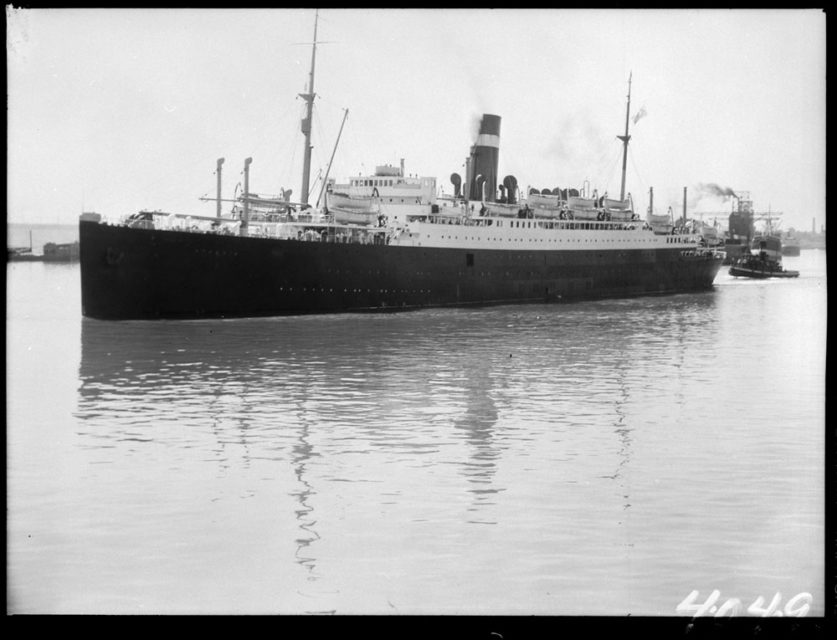
S.S. Athenia, at Montreal in 1933. She was torpedoed on the very first day of World War 2 by U-30 northwest of the coast of Ireland. Of the 1,103 passengers and 305 crew aboard, 118 were lost in the sinking (including 28 Americans).
Clifford M. Johnston / Library and Archives Canada / PA-056818
Through the spring and early summer, the U-boats operated mainly between Britain and Iceland; while they achieved nothing spectacular in terms of Allied tonnage sunk, the escort ships scored few victories in return. In one three-hour hunt HMCS St. Laurent and the RN destroyer Viscount dropped 80 depth charges in attacks on a submerged U-boat; when diesel oil bubbled to the surface they were sure they had gotten a kill. The Admiralty, cautious to award kills even in the early days, credited them with a “probable”.
Although Germany was now able to make good use of well-sited and easily defended new submarine bases on the Atlantic coast of France and to begin developing new tactics, it did not shake Allied belief that the U-boat threat had been rendered ineffective by ASDIC, convoys, and airpower.
Indeed, in a book on Modern Naval Strategy published by Admiral Sir Reginald Bacon, RN, and F.E. McMurtrie, two well-respected naval theorists, submarine attack on an escorted convoy was given little chance of success. Supposing the submariner could find the convoy in the first place, his distorted view of the world through a periscope was considered a grave handicap. With a periscope exposed in broad daylight — the only time, the authors believed, that an attack was possible — the submarine invited swift retribution from both escort and merchant vessel alike. Moreover, it was still generally believed that once a submarine was locked in ASDIC’s grip, destruction would follow from carefully placed depth charges. This view of anti-submarine sarfare (ASW) was utterly shattered by the Germans’ resourceful use of the U-boat in the second winter campaign on the sea lanes.
In practice, ASDIC was nowhere near perfect, and neither was depth charge placement especially when employed by Canadian escort ships — the inexperience of the majority of Canadian sailors played a role, as did their older and less sophisticated ASDIC sets. There were not enough escorts to protect convoys against multiple attackers, and air power was only available close to land and it proved not to be as capable as the Allied planners had hoped.
Air assets were so rare that the later war “mid-Atlantic air gap” did not exist because few of the necessary air bases that would be built by the end of the war were in place or even under construction yet. Canada’s pre-war air force was small, and though it was growing rapidly, it was not equipped or trained for ASW. The RAF had needed almost every available pilot during the Battle of Britain, and many pilots had been killed or wounded. Germany continued to build more U-boats, building at a far faster pace than Allied ASW forces could sink them, and now with far greater deployment flexibility than they had enjoyed during the First World War.
Marc Milner discusses the RCN’s expansion woes:
Fundamental to the whole problem of expansion was the availability of ships, and here too the RCN’s plans in the early days were never reliable. To upgrade local defences, to replace decrepit auxiliary vessels, and to provide A/S “strike forces”, the RCN had to undertake a modest shipbuilding program beyond that proposed in the pre-war plans. To round out local defences and the like it was decided in early September 1939 to build Bramble-class sloops and a small number of minesweepers. Further consideration was also given to the acquisition of Tribal-class destroyers. But the coming of war so early in the navy’s planned expansion threw it into serious disarray. Tribals could not be built in Canada without considerable assistance from British firms, and with British industry now fully absorbed in war work little help could be expected. Unfortunately, the RCN rejected a very sensible British suggestion that it seek expertise in naval ship construction in the United States. The Canadian navy also failed, initially, to obtain permission to place orders for Tribals in British yards. Faced with an almost impossible dilemma, the Naval Staff hit upon the idea of bartering less-sophisticated Canadian-built warships for British-built destroyers. The scheme had all the advantages of specialization. It permitted Canada to turn products from less-skilled manufacturers into high-value, long-term investments. For the government it meant good business and the possibility of future orders. For the RCN it meant the fulfillment of its expansion plans.
HMCS Cartier, later re-named HMCS Charny, in October 1940. An old Canadian Hydrographic survey vessel from 1910 pressed into service. Used for Naval Training and Naval Mine Avoidance Navigation.
Canada. Dept. of National Defence / Library and Archives Canada / PA-104169As the Naval Staff sorted through the problems of destroyer acquisition, it also tackled the question of what type of auxiliary warship to build for its own purposes and what type to build for bartering. Initial hopes of building sloops were dashed by the news that Canadian yards were incapable of building even small warships to naval standards. As the problem was being discussed, basic plans for a much simpler auxiliary ship arrived at Naval Service Headquarters (NSHQ) from the National Research Council (NRC), which had acquired plans for “whale-catchers” in July during a fact finding trip to the UK. The whale-catchers immediately appealed to the Naval Staff as a workable substitute for sloops, given that they were intended to be auxiliary vessels for inshore duty. Moreover, their mercantile construction was ideally suited to Canadian yards, and British adoption of this class made them suitable for bartering.
Once agreed that corvettes (as the whale-catchers were called by early 1940) were to be built as the navy’s primary A/S ship and as the means whereby larger vessels might be acquired, the Naval Staff had to decide how many to produce.
[Editor’s Note: The development of the corvette goes back to a WW1 proposal for a submarine-hunting ship based on the design of whaling ships. In 1936, Smiths Dock Company of Middlesbrough built the whaling ship Southern Pride (displacing 700 tons, with a top speed of 16 knots), and eventually the design was adapted into a naval escort, the Flower-class corvette, that became the backbone of the convoy escort fleet. I’ve always been fascinated by the Flowers, as they originated in my home town and my maternal grandfather worked for Smiths Dock throughout the war as a plater (he very likely worked on several corvettes in that time). In War at Sea: Canada and the Battle of the Atlantic, Ken Smith provides this description:]
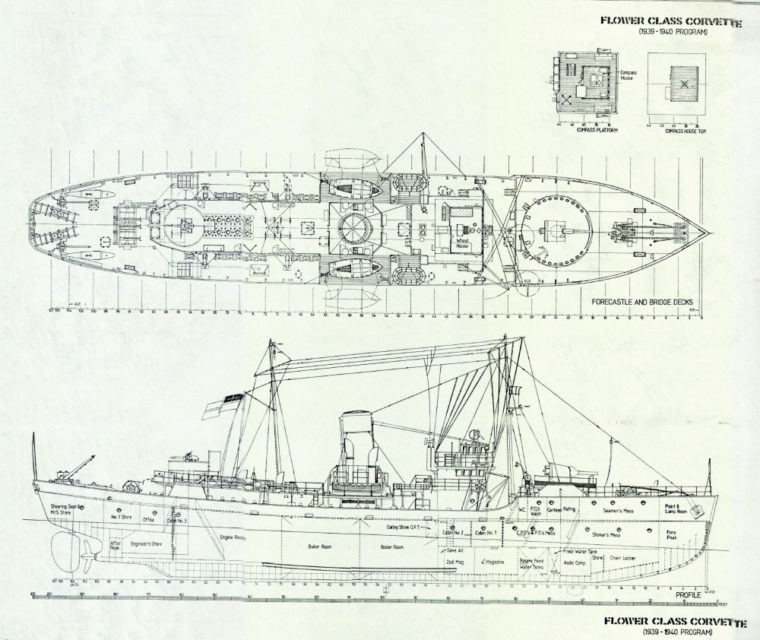
Diagram of the early Flower-class corvettes, via Lt. Mike Dunbar, RN (https://visualfix.wordpress.com/2017/04/12/dreadful-wale-4/)
The Royal Canadian Navy … had originally planned to build its own naval fleet with destroyers and larger ships, but it quickly became apparent that smaller ships were needed to protect major Atlantic ports and naval facilities, and to allow merchant shipping traffic sufficient convoy protection. It was imperative that some sort of small, speedy vessel with anti-sub competency be built and put into use as soon as possible. Corvettes were only intended for use until the larger and better-equipped destroyers and frigates were made available from the British shipyards. …
British shipbuilders at the Smiths Dock Company came up with a design based on a successful whaling ship which could be constructed cheaply in Canada. Thus the corvette was born, untested and unaware that the outcome of the U-boat challenge in the Battle of the Atlantic would rest heavily on its performance. Approximately half of the first order of corvettes produced were used as convoy escorts and over twenty of these workhorses were lost to German subs, but by the end of the war they had effectively proved their worth time and time again.
The name corvette, given to the short, wide-beamed ship by Winston Churchill after a small sailing ship of old, was deemed superior to the original name, the Patrol Whale Catcher. But the RN and RCN had ships in production by 1939*, albeit with slightly different designs. With a length of 205 feet and a 33-foot beam, the small ship was relatively slow at 16 knots, but could turn inside any other ship available. With moderate firepower, including a 4-inch bow gun, a pom-pom gun, several Lewis machine guns, depth charges, and later, Hedgehog equipment, the corvette proved able to tackle the roughest seas. But, as expected, there were shortcomings. They were considered “wet ships”, their decks often awash with water as they rolled, bucked, swerved, and veered violently, with even hardened sailors becoming sea-sick at times.
* This is not quite correct. The first Canadian corvette wasn’t laid down until 2 February, 1940, according to the list of Canadian Flower-class corvettes at Wikipedia.
[Editor’s Note: The armament could vary, depending on what the RCN could scrounge from its own resources or cadge from the Royal Navy:]
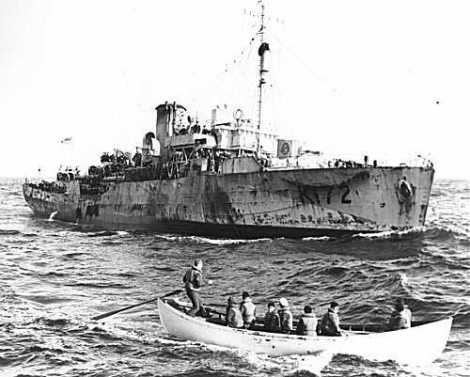
HMCS Trillium, first of the Canadian-built Flower-class corvettes to be completed.
Photo from the Naval Museum of Manitoba, via Wikimedia Commons.
Armament consisted of a 4″ gun on the bow and (if they were lucky) a 2pdr Pom-Pom in a bandstand aft, this was initially rounded off with a pair of Lewis machine guns on the bridge. Many went to sea with a quadruple .50 machine gun mount in place of the 2pdr, and many more Royal Canadian Navy Flowers originally mounted a pair of twin .50s in this position. Eventually 20mm Oerlikons replaced the bridge guns. These early Flowers looked very much like quaint little merchantmen masquerading as warships with their short focsle, merchant type bridge, large vents around the funnel and on the engine room casing.
In The Corvette Navy, James B. Lamb explained why the decision to go with “old fashioned” engineering solutions turned out to be a very good idea in the long run:
Driven by a single three-bladed propeller, she was to have a maximum speed of 16 knots and a really remarkable endurance of 4,000 miles at 12 knots on only 200 tons of oil fuel. Her machinery — four-cylinder triple-expansion reciprocating engines of 2,750 horsepower, and twin cylindrical Scotch boilers — was deliberately kept simple, for ease both of manufacture and of operation, and the whole design was intended from the beginning to be capable of production by every sort of engineering firm other than the big shipbuilders, which were now crammed to capacity with large warship orders. […] But all unrecognized in these plans was a touch of genius; the dowdy maid-of-all-work had been endowed by her Good Fairy with a wholly unexpected range of qualities. For this ship of humble design proved to be capable of amazing versatility, able to carry more than twice her designed complement and a seemingly endless accumulation of ever more sophisticated armament and instrumentation. She could keep the sea in weather that overwhelmed huge merchant vessels and reduced destroyers to water-logged hulks; she could be used for anything from minesweeping to anti-aircraft protection. But, greatest blessing of all, she could turn on a dime, the only Allied warship with a turning circle tighter than that of a submarine, and in consequence she was the master of the U-boat in manoeuvring duels that would foil any other surface escort.
Adaptable and flexible in an ever-changing war, the corvette became the backbone of the Allied escort force, going through endless modification and improvement in the course of the building of no fewer than 269 ships, the largest warship class ever built.
Ultimately she evolved into a new class; two sets of corvette engines were jammed into a lengthened corvette hull to gain a little more speed, and the resulting super-corvette was called a “frigate”. By the war’s end, frigates and corvettes made up almost the entire strength of the Allied escort forces in the Atlantic, and their crews of reservists had brought the techniques of convoy escort and submarine detection and destruction to new heights of expertise.
And on the naming of the Flower-class ships themselves:
Right from the beginning, there was something suspect about corvettes in the eyes of right-thinking professional navy men; what was one to make of a man-of-war that looked like a fish trawler and called itself HMS Pansy? For the Admiralty, in a moment of inspiration, had designated the new ships as the Flower class, a tradition in escort vessels begun in the First World War. Each Royal Navy corvette was named after a flower, and the world was enriched by sea-stained fighting ships glorying in the name of His Majesty’s Ship Pennywort, Crocus, or Tulip. There was a Convolvulus, a Saxifrage, and a Cowslip. But even a Board of Admiralty has a heart; eventually HMS Pansy was allowed a change of name by a repentant Ships’ Names Committee. She became HMS Heartsease.
By the time the Royal Navy had built more than a hundred corvettes, flower names were becoming difficult to come by; HMS Bullrush probably reflects the growing desperation of this latter period, while HMS Burdock and HMS Ling show just how far the naming committee was prepared to cast its net. In Canada, HMCS Poison Ivy was openly conceded to be a possibility, but cooler heads prevailed; the Canadians decided to name their corvettes after towns and villages, although a handful of flower names — Spikenard, Snowberry, Windflower, etc. — were incorporated with ships originally built for the Royal Navy but taken over by the RCN.
It was widely believed in the wartime Allied navies that the naming of the Flower class was part of a form of psychological warfare practised on the enemy by a vengeful Britain; there must be an added [ignomy], it was felt, to being sunk by HMS Poppy, as U-605 was, or to being outfought and captured by a fierce HMS Hyacinth, as was the Italian submarine Perla. It was one thing to perish in the Wagnerian splendour hankered after by Hitler, but quite another for the proud Teuton to be vanquished by Rhododendron, as U-104 was, or sunk by Periwinkle, like U-147.
March 30, 2019
Canada and the Battle of the Atlantic, part 4 by Alex Funk
Editor’s Note: This series was originally published by Alex Funk on the TimeGhostArmy forums (original URL – https://community.timeghost.tv/t/canada-and-the-battle-of-the-atlantic-part-2-edited/1434).
Sources:
- Far Distant Ships, Joseph Schull, ISBN 10 0773721606 (An official operational account published in 1950, somewhat sensationalist)
[Schull’s book was published in part because the funding for the official history team had been cut and they did not feel that the RCN’s contribution to the Battle of the Atlantic should have no official recognition. It is very much an artifact of its era, and needs to be read that way. A more balanced (and weighty) history didn’t appear until the publication of No Higher Purpose and A Blue Water Navy in 2002, parts 1 and 2 of the Official Operational History of the RCN in WW2, covering 1939-1943 and 1943-1945, respectively.]- North Atlantic Run: the Royal Canadian Navy and the battle for the convoys, Marc Milner, ISBN 10 0802025447 (Written in an attempt to give a more strategic view of Canada’s contribution than Schull’s work, published 1985)
- Reader’s Digest: The Canadians At War: Volumes 1 & 2 ISBN 10 0888501617 (A compilation of articles ranging from personal stories to overviews of Canadian involvement in a particular campaign. Contains excerpts from a number of more obscure Canadian books written after the war, published 1969)
- All photos used exist in the Public Domain and are from the National Archives of Canada, unless otherwise noted in the caption.
I have inserted occasional comments in [square brackets] and links to other sources that do not appear in the original posts. A few minor edits have also been made for clarity.
Part 4 — 1940: The fall of France, the battle begins, and the RCN dreams of expansion
Continued from Joseph Schull’s Far Distant Ships:
German infantry and armour were sweeping along the western coast of France, driving into the sea the broken fragments of British and French divisions. Here and there, at isolated bays and harbours, a few battalions of soldiers might be rescued by ship; a few hundreds out of the hundreds of thousands of refugees might be saved. Parties of engineers from England might be landed ahead of the advancing enemy to conduct vitally important demolitions. In this work the Canadian destroyers joined with many British ships.
Restigouche and St. Laurent, at sea on June 9, saw from thirty miles distant the flames of Le Havre rising six hundred feet into the night sky. On June 11 they were off St. Valéry en Caux in the neighbourhood of Dieppe, assisting the British destroyer Broke to embark wounded. Part of the British 51st Division was holding a six-mile line in the vicinity but reported itself “in no immediate need of evacuation.” St. Laurent moved a little way up the coast to Veules and took on board forty French troops. She returned to the neighbourhood of St. Valéry an hour or so later to find Restigouche and the British destroyer still standing by for evacuation.
At about eight o’clock in the morning five or six salvoes splashed into the water a hundred yards from St. Laurent and Restigouche. A German battery had taken up position on the cliffs behind the town and there was no longer any possibility of embarking troops. The three destroyers engaged the battery, although they were unable to observe the fall of their shells behind the three hundred foot cliff. When they broke off after a desultory action, Canadian ships had exchanged their first fire with the German enemy.
In North Atlantic Run, Marc Milner explains the Canadian government’s concerns about protecting the eastern seaboard, initially limiting the number of RCN ships that could be sent to European waters:
Undoubtedly the alteration of this policy owed something to the stationing at Halifax of the RN’s Third Battle Squadron, a force of aged battleships and light cruisers intended to provide anti-raider protection for mercantile convoys and more than sufficient to guarantee a credible deterrence along Canada’s Atlantic coast. The alteration of the previous policy also inaugurated the principle of loaning ships to the RN, which became “for a considerable period the dominant element of RCN policy.”
The government’s change of heart not only suited the navy’s burning desire to join in the “active operations” of more distant waters but was also perhaps a response to growing public pressure for a more active involvement in the war. In April 1940, before the invasion of Norway began, Mackenzie King confessed to his diary that the pride of the nation demanded that Canada increase its military commitment overseas from a single division to a full corps. The slow expansion of the navy could not keep up with the national desire to pick up where the Canadian Corps had left off in 1918. Even Colonel Ralston, the minister of Defence, confessed that the military involvement in the land war would have to grow, although “we could have used our money more effectively if it had been confined to air and naval matters.” Canadians, the prime minister’s private secretary wrote years after the war, remained remote from the war, “despite the very large part Canadian airmen and sailors were taking in actual combat,” until the army landed in Sicily in July 1943.
On June 21, the day of France’s humiliation at Compiègne, HMCS Fraser was sent far down the west coast near the Franco-Spanish frontier, to land a Royal Navy evacuation party and to patrol off St. Jean-de-Luz, one of the last remaining French ports unblocked by German forces (this was part of Operation Aerial, the evacuations from the west coast of France). At dawn on the 23rd she was sent north to Arcachon to pick up Canadian and South African diplomats. Transferring them from the sardine fishing boat they had escaped in was no easy task, but eventually all were delivered safely aboard and then transferred to the cruiser HMS Galatea for transport back to England. Fraser returned to St. Jean-de-Luz and was joined by Restigouche and several British destroyers. “The melancholy tumult of evacuation was now fully underway. Boatloads of defeated soldiers and destitute civilians were streaming out from the jetties to the liners, tramp steamers, trawlers and pleasure craft which jostled each other in the rough waters of the harbour. Destroyers threaded a dangerous way among the thronging ships, marshaling the loaded vessels into groups for escort to England while other destroyers zigzagged outside on anti-submarine patrol.” In the dreary 48 hours of the St. Jean-de-Luz evacuation, 16,000 soldiers escaped.
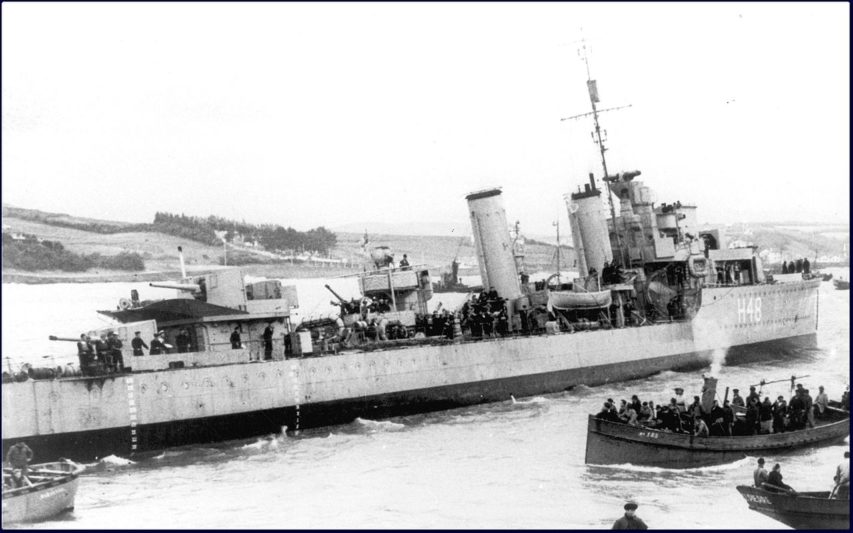
HMCS Fraser (H48), commanded by Commander W.B. Creery, on the 25th of June, 1940 off St. Jean-de-Luz, three days before her loss.
Photo from the Canadian Navy Heritage Project, via Wikimedia Commons.
Rear Admiral W.B. Creery, at the time commanding officer of the Fraser, described the final evacuation to Reader’s Digest years later:
The Germans occupied Bordeaux and swept south. By the morning of June 25th, they were within 25 miles of St. Jean-de-Luz. The French, to conform to the armistice terms, had advised that all evacuation must cease by 1 p.m. Fraser had been ordered to remain in harbour during the final evacuation but we had difficulty finding a safe anchorage. We had to re-anchor twice. on the last attempt we held firm — for a reason we were not to discover until later.
We decided to remain where we were until the return of Sub-Lieutenant William Landymore who had been sent away in our motorboat to try and persuade some Belgian trawler skippers to sail to England instead of Spain. Suddenly the officer of the watch, who had a slight stammer, exclaimed “G-G-Good G-G-God, there’s a g-g-gun!” I looked where he was pointing. On a hill a small force of soldiers had appeared with a field gun and a tank. We couldn’t make out their nationality, but ships in harbour are sitting ducks and there was only one thing to do. We ordered the merchant ships to proceed to sea and had to watch several boatloads of evacuees turn sadly back to shore. Our motorboat returned and Landymore sent the boat’s crew swarming up the falls but remained in the boat himself. I was anxious to go to action stations and weigh anchor but it took all hands to hoist the boat.
All was going reasonably well until a steadying line parted, the boat canted sharply outboard and Landymore was catapulted into the sea. Just as this happened I was told the anchor had apparently fouled a cable on the bottom of the harbour and could not be hoisted. And the officer of the watch reported that there were now “a number” of field guns on the hill and they appeared to be taking aim at us. So we fished Landymore out of the sea, slipped our cable and departed in haste if not in dignity.
The merchant ships headed for England, escorted by several RN destroyers. Fraser and Restigouche were ordered to join the British cruiser Calcutta in a sweep north in search of an enemy ship of which there had been a vague report. No such ship was found and toward dusk the flag officer turned his small force toward home.
Joseph Schull continues this particular narrative in Far Distant Ships:
It was now about ten o’clock in the evening, with a fresh breeze, a moderate swell and visibility of one and a half miles. Fraser was off the starboard bow of Calcutta a mile and a half distant, Restigouche was on the cruiser’s port quarter a mile and a half to the left of her and slightly astern. The ships were travelling at high speed, with the possibility of attack by submarine or from the air at any time. They had been in continuous action for nearly a week, carrying on rescue work and embarking troops and refugees under threat of submarine attack, air attack and every harassment of a general evacuation. Fraser‘s commanding officer had had one night’s sleep in the preceding ten and there is little likelihood that the captain of the Calcutta had had more.
As the ships steamed on, just visible to each other in the darkness, Calcutta signalled for “single line ahead” and Fraser altered course to comply. Her commanding officer’s intention was to turn inward toward Calcutta, run back down to starboard of her and come into station astern. On the cruiser’s bridge, however, when the dim silhouette of Fraser was seen altering to port ahead, the assumption was made that she intended to come across Calcutta‘s bows and pass down her port side. At the speed the ships were making, the destroyer would had had little room to cross in front; and Calcutta‘s captain therefore ordered a sharp turn to starboard; at the same time giving the order for one blast to be sounded on the siren.
The turn to starboard by the cruiser and the turn to port by the destroyer put the two ships on courses converging with fatal rapidity. Calcutta‘s signal blast for a starboard turn was Fraser‘s first warning of approaching disaster; and nothing could now be done to avert it. The vessels were swinging under helm and moving together at a combined speed of thirty-four knots. Engines were put astern and wheels reversed but no order could take effect in time. The ships covered the last two hundred yards intervening between them in less than eleven seconds and Calcutta, still swinging to starboard, sheared her way through the forward part of Fraser. The destroyer’s forepart broke clean off and floated away bottom up. Her entire bridge, with the captain and bridge personnel, was lifted onto Calcutta‘s bow and remained there, swaying and groaning above the cruiser’s forecastle.
Restigouche was in station about fifteen hundred yards astern of Calcutta. With the crash of the impact she raced up alongside Fraser and worked her way inward toward the afterpart of the broken ship. Rocking in a heavy swell which threatened to dash her against the jagged mass of steel, Restigouche brought her stern around to touch the stern of Fraser. While the hulls of the two ships ground perilously together, sixty of Fraser‘s crew, including one stretcher case, were safely transferred. For the men already in the water, Restigouche and Calcutta lowered boats, dropped carley floats and let down scramble-nets along their sides.
Fraser‘s bow had floated away, carrying the cries of its marooned occupants into the darkness. Restigouche coming up from astern, had at first mistaken it for a half-submerged wreck. When she identified it for what it was, she endeavoured to work alongside, but just as she was approaching, the bow capsized. The men clinging to the guard-rails were thrown into the water and had to be picked up by the ships’ boats. Altogether, in spite of darkness and a rising swell, 16 officers and 134 men were rescued. Forty-seven Canadians and nineteen British sailors were lost.
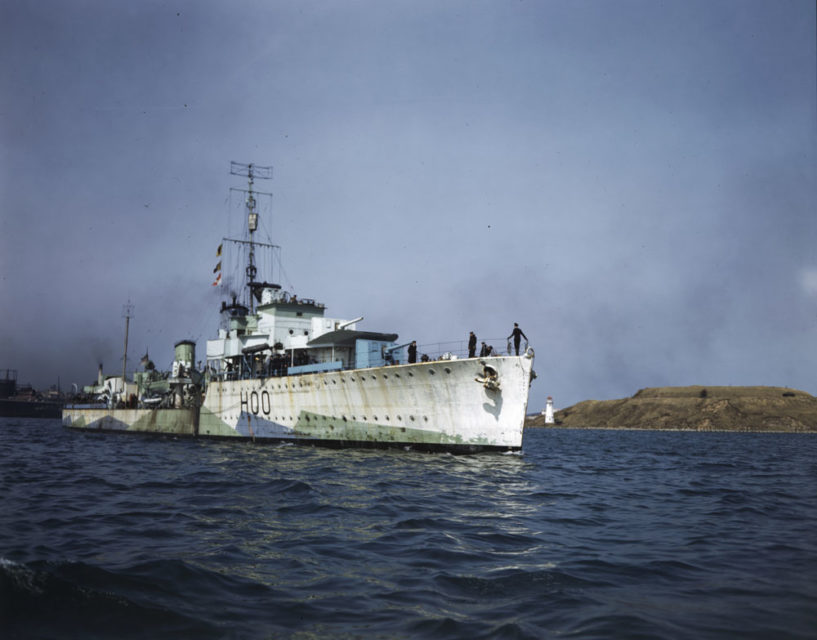
The River-class destroyer HMCS Restigouche, May 1942.
Canada. Department of National Defence / Library and Archives Canada / ecopy.
Schull continues in Far Distant Ships:
The loss of Fraser, heavy blow though it was for the navy and for the homes of forty-seven Canadians, was a minor incident of those disastrous days; one of the casualties which were as certain to occur under conditions of prolonged and incessant strain as under direct shellfire. Nor could it be lingered upon. …
Skeena, Restigouche, and St. Laurent now turned with scores of British ships to a desperate battle for convoy routes through the southwestern approaches. The U-boats were beginning to arrive in greater numbers; the Luftwaffe was everywhere over the channel and far out to sea. The great ports of the south and east were under constant attack; in their scanty hours in harbour between U-boat hunts and the rescue of survivors from sunken vessels, Canadian destroyers landed men to assist in combatting air raids.
[Editor’s Note: By early July the Admiralty faced the hard decision to re-arrange the whole supply system that Britain now depended upon for food, fuel, armaments, and ammunition. The large southern and eastern ports were under bombing attack frequently enough to rule out receiving and unloading merchant convoys, without risking unacceptably high ship losses. The ports on the Mersey and Clyde rivers, being further away from German airfields, must accept the majority of the cargo from North America and elsewhere. The convoys had to be routed through the northwestern approaches, minimizing the risk of air attack. The escort vessels also had to shift to their new operational area; the remaining three Canadian destroyers in British waters would now operate from Liverpool, Greenock, Rosyth, and eventually Londonderry (where new port facilities were being hurriedly constructed).]
March 29, 2019
Canada and the Battle of the Atlantic, part 3 by Alex Funk
Editor’s Note: This series was originally published by Alex Funk on the TimeGhostArmy forums (original URL – https://community.timeghost.tv/t/canada-and-the-battle-of-the-atlantic-part-1-edited/1433).
Sources:
- The Far Distant Ships, Joseph Schull, ISBN 10 0773721606 (An official operational account published in 1950, somewhat sensationalist)
[Schull’s book was published in part because the funding for the official history team had been cut and they did not feel that the RCN’s contribution to the Battle of the Atlantic should have no official recognition. It is very much an artifact of its era, and needs to be read that way. A more balanced (and weighty) history didn’t appear until the publication of No Higher Purpose and A Blue Water Navy in 2002, parts 1 and 2 of the Official Operational History of the RCN in WW2, covering 1939-1943 and 1943-1945, respectively.]- North Atlantic Run: the Royal Canadian Navy and the battle for the convoys, Marc Milner, ISBN 10 0802025447 (Written in an attempt to give a more strategic view of Canada’s contribution than Schull’s work, published 1985)
- Reader’s Digest: The Canadians At War: Volumes 1 & 2 ISBN 10 0888501617 (A compilation of articles ranging from personal stories to overviews of Canadian involvement in a particular campaign. Contains excerpts from a number of more obscure Canadian books written after the war, published 1969)
- All photos used exist in the Public Domain and are from the National Archives of Canada, unless otherwise noted in the caption.
I have inserted occasional comments in [square brackets] and links to other sources that do not appear in the original posts. A few minor edits have also been made for clarity.
Part 3 — The professionals and the amateurs
Marc Milner picks up the story in North Atlantic Run:
While the operational side of the navy chafed at the bit, the shore side got on with the daunting work of expansion. The first task was to provide both personnel and ships for the system of defended ports. Acquisition of the ships was a manageable problem, though the results were far from satisfactory. By the end of 1939 the RCN had managed to beg, borrow, or buy over sixty auxiliary vessels of all shapes and sizes, enough to fill out the minesweeping, anti-submarine, and harbour duties of the defended ports. Many of the ships were unreliable or unsuitable for their assigned roles and therefore badly needed replacement. In fact, few were worthy of long-term service in any but the most menial tasks.
The bulk of the auxiliary vessels taken into the RCN came from other government departments. Manning them posed no problem because most of the ships’ crewmen transferred to naval service, enlisting in the RCN Reserves, Special Service, which respected their peculiar skills (for example, ice clearance). Retired officers of the Royal Navy resident in Canada, of whom about forty were designated for duty with the RCN, also helped fill the gap in manpower.
[Editor’s Note: In general, the regular RCN consisted of professional officers and ratings who planned to continue in the navy after the war. The RCNR were professional seamen in civilian life who would return to their profession at the end of hostilities. RCNR men were highly prized in the navy for their sea-going skills. The RCNR Special Service was (I believe) just a designation for RCNR officers and ratings who had specialized skills, like icebreaking experience, over and above ordinary merchant navy experience. The RCNVR were “hostilities-only” volunteers, with a core of longer-term reservists who had some limited experience before the war. RCNR and RCNVR officers had slightly different rank insignia than RCN officers, as summarized by the Canadian Military Police Virtual Museum:]
Regular Officers in the RCN wore gold stripes on their epaulettes or on the cuffs. The uppermost stripe incorporated the “Executive Curl”. This was a holdover from the early days of the Royal Navy when officers responsible for ship handling and command were separate from other officers such as Surgeons and Engineers. Engineers were granted the curl in 1915 and by 1919 the rest of the branches had been granted it.
Officers of the Royal Canadian Navy Volunteer Reserve (RCNVR) wore similar rank insignia to those of the Regular Navy, however the stripes were of a different pattern, being a zig zag design. This of course lead to the RCNVR being nicknamed the “Wavy Navy”. [The epaulette on the left is of an RCN Lieutenant Commander. The one on the right] is that of an RCNVR Lieutenant Commander. Officers of the Royal Canadian Navy Reserve (RCNR) [in the middle] wore another special pattern of rank stripes. In this case, the curl resembled a Star of David. An RCNR Lieutenant’s rank is illustrated. These patterns of special insignia were discontinued in the mid 1950’s, after which Regular and Reserve Officers wore identical rank insignia.
Marc Milner continues:
With the dispatch of the second — and final — draft of volunteer reservists (RCNVR) to the coast on 10 September, the RCN exhausted its cadre of readily available and “trained” personnel. The first plan for further mobilization was tabled on 17 September and called for an active strength of 5,472 all ranks by the end of March 1940, rising to seven thousand by the same date in 1941. As with other personnel projections in the early months of the war, this first one was based on the needs of home defence and the availability of ships. The RCN proved rather successful at cobbling together its auxiliary fleet, and the projections for March 1940 were surpassed much earlier. Yet, despite this early trend towards rapid growth, expansion in 1939 and 1940 was choked by shortages of every conceivable type. Sailors went without proper naval uniforms because no one foresaw, at the end of 1939, that the navy’s strength would rise to ten thousand by September 1940. Further, until 1943 the “key to expansion” as the Naval Staff liked to call it, was the shortage of training staff, a shortfall which the RN unwilling to help alleviate.
What the navy badly wanted were skilled men: men whom they were losing in large numbers to the other two services, particularly the air force. For the RCN did not even have the necessary housing to take in the throngs of eager and qualified volunteers waiting to join up. The problem occasioned debate at the first Naval Staff meeting in January of 1940. The urgent need for temporary accommodation was stressed, “in order that recruiting programme could be proceeded with before the new rapidly expanding RCAF seized all the best — and particularly most skilled, men”. The RCN also found that it had to lower the minimum age of entry from twenty-one to nineteen in order to counter the ravages of the air force on available manpower.
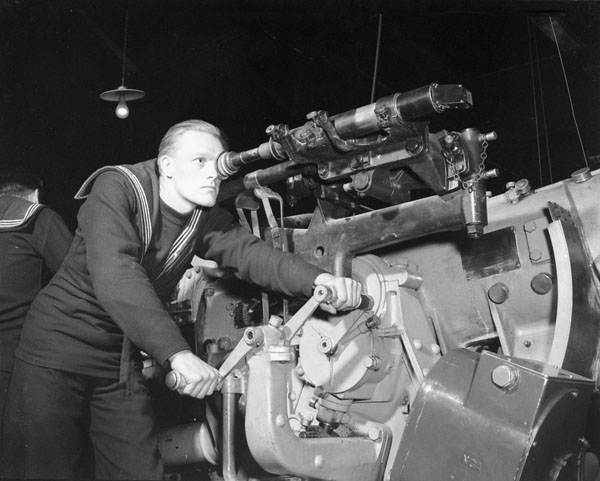
RCN rating operating the training mechanism of a 4.7-inch gun, Royal Canadian Navy Gunnery School, Halifax, Nova Scotia, 1940.
Canada. Dept. of National Defence / Library and Archives Canada / PA-104416
Despite the struggle over manpower and the navy’s reluctance to expand too quickly, the growth of the navy soon acquired a snowball effect which it seemed incapable — or perhaps undesirous — of firmly controlling. At the end of 1939 the Naval Staff anticipated a completed wartime strength (after three years) of 1,500 officers and 15,000 ratings. This figure was reached and passed in half the time. But the really hectic pace of expansion did not begin until after the fall of France and Norway. Up to that point the RCN had planned a very deliberate and selective growth, as Vice-Admiral Nelles, Chief of the Naval Staff (CNS), explained to the naval minister in January 1940.
Macdonald had broached the subject of giving preferences in RCNVR commissions to members of prominent yacht clubs. In an illuminating statement Nelles made it clear to the minister what role “Sunday Sailors” would play in Canada’s war at sea. “The RCN is in need of many men before this war is over,” Nelles wrote, “but the [types] of ships suitable to Canadian service conditions [Tribal-class destroyers or small inshore-patrol ships] are more suited to the employment of professional seamen than of amateur small boat yachtsmen.” The CNS’s comment was no idle remark on an easily dismissed subject. Earlier in the same day Nelles had received a memorandum from his director of Naval Personnel, who, no doubt responding to the minister’s inquiry, refused to countenance the mythical value of “Sunday Sailors”. Yachting, the DNP reported to his chief, had about as much to do with modern naval skills as flying a kite had to do with modern air operations. None the less, in order to find employment for these eager warriors, Nelles informed Macdonald that he was prepared to release fifty young yachtsmen to the Royal Navy “to serve in the more interesting appointments overseas and represent Canada at the scene of active operations”. His words suggest clearly what Nelles and the navy felt of keeping the fleet in home waters. In terms of manpower this option offered an alternative to simply turning recruits away, and they would not be lost to either Canada or the war effort. The loan scheme was approved, and it was initially decided to send all RCNVR recruits in excess of 4,500 to serve in the RN. Though this plan was later drastically altered, the incident illustrates the selective nature of the navy’s expansion before the fall of Western Europe, the desire to participate in the “active” theatre, and the problems inherent in trying to expand from too small a base.
Back at sea, the phony war was one of drudgery for the RCN, aside from its participation in the capture of the SS Hannover in the Caribbean. Shuttling convoys back and forth between the defended ports of Canada to meeting points offshore, the odd troop transport across the ocean, coastal convoys between ports. All essential, but not the work the navy had been hoping for.
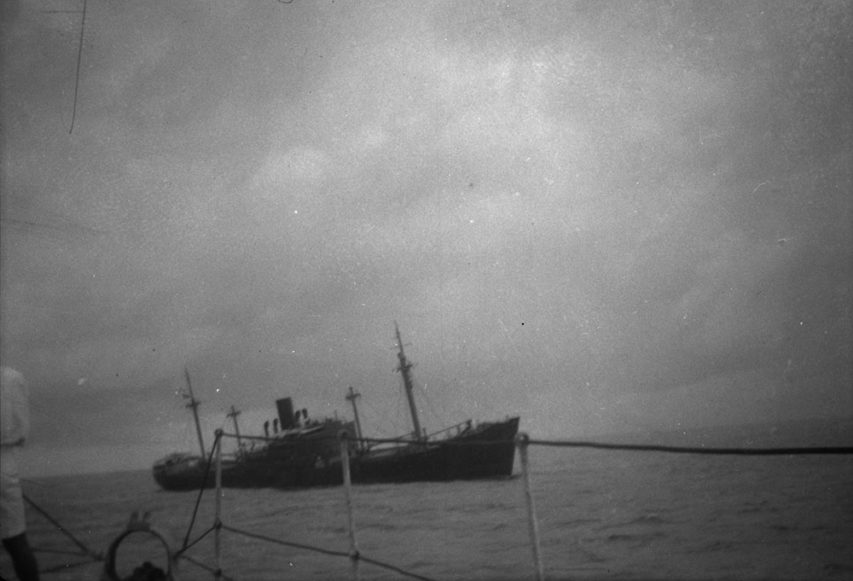
HMS Dunedin and HMCS Assiniboine intercepted the blockade runner SS Hannover in early March, 1940. Later, this vessel was converted into an escort aircraft carrier, HMS Audacity.
Canada. Dept. of National Defence / Library and Archives Canada / PA-104055
They got their wish soon enough. The phony war ended quite spectacularly in the spring of 1940, and a request was sent from London to Ottawa for “all available destroyers”, even as the BEF fought to disengage itself and form a secure position from which to evacuate. The cabinet eventually more or less agreed, even thought it meant virtually stripping Canada herself of naval defenses.
The fall of France left some senior Canadian politicians, Mackenzie King among them, more concerned than ever for the vulnerability of Canada’s vast coastline. However, both the Canadian Chiefs of Staff and the British, including Prime Minister Churchill (by whose opinion Mackenzie King set great store), were able to convince the Canadian prime minister that Canada’s first line of defence was the English Channel.
The navy mustered four destroyers for travel to Europe. Joseph Schull writes of their departure and first subsequent action in Far Distant Ships:
In Halifax, on the afternoon of the 24th [of May], the Canadian destroyers Restigouche, Skeena and St. Laurent were preparing to go to sea on an unscheduled voyage. Leaves had been cancelled, libertymen summoned back to their ships and all prospect of an Empire Day celebration ruined with truly naval efficiency. The mood on board St. Laurent was particularly black, as she had been recalled from one convoy and was under orders for sea again before a man could step ashore. The mess deck “buzz”, discredited and discouraged by nine months of unvarying monotony, gave promise only of another local convoy run. If there was any bright feature of the day it must have been the mild spring weather which had enabled the men to relieve their crowded mess decks by sending heavy clothes and miscellaneous cold weather gear ashore.
With early evening came the familiar “cable party fall in” and the equally familiar call for sea dutymen to muster. The destroyers nosed their way out of the harbour while men on watch speculated without much curiosity over the fact that there appeared to be no convoy in evidence.
The explanation came several hours later. There was to be no convoy this time and no turning back to Halifax after twenty-four hours. The lambie coats left in Halifax would not be seen by their owners for a considerable time. An urgent cable from the United Kingdom had arrived at Ottawa the day before. Invasion was an imminent possibility and every ship which Canada could send was required in British waters.
Restigouche, Skeena and St. Laurent were on their way. Assiniboine and Ottawa were in refit in Halifax and would not be operational until about the middle of June. Saguenay could not make the crossing as she was also badly in need of refit. Fraser, en route to Bermuda, had been assigned to the Jamaica Force of the Royal Navy in March to conduct Caribbean patrols. En route to Bermuda, had been ordered to continue her voyage, refuel at Bermuda and proceed directly to the United Kingdom.
The first wartime passage of the three destroyers was uneventful but scarcely monotonous. By day and by night the men went through intensive air raid and anti-submarine exercises. The commanding officer of Restigouche saw the efficiency of his ship increase rapidly during the voyage and suggested that the improvement “was no doubt accelerated by the realization of the ship’s company that we were rapidly approaching an extremely active war zone.”
It may well have been so. While still a day’s steaming from the United Kingdom the ships were ordered to a position of Ushant on an abortive submarine hunt; and when they finally secured at Plymouth on June 1 the evacuation of Dunkirk was at its height. The First Lord of the Admiralty found time for cordial words to the newcomers:
The presence of units of the Royal Canadian Navy in our midst inspires us all to a still harder effort. Confident both of your skill and of your valour we wish you good luck in the fierce and exacting toil which lies before you.
March 28, 2019
Canada and the Battle of the Atlantic, part 2 by Alex Funk
Editor’s Note: This series was originally published by Alex Funk on the TimeGhostArmy forums (original URL – https://community.timeghost.tv/t/canada-and-the-battle-of-the-atlantic-part-1-edited/1433).
Sources:
- The Far Distant Ships, Joseph Schull, ISBN 10 0773721606 (An official operational account published in 1950, somewhat sensationalist)
[Schull’s book was published in part because the funding for the official history team had been cut and they did not feel that the RCN’s contribution to the Battle of the Atlantic should have no official recognition. It is very much an artifact of its era, and needs to be read that way. A more balanced (and weighty) history didn’t appear until the publication of No Higher Purpose and A Blue Water Navy in 2002, parts 1 and 2 of the Official Operational History of the RCN in WW2, covering 1939-1943 and 1943-1945, respectively.]- North Atlantic Run: the Royal Canadian Navy and the battle for the convoys, Marc Milner, ISBN 10 0802025447 (Written in an attempt to give a more strategic view of Canada’s contribution than Schull’s work, published 1985)
- Reader’s Digest: The Canadians At War: Volumes 1 & 2 ISBN 10 0888501617 (A compilation of articles ranging from personal stories to overviews of Canadian involvement in a particular campaign. Contains excerpts from a number of more obscure Canadian books written after the war, published 1969)
- All photos used exist in the Public Domain and are from the National Archives of Canada, unless otherwise noted in the caption.
I have inserted occasional comments in [square brackets] and links to other sources that do not appear in the original posts. A few minor edits have also been made for clarity.
Part 2 — The Admiralty takes control
On August 26, just a few days before the official outbreak of war, a single word Admiralty telegram was received in Ottawa from London: FUNNEL. With that message all British merchant vessels passed under Admiralty control. The same transfer took place in Canada on the same day. No Canadian-registered ship, no merchant ship in any Canadian port could sail without the authority of the Royal Canadian Navy. Naval control officers faced an enormous task. All British merchant vessels in North American waters would have to be gathered in from the wide face of the sea, assembled, bunkered, stored, provided with codes and orders. Vessels of every type would have to be formed into orderly fleets, sailed at precise times and by specified routes with the precision of a crack railway, all in absolute secrecy. Halifax stirred once again with the grim vitality of a key port in a world at war. Ships put in, their schedules interrupted, their captains angry, demanding explanations they didn’t get. Painting parties descended to defile clean white ships with the drab gray of military vessels. Old naval guns were mounted on merchantmen and a few ships were issued machine guns.
[Editor’s Note: Unlike the Royal Navy’s comparatively vast administrative resources for organizing convoys, the RCN had to draw heavily upon a small number of retired RN and RCN officers living in Canada and the United States to gather enough officials to establish convoy control in Canadian ports (the same pool would also be used to recruit convoy commodores). It’s difficult for modern readers, used to networked computers with online databases, to realize just how much literal paperwork had to be created and maintained from scratch to even begin organizing the convoy system from North America to the UK: that it was done at all is amazing. That it was done about as well as could be hoped is incredible.]
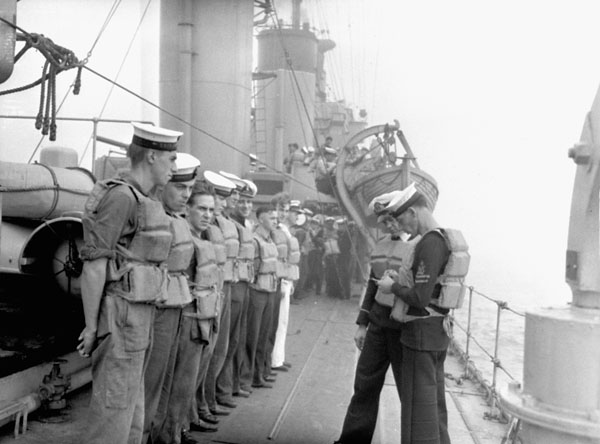
Ratings mustered along the starboard side of HMCS Assiniboine at sea, ca. September 1940.
Canada. Dept. of National Defence / Library and Archives Canada / PA-104105
On August 31st HMCS Fraser and St. Laurent were re-deployed to the east coast from the west coast.
On September 16th, six days after Canada declared war, the destroyers St. Laurent and Saguenay moved out through the Halifax approaches. Following behind were the 18 merchant ships of convoy HX-1, Halifax to the UK. Awaiting them offshore were the Royal Navy cruisers HMS Berwick and HMS York. The crossing was uneventful, but these 18 were the first of a grand total of 25,343 merchant vessels that would sail from North America under Canadian escort.
To briefly discuss the convoy system itself, it’s fairly simple: merchant vessels sail in organized groups rather than on their own and are provided some form of naval escort to protect them from hostile vessels. Even lightly guarded convoys are immensely preferable to ships sailing on their own, reducing the width of the target area and forcing any potential attacker to weigh the risk of counter-attack by the escorts. [Editor’s Note: It may seem odd to landlubbers like most of us, but even a large convoy is not much easier to find than a single ship in the wide ocean. Fewer discrete targets requires more search time by enemy submarines and surface raiders.] The speedier the convoy, the better, but the limited speed of many of the merchant ships necessitated a system of fast and slow convoys with different starting points in the Americas, and different codes for identification. The merchant vessels are described by Alan Easton, captain of the corvette HMCS Baddeck in 50 North: Canada’s Atlantic Battleground [Easton’s book is factual in most ways except for the dialogue and some of the names being changed]:
We sailed to Sydney, Nova Scotia. There we spent the night, topped up with fuel and stood out of the harbour early the next morning, where we were to await the convoy we had been instructed to escort. Many ships were lying at anchor that morning in the fine, land-locked harbour, ships of numerous different Allied and neutral nations, for this was the assembly port for the eastbound slow Atlantic convoys in those days. As we moved back and forth off the harbour mouth, I fell to examining the ships as they came out, one behind the other at intervals of three or four minutes, led by the Commodore’s ship. It was always intensely interesting to me to gaze at the ships. The more weatherbeaten and decrepit the ship, the more attractive she was to me; she had a story to tell and I could sometimes discern a part of it by just looking. The newest might have been ten years old, the oldest perhaps forty or fifty. Some were built of iron — the inch-thick plating of the 1880s, before the days of steel. They were large and small, from about nine hundred tons to nine thousand. You could tell almost at a glance their nationality, or the country in which they were built, by the shape of their hulls and the construction of their upperworks. But as they came out they flew their ensigns, soon to be hauled down, so that you could not mistake their identity. They were all heavily laden, few that were not down to their Plimsoll marks and some with little freeboard, perhaps four feet between the water and the well deck.
The first ship moved slowly, marking time as it were, to allow the others to take their stations, so that the whole could form into three columns. Soon after noon, the Commodore seemed to be satisfied that all were in their correct places for he ran up a flag hoist indicating that the speed of the convoy was to be seven knots. When every ship had signified that she understood his signal, the Commodore hauled his flags down and the engines of this heterogeneous collection of vessels simultaneously moved faster, although to the onlooker there was no perceptible change in speed.
The fast/slow system was implemented fairly early on, and by August 1940 slow convoys were more often being formed in Sydney, Nova Scotia, the faster convoys in Halifax. By 1941, fast convoys left every six days and made the crossing in around 13 to 14 days. Slow convoys left every six days as well, but took 16 to 17 days to cross. The size of the convoys varied. The largest convoy to ever make the crossing was HXS-300 consisting of 167 ships, but a good benchmark was 40 or so merchant vessels. These ships are positioned in a grid with nine columns, 920 metres apart, and in each column five ships, 550 metres apart. Ships carrying dangerous cargoes, such as gas, fuel, or explosives are placed in the centre, the position that affords the most protection against enemy torpedoes. The convoy commodore, in most cases a retired naval officer, is on board one of the merchant ships to take defensive measures as required and ensure coordination with the escort.
[Editor’s Note: An image from Swansea Docks showing the schematic arrangement of slow convoy ONS-154 returning to Halifax later in the war:]
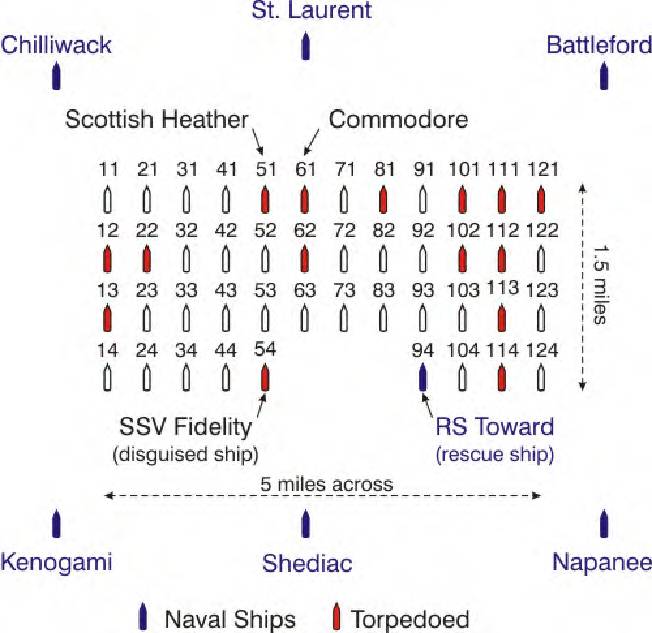
Convoy ONS-154 in December, 1942. The numbers indicate the column and row designations for each merchant ship in the convoy.
Image by Ron Tovey, Swansea Docks – click the image to visit his site.
The following system of codes was used for identification of trans-Atlantic convoys:
HX: Fast convoys (9 knots or over) sailing from Halifax (or later New York)
SC: Slow convoys (under 9 knots) sailing from Sydney, Halifax, or New York
ON: westbound convoys sailing from Great Britain to North America
ONS: slow westbound convoys sailing from Great Britain to North America
The following system of call letters was used for identification of coastal convoys:
BX: Boston to Halifax
XB: Halifax to Boston
SQ: Sydney to Quebec City (via the St. Lawrence River)
QS: Quebec to Sydney
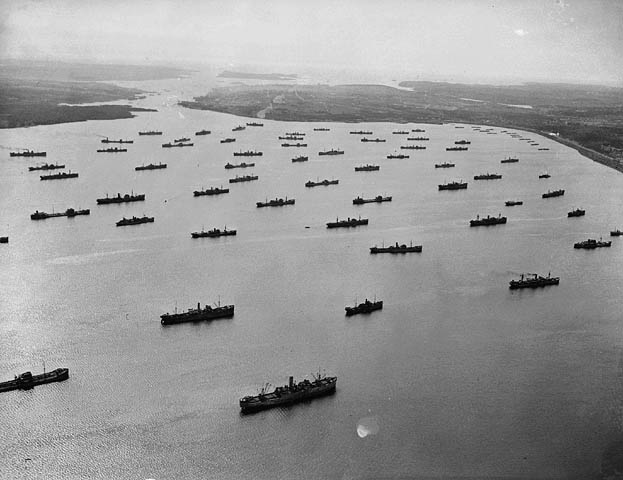
Convoy forming in Bedford Basin, 1 April, 1942
Canada. Dept. of National Defence / Library and Archives Canada / PA-112993
There was much debate among Canadian politicians as to the role Canada would play in the war in general. In the first few weeks, much debate was had as to which services would receive what money, and how they would be integrated into the allied war effort. Prime Minister Mackenzie King had somewhat sold the war to the nation as being different from the last war [Editor’s Note: where Canada provided an over-strength army corps for the Western Front, suffering nearly 60,000 combat deaths, slightly more than the US combat losses in that war]. Finance Minister J. L. Ralston publicly envisaged a program that would be “practical rather than spectacular”. The Prime Minister spoke of protecting Canada by sending food and raw materials to Britain and building a navy and air force and munitions industry, even the first musings of what would become the BCATP [British Commonwealth Air Training Plan] (though these early plans paled in comparison to what it would eventually become.) Canada would contribute vast amounts of resources to the allied cause, but there was not going to be a need for a large land army to fight and die in Europe. The army was just as short of equipment as the navy was and the air force consisted of 3100 men and 270 mostly obsolete aircraft, with just 19 modern Hurricanes. The old issue of conscription that had led to riots in Montreal in 1917 immediately reappeared, and an important provincial election in Quebec had been called within two weeks of the declaration of war in almost direct response to it. [Editor’s Note: The risk of another conscription crisis haunted the Canadian government from the very start of the war: English Canada was heavily in favour, but Quebec was just as opposed, and the ruling Liberal Party couldn’t risk losing their support in Quebec.] What soldiers Canada did have departed Halifax as part of convoy TC-1 in early December, and by the end of the month Canada had 15,000 men in England (the 1st Canadian Infantry Division).
It is the opinion of my sources that the idea of a limited war were extremely favorable to the navy and air force in the early months. Canadian naval vessels and aircraft fighting alongside the United Kingdom was seen as an appropriate contribution, whilst at the same time, seen as far less costly in terms of lives than a large expeditionary army, which Mackenzie King was steadfastly opposed to (fear of conscription crisis was ever present). Canada’s merchant fleet was at Britain’s disposal without question, combined with the vast natural resources she could provide, quite nicely rounded out the “limited war” concept. Industrial military capacity was small, almost non-existent, and building ships, aircraft and munitions would help it grow.
Focusing specifically on the navy itself, what few ships it had were immediately deployed on patrols and put to work escorting coastal convoys within coastal waters, and trans-Atlantic convoys to a handover point mid-voyage. The reserves were activated and sent to the coasts. In November all the Canadian destroyers were placed under the command of the Royal Navy’s North America and West Indies station (somewhat to the Government’s dismay, although not the navy’s: most RCN officers had close peacetime ties to the British squadron and felt it was the natural choice. They had actually requested this at the start of the war and had been refused by the government, who wanted the RCN’s ships kept close to home.) This placement also had the benefit of assuring the RCN that they would participate in the types of operations they had trained for; fleet work, or sweeps for surface raiders. October 1939 saw the purchase of a another destroyer, re-named HMCS Assiniboine in Canadian service. These seven River-class destroyers would form the backbone of the navy well into 1943. A modest attempt had been made in 1938 to give Canadian yards some experience building warships with a minesweeper program. Despite the dispersal of the contracts to both Atlantic and Pacific yards for four Fundy-class minesweepers, the Canadian shipbuilding industry was unprepared for the demands wartime was to make of it.
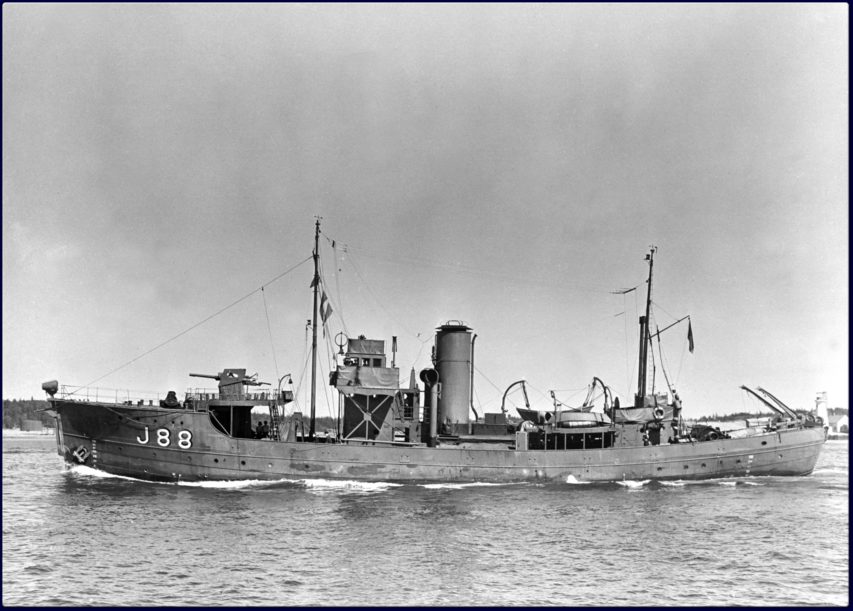
Undated photograph of RCN minesweeper HMCS Fundy (J88).
Canadian Navy Heritage website. Image Negative Number NP-1404 via Wikimedia Commons.
In North Atlantic Run, Marc Milner discusses the Ottawa front of the RCN’s early wartime struggles:
In the government the navy actually had a friend, as it discovered when planners began to submit estimates for expansion. As the late Admiral L.W. Murray, RCN (in September 1939, the Director of Operations and Training) recalled, the navy was given a carte blanche to plan its growth over the succeeding four or five years. When in February 1940 Murray and the deputy minister presented the first wartime naval estimates before the Finance Committee of the cabinet, they passed despite a “fine-tooth comb” inspection. The fact was that the navy’s expansion and its attendant shipbuilding programs suited the government’s intention to profit from what was seen as a limited European war. The prime minister, W.L. Mackenzie King, was steadfastly opposed to fielding yet another large army in Europe, which might lead to high casualties and a call for conscription. Rather, his government sought to channel Canada’s war effort into the sinews of war and into much less personnel-intensive services such as the air force and the navy. Both of these services also offered excellent opportunities for the development of Canadian industry.
The link between industrial and naval expansion also went deeper than simply the building of ships. In July 1940, the expansion of the navy was given impetus by the appointment of a separate minister of Defence for the Naval Service. King chose Angus L. Macdonald, former premier of Nova Scotia. Although once rather uncharitably described as “lightweight”, Macdonald was extremely popular in his home province and a strong voice for Nova Scotia in Ottawa. Macdonald and two other prominent Nova Scotians, Colonel J.L. Ralston, the Minister of Defence, and J.L. Ilsley, the Minister of National Revenue, formed the right wing of King’s cabinet — what J.W. Dafoe called the “Tory Imperialists”. All supported a full war effort, a position that led in 1944 to a bitter break between King and the two defence ministers over the issue of conscription. But apart from Macdonald’s desire to see Canada fully represented at the front, he shared many of King’s beliefs, including the notion that the preservation of the free world depended upon the retention of power in Canada by the Liberal Party.
Macdonald also believed that Canada could and should progress industrially from the war. Long a crusader for the re-industrialization of Nova Scotia, he saw an opportunity to funnel some of government investment into his own province. There was, moreover, a direct link between industrial growth and a large navy. “What use could it be to increase our agricultural production … or to put forth the magnificent industrial effort that we have,” Macdonald asked in 1945, “unless this food and these munitions could be got safely across the sea?” Although in the end he failed to restore to Nova Scotia its past lustre, this was precisely the rationale used to justify building destroyers in Halifax during the war. In the most fundamental sense, then, the aspirations of the [full-time, professional] navy and the government coincided.
March 27, 2019
Canada and the Battle of the Atlantic, part 1 by Alex Funk
Editor’s Note: This series was originally published by Alex Funk on the TimeGhostArmy forums (original URL – https://community.timeghost.tv/t/canada-and-the-battle-of-the-atlantic-part-1-edited/1433).
Sources:
- The Far Distant Ships, Joseph Schull, ISBN 10 0773721606 (An official operational account published in 1950, somewhat sensationalist) [Schull’s book was published in part because the funding for the official history team had been cut and they did not feel that the RCN’s contribution to the Battle of the Atlantic should have no official recognition. It is very much an artifact of its era, and needs to be read that way. A more balanced (and weighty) history didn’t appear until the publication of No Higher Purpose and A Blue Water Navy in 2002, parts 1 and 2 of the Official Operational History of the RCN in WW2, covering 1939-1943 and 1943-1945 respectively.]
- North Atlantic Run: the Royal Canadian Navy and the battle for the convoys, Marc Milner, ISBN 10 0802025447 (Written in an attempt to give a more strategic view of Canada’s contribution than Schull’s work, published 1985)
- Reader’s Digest: The Canadians At War: Volumes 1 & 2 ISBN 10 0888501617 (A compilation of articles ranging from personal stories to overviews of Canadian involvement in a particular campaign. Contains excerpts from a number of more obscure Canadian books written after the war, published 1969)
- All photos used exist in the Public Domain and are from the National Archives of Canada, unless otherwise noted in the caption.
I have inserted occasional comments in [square brackets] and links to other sources that do not appear in the original posts. A few minor edits have also been made for clarity.
Canada and the Battle of the Atlantic, part 1
Canada’s navy before WW2
This is my modest attempt to illustrate Canada’s contribution to the Battle of the Atlantic and the war at sea in general. In my honest opinion it was the most important thing we did as a nation aside from the BCATP (British Commonwealth Air Training Plan).
The Naval Service of Canada/Royal Canadian Navy before World War 2
The Royal Canadian Navy (RCN) was founded in 1910 under the Naval Service Bill re-introduced by Prime Minister Wilfrid Laurier (its first attempt at approval under George Foster in 1909 had failed), creating the Naval Service of Canada [Wikipedia – https://en.wikipedia.org/wiki/Origins_of_the_Royal_Canadian_Navy]. A distinct naval force for the Dominion of Canada to be maintained and manned by Canadians, which could be placed under British control if needs be. Two ex-Royal Navy vessels were obtained for the purposes of training [cruisers HMCS Niobe and HMCS Rainbow].
[There actually was an even earlier attempt to create a Canadian navy, as related by Joseph Schull:]
There had been one hint, in 1880, of an awareness of naval needs. A dispatch from the Governor General to the Colonial Secretary had suggested that Canada “would not be averse to instituting a ship for training purposes if the Imperial Government would provide the ship.” To the restrained enthusiasm of this proposal the Admiralty had responded with appropriate generosity. Charybdis, an ancient steam corvette, was at the time limping homeward from the China Station. The Canadian Government could have her.
When Charybdis arrived in the United Kingdom it was discovered that her boilers were worn out. Canada paid for their replacement. The ship was then coaxed and coddled across the Atlantic by a redoubtable Captain Scott, R.N., retired. Upon arrival in Saint John, Charybdis broke loose from her moorings in a gale and damaged much of the shipping in harbour. She had hardly been secured, and the clamour of aggrieved shipowners had not died down, when two Saint John citizens, attempting to come on board, fell through the rotting wood of her gangplank and were drowned. It was sufficient naval experience for the Canadian Government of that time. The wreck was towed from Saint John and turned over to the unwelcoming authorities of the Royal Navy. Charybdis became a gruesome memory, a political Flying Dutchman which heaved over the horizon when any naval proposal was advanced during the next thirty years.
The election of a new government (which had opposed the original bill) in 1911 left the new service in limbo. [Also in 1911, the Naval Service was given permission by King George V to rename itself the Royal Canadian Navy.] Nevertheless, between the two ex-Royal Navy vessels, two submarines purchased from the US [by the provincial government of British Columbia(!)], and two government patrol vessels pressed into military service the RCN spent the early years of World War 1 patrolling the east and west coasts of North America and sometimes as far south as Panama to deter the German naval threat. As that real or perceived threat slowly evaporated, the Canadian Navy’s patrols became less frequent.
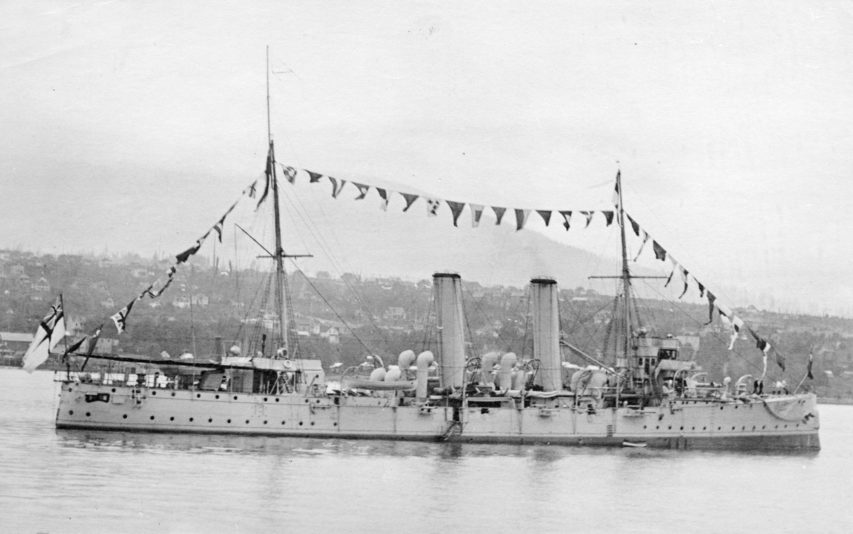
HMCS Rainbow at North Vancouver, 1910.
Photo from the City of Vancouver Library, the collection of Matthews, James Skitt, Major (1878-1970) via Wikimedia Commons.
The First World War saw the modest beginnings of the Canadian Navy, although it should be pointed out that many more Canadians chose to serve in the Royal Navy than the Canadian one, some as officers.
The inter-war years saw very little growth for the RCN. The post-war drawdown naturally occurred, and by 1922 the service had only 366 men and had paid off their only remaining cruiser. The Naval Volunteer Reserve was firmly established in Canadian cities across the country (and numbered around 1,000 men) but the Navy itself only kept two destroyers donated by the Royal Navy in service [HMCS Patriot and HMCS Patrician], until these were replaced by two more destroyers in the late 1920s (once again, ex-RN [ships renamed as HMCS Champlain and HMCS Vancouver]). 1931 saw a major facelift with the first ships built specifically for the RCN: HMCS Skeena and HMCS Saguenay.
The early 1930s saw the Navy along with the other Canadian service branches almost completely starved of funding, although by the late 30s, escalating world tension convinced the Canadian government to slowly begin rebuilding. Two more destroyers were purchased from the Royal Navy in 1937 (HMCS Fraser and HMCS St Laurent) and then two more in 1938 (HMCS Ottawa and HMCS Restigouche).
Marc Milner outlines the RCN’s original expansion plans in North Atlantic Run:
In January 1939 the government, reacting to the Munich crisis, announced its intentions to proceed with building a fleet capable defending Canada’s two coasts. The expansion plan, when completed, would give the RCN a strength of eighteen modern destroyers, sixteen minesweepers, and eight anti-submarine vessels, the numbers split evenly between Pacific and Atlantic commands, and a flotilla of eight motor torpedo boats for the east coast. Not surprisingly, little came of this plan before war broke out. In fact, by May the government had sharply cut the navy’s estimates. The 1939 building program (four anti-submarine vessels and two motor torpedo boats) was scrapped, and there was just enough money left to acquire the necessary plans. It is, however, significant that the RCN’s expansion plans were laid down in the last days of peace. Later developments would thrust a new form of expansion on the RCN, one more easily attainable in wartime than a fleet of destroyers, yet one which did not conform to the long-term goals of the professional navy.
Thus, by the outbreak of the Second World War in September 1939, the RCN consisted of six River-class destroyers, five minesweepers, and two small training vessels.
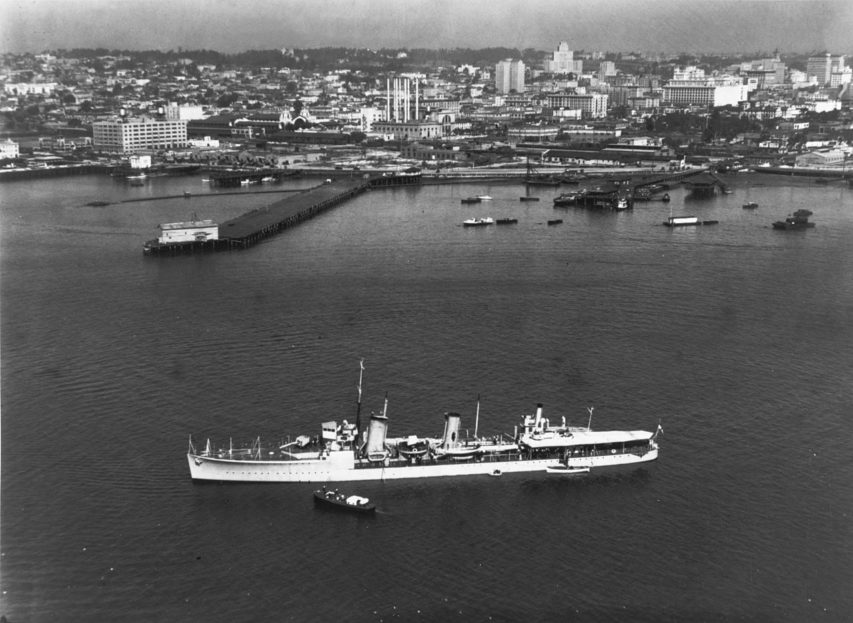
HMCS Vancouver (F6A) anchored off San Diego, California (USA), on 5 March 1929.
Official U.S. Navy photo 80-G-416377 from the U.S. Navy Naval History and Heritage Command, via Wikimedia Commons.
The January 1939 expansion plan belied the fact that the RCN was a traditional, gun-oriented navy. The experiences of the First World War and technological developments since had confirmed the sanctity of the gun as the pre-eminent naval weapon. Admittedly, the threat from Germany’s U-boats in 1917 had been grave. But her indiscriminate use of the submarine had brought the United States into the conflict on the Allied side and (or so it seemed) therefore cost Germany the war. It was felt that in future no nation would risk the sanction of a world coalition by resorting to “piracy” on the high seas. But even if Germany, or any other nation, turned once again to unrestricted submarine warfare on merchant shipping, the means of defeating the threat was already in service with Commonwealth navies — convoy and ASDIC.
During the First World War, before the adoption of the convoy system, German U-Boats preferred to use their deck guns to destroy lone merchant vessels, using their precious torpedoes sparingly. With the introduction of the convoy system, the days of easy targets vanished and the proximity of naval escort forced the U-Boat to either risk fighting an unequal surface battle against more heavily gunned escorts or to operate submerged. Convoys made the oceanic routes much safer, but this success was not unmixed. Cargo ships continued to sail independently and unescorted to and from convoy assembly ports in British coastal waters, and the U-boats resorted to submerged attack tactics inshore. Although Britain was never again threatened with defeat by starvation, losses to merchant shipping remained high for the rest of the war because of the virtual immunity of a submerged submarine to any threat of effective counter-attack by escort ships.
With the U-Boats relegated to nuisance status through the use of convoys, their final telling defeat simply awaited the perfection of a reliable underwater-detection device. The Allied Submarine Detection Investigation Committee was established in 1918 to resolve this problem, but it was not until the early twenties that an effective underwater sound locating and ranging set (now called sonar) was in use. ASDIC, as the British called the device, was to spell the doom of the submarine. As late as 1936 the First Sea Lord [the professional head of the Royal Navy], Admiral A.E.M. Chatfield, claimed that the RN’s anti-submarine measures were 80% effective. With location no longer a problem, it was believed that destruction of a submarine by a few well-placed depth charges would follow with equal certainty.
…
If anything, Canadian planners, like those elsewhere, were absorbed by the unknown dangers of air attack on trade (particularly on convoys) and by the very real threat of powerful enemy surface raiders. Both of these also presented Canada with the only real threat of direct enemy action. The RCN was therefore charged with defence against surface and air attacks on Canada and on trade in adjacent waters — the two were really inseparable. The “forms and scales of attack to which Canada would be subject,” as anticipated in 1939, reflected the preoccupation with surface and air threats. Bombardment by a single battleship and/or one or two large cruisers, by armed merchant cruisers (AMCs), or even by heavily gunned submarines was felt likely. Attacks could also be expected in the form of MTBs launched from larger ships, mines, small assault parties, or aircraft carrying torpedoes, bombs, or gas. Indeed, it was thought that aircraft launched from remote points along the Canadian coast might penetrate as far inland as Toronto. Certainly, the major coastal centres were in danger of quick and unexpected raids.
The expansion plan of January 1939 was naturally intended to counter these threats. To make good its intentions, the navy hoped to acquire the most powerful destroyers then in service, the Tribal-class. The Tribal’s high speed and heavy armament (eight 4.7-inch guns and four torpedo tubes) made it a veritable “pocket” cruiser, and several acting in concert posed a credible threat to a lone battleship. Not surprisingly, the RCN would pursue its intention to acquire Tribals throughout the entirety of the war, eventually absorbing dockyard space, resources, and trained manpower which could have been better used to maintain the escort fleet.
[Editor’s Note: On the other hand, had they not pursued a Tribal-class building program, the RCN might well have suffered a similar or even worse drawdown after the war as it did in 1919-22.]
On the eve of the Second World War the submarine was therefore considered by the RN to be a manageable problem. The same held true in the RCN. In a pre-war analysis of the threats to trade and possible countermeasures, Commodore Nelles summarized Canadian reaction to the submarine:
If international law is complied with, Submarine attack should not prove serious. If unrestricted warfare is again resorted to, the means of combating Submarines are considered to have so advanced that by employing a system of of convoy and utilizing Air Forces, losses of Submarines would be very heavy and might compel the enemy to give up this form of attack.
Nelles went on to point out that the RCN would provide anti-submarine equipment and mines “for prosecution of offensive measures against submarine attack.” His choice of words illustrates clearly the thinking of naval contemporaries on how best to deal with submarines — offensive action. The countermeasures outlined by the CNS indicated that some lessons had been drawn from the previous war, and in the long term the combination of convoy, air power, and aggressive anti-submarine warfare proved more than a match for the U-boats. Unfortunately, Britain and her allies lacked the necessary means for a very long time, and the resilience of modern submarines proved a surprise to virtually everyone.
November 12, 2018
German U-Boat Line-Thrower Rifle Conversions
Forgotten Weapons
Published on 21 Oct 2018https://www.forgottenweapons.com/germ…
http://www.patreon.com/ForgottenWeapons
These two Gewehr 98 rifles were converted by the Mauser factory to be used as naval line-throwing rifles. The exact nature of the line and lead projectiles is not clear, but they are clearly original military conversions and came form the Geoffrey Sturgess collection. Entirely new stocks were made for these guns, with a substantially increased length of pull to mitigate the harsh recoil of line throwing. The magazines were blocked with wooden plugs, allowing only one short (blank) round to be held, but allowing that round to be depressed enough to close the rifle’s bolt over it and keep the chamber empty. The barrels were replaced with launch tubes, on 10 inches long with a 2 inch bore and the other 10.5 inches long with a 1.75 inch bore.
Contact:
Forgotten Weapons
PO Box 87647
Tucson, AZ 85754If you enjoy Forgotten Weapons, check out its sister channel, InRangeTV! http://www.youtube.com/InRangeTVShow

